



Jonas Lund’s artistic practice revolves around the mechanisms that constitute contemporary art production, its market and the established ‘art worlds’. Using a wide variety of media, combining software-based works with performance, installation, video, photography and sculptures, he produces works that have an underlying foundation in writing code. By approaching art world systems from a programmatic point of view, the work engages through a criticality largely informed by algorithms and ‘big data’.
It’s been just over a year since Lund began his projects that attempt to redefine the commercial art world, because according to him, ‘the art market is, compared to other markets, largely unregulated, the sales are at the whim of collectors and the price points follows an odd combination of demand, supply and peer inspired hype’. Starting with The Paintshop.biz (2012) that showed the effects of collaborative efforts and ranking algorithms, the projects moved closer and closer to reveal the mechanisms that constitute contemporary art production, its market and the creation of an established ‘art world’. Its current peak was the solo exhibition The Fear Of Missing Out, presented at MAMA in Rotterdam.
Annet Dekker: The Fear Of Missing Out (FOMO) proposes that it is possible to be one step ahead of the art world by using well-crafted algorithms and computational logic. Can you explain how this works?
Jonas Lund The underlying motivation for the work is treating art worlds as networked based systems. The exhibition The Fear Of Missing Out spawned from my previous work The Top 100 Highest Ranked Curators In The World, for which I assembled a comprehensive database on the bigger parts of the art world using sources such as Artfacts, Mutaul Art, Artsy and e-flux. The database consists of artists, curators, exhibitions, galleries, institutions, art works and auction results. At the moment it has over four million rows of information. With this amount of information – ‘big data’ – the database has the potential to reveal the hidden and unfamiliar behaviour of the art world by exploring the art world as any other network of connected nodes, as a systemic solution to problematics of abstraction.

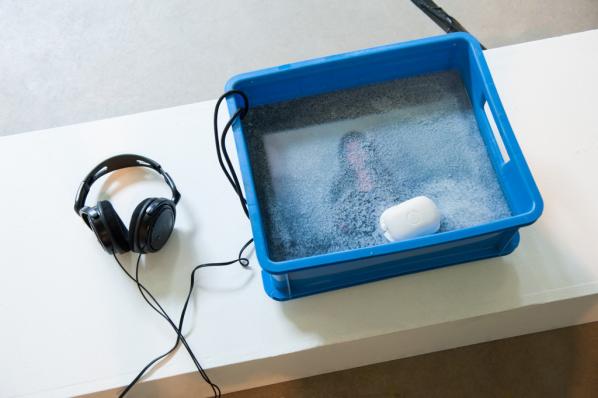
In The Top 100 Highest Ranked Curators In The World, first exhibited at Tent in Rotterdam, I wrote a curatorial ranking algorithm and used the database, to examine the underlying stratified network of artists and curators within art institutions and exhibition making: the algorithm determined who were among the most important and influential players in the art world. Presented as a photographic series of portraits, the work functions both as a summary of the increasingly important role of the curator in exhibition making, as an introduction to the larger art world database and as a guide for young up and coming artists for who to look out for at the openings.
Central to the art world network of different players lies arts production, this is where FOMO comes is. In FOMO, I used the same database as the basis for an algorithm that generated instructions for producing the most optimal artworks for the size of the Showroom MAMA exhibition space in Rotterdam while taking into account the allotted production budget. Prints, sculptures, installations and photographs were all produced at the whim of the given instructions. The algorithm used meta- data from over one hundred thousand art works and ranked them based on complexity. A subset of these art works were then used, based on the premise that a successful work of art has a high price, high aesthetic value but low production cost and complexity, to create instructions deciding title, material, dimensions, price, colour palette and position within the exhibition space.
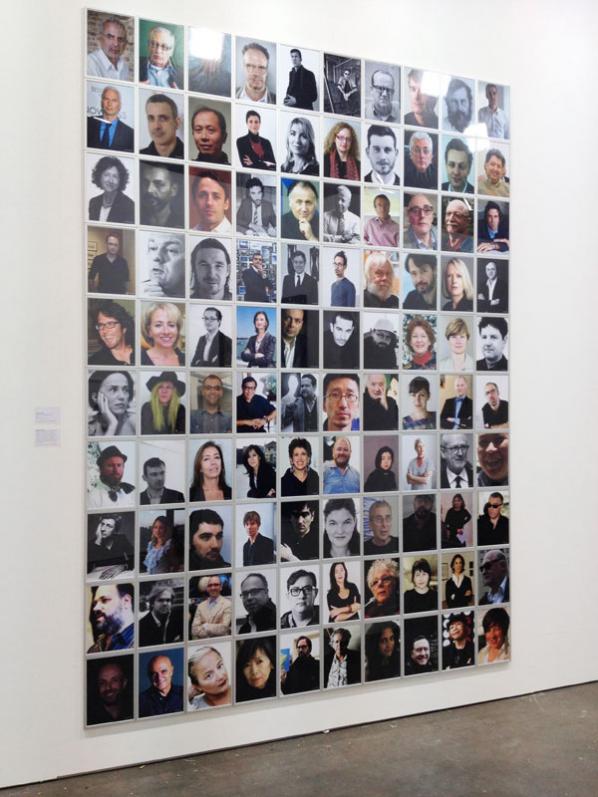
Similar to how we’re becoming puppets to the big data social media companies, so I became a slave of the instructions and executed them without hesitation. FOMO proposes that it is possible to be one step ahead of the art world by using well-crafted algorithms and computational logic and questions notions of authenticity and authorship.
AD: To briefly go into one of the works, in an interview you mention Shield Whitechapel Isn’t Scoop – a rope stretched vertically from ceiling to floor and printed with red and yellow ink – as a ‘really great piece’, can you elaborate a little bit? Why is this to you a great piece, which, according to your statement in the same interview, you would not have made if it weren’t the outcome of your analysis?
JL: Coming from a ‘net art’ background, most of the previous works I have made can be simplified and summarised in a couple of sentences in how they work and operate. Obviously this doesn’t exclude further conversation or discourse, but I feel that there is a specificity of working and making with code that is pretty far from let’s say, abstract paintings. Since the execution of each piece is based on the instructions generated by the algorithm the results can be very surprising.
The rope piece to me was striking because as soon as I saw it in finished form, I was attracted to it, but I couldn’t directly explain why. Rather than just being a cold-hearted production assistant performing the instructions, the rope piece offered a surprise aha moment, where once it was finished I could see an array of possibilities and interpretations for the piece. Was the aha moment because of its aesthetic value or rather for the symbolism of climbing the rope higher, as a sort of contemporary art response to ‘We Started From The Bottom Now We’re Here’. My surprise and affection for the piece functions as a counterweight to the notion of objective cold big data. Sometimes you just have to trust the instructionally inspired artistic instinct and roll with it, so I guess in that way maybe now it is not that different from let’s say, abstract painting.
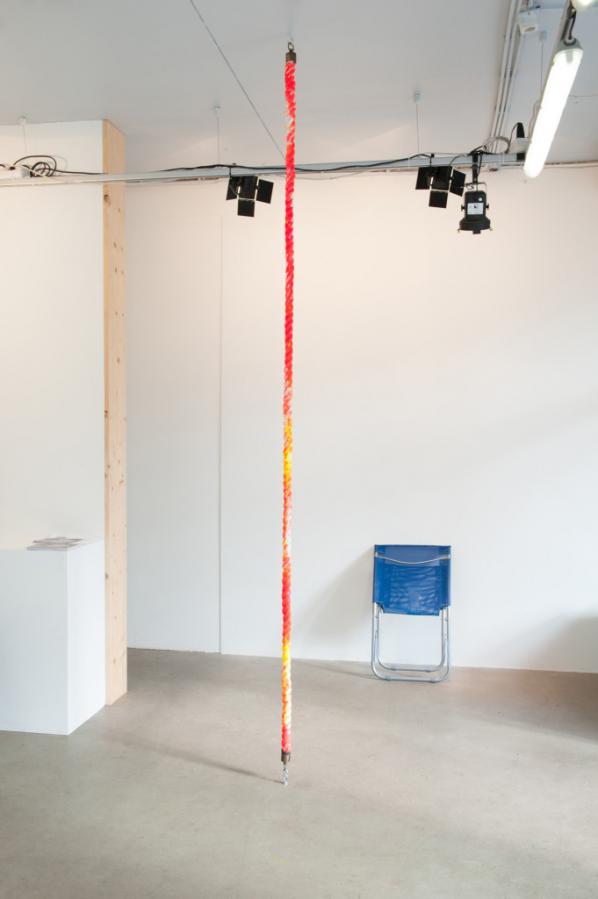
AD: I can imagine quite a few people would be interested in using this type of predictive computation. But since you’re basing yourself on existing data in what way does it predict the future, is it not more a confirmation of the present?
JL: One of the only ways we have in order to make predictions is by looking at the past. Through detecting certain patterns and movements it is possible to glean what will happen next. Very simplified, say that artist A was part of exhibition A at institution A working with curator A in 2012 and then in 2014 part of exhibition B at institution B working with curator A. Then say that artist B participates in exhibition B in 2013 working with curator A at institution A, based on this simplified pattern analysis, artist B would participate in exhibition C at institution B working with curator A. Simple right?
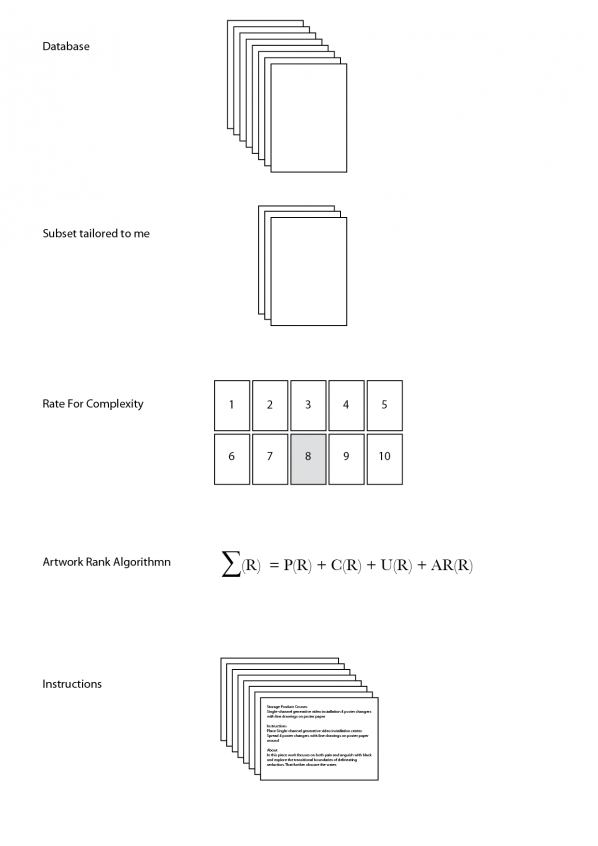
AD: In the press release it states that you worked closely with Showroom MAMA’s curator Gerben Willers. How did that relation give shape or influenced the outcome? And in what way has he, as a curator, influenced the project?
JL: We first started having a conversation about doing a show in the Summer of 2012, and for the following year we met up a couple of times and discussed what would be an interesting and fitting show for MAMA. In the beginning of 2013 I started working with art world databases, Gerben and I were making our own top lists and speculative exhibitions for the future. Indirectly, the conversations led to the FOMO exhibition. During the two production phases, Gerben and his team were immensely helpful in executing the instructions.
AD: Notion of authorship and originality have been contested over the years, and within digital and networked – especially open source – practices they underwent a real transformation in which it has been argued that authorship and originality still exist but are differently defined. How do see authorship and originality in relation to your work, i.e. where do they reside; is it the writing of the code, the translation of the results, the making and exhibiting of the works, or the documentation of them?
JL: I think it depends on what work we are discussing, but in relation to FOMO I see the whole piece, from start to finish as the residing place of the work. It is not the first time someone makes works based on instructions, for example Sol LeWitt, nor the first time someone uses optimisation ideas or ‘most cliché’ art works as a subject. However, this might be first time someone has done it in the way I did with FOMO, so the whole package becomes the piece. The database, the algorithm, the instructions, the execution, the production and the documentation and the presentation of the ideas. That is not to say I claim any type of ownership or copyright of these ideas or approaches, but maybe I should.
AD: Perhaps I can also rephrase my earlier question regarding the role of the curator: in what way do you think the ‘physical’ curator or artist influences the kind of artworks that come out? In other words, earlier instructions based artworks, like indeed Sol LeWitt’s artworks, were very calculated, there was little left to the imagination of the next ‘executor’. Looking into the future, what would be a remake of FOMO: would someone execute again the algorithms or try to remake the objects that you created (from the algorithm)?
JL: In the case with FOMO the instructions are not specific but rather points out materials, and how to roughly put it together by position and dimensions, so most of the work is left up to the executor of said instructions. It would not make any sense to re-use these instructions as they were specifically tailored towards me exhibiting at Showroom MAMA in September/October 2013, so in contrast to LeWitt’s instructions, what is left and can travel on, besides the executions, is the way the instructions were constructed by the algorithm.
AD: Your project could easily be discarded as confirming instead of critiquing the established art world – this is reinforced since you recently attached yourself to a commercial gallery. In what way is a political statement important to you, or not? And how is that (or not) manifested most prominently?
JL: I don’t think the critique of the art world is necessarily coming from me. It seems like that is how what I’m doing is naturally interpreted. I’m showing correlations between materials and people, I’ve never made any statement about why those correlations exist or judging the fact that those correlations exist at all. I recently tweeted, ‘There are three types of lies: lies, damned lies and Big Data’, anachronistically paraphrasing Mark Twain’s distrust for the establishment and the reliance on numbers for making informed decisions (my addition to his quote). Big data, algorithms, quantification, optimisation… It is one way of looking at things and people; right now it seems to be the dominant way people want to look at the world. When you see that something deemed so mysterious as the art world or art in general has some type of structural logic or pattern behind it, any critical person would wonder about the causality of that structure, I guess that is why it is naturally interpreted as an institutional critique. So, by exploring the art world, the market and art production through the lens of algorithms and big data I aim to question the way we operate within these systems and what effects and affects this has on art, and perhaps even propose a better system.
AD: How did people react to the project? What (if any) reactions did you receive from the traditional artworld on the project?
JL: Most interesting reactions usually take place on the comment sections of a couple of websites that published the piece, in particular Huffington Post’s article ‘Controversial New Project Uses Algorithm To Predict Art’. Some of my favourite responses are:
‘i guess my tax dollars are going to pay this persons living wages?’
‘Pure B.S. ……..when everything is art then there is no art’
‘As an artist – I have no words for this.’
‘Sounds like a great way to sacrifice your integrity.’
‘Wanna bet this genius is under 30 and has never heard of algorithmic composition or applying stochastic techniques to art production?’
‘Or, for a fun change of pace, you could try doing something because you have a real talent for it, on your own.’
AD: Even though the project is very computational driven, as you explain the human aspects is just as important. A relation to performance art seems obvious, something that is also present in some of your other works most notably Selfsurfing (2012) where people over a 24 hour period could watch you browsing the World Wide Web, and Public Access Me (2013), an extension of Selfsurfing where people when logged in could see all your online ‘traffic’. A project that recalls earlier projects like Eva & Franco Mattes’ Life Sharing (2000). In what way does your project add to this and/or other examples from the past?

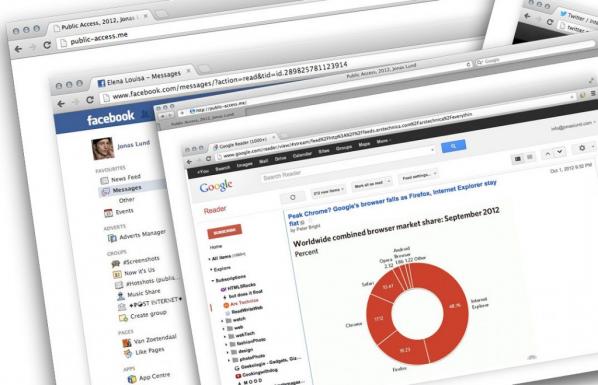
JL: Web technology changes rapidly and what is possible today wasn’t possible last year and while most art forms are rather static and change slowly, net art in particular has a context that’s changing on a weekly basis, whether there is a new service popping up changing how we communicate with each other or a revaluation that the NSA or GCHQ has been listening in on even more facets of our personal lives. As the web changes, we change how we relate to it and operate within it. Public Access Me and Selfsufing are looking at a very specific place within our browsing behaviour and breaks out of the predefined format that has been made up for us.
There are many works within this category of privacy sharing, from Kyle McDonalds’ live tweeter, to Johannes P Osterhoff’s iPhone Live and Eva & Franco Mattes’ earlier work as you mentioned. While I cannot speak for the others, I interpret it as an exploration of a similar idea where you open up a private part of your daily routine to re-evaluate what is private, what privacy means, how we are effected by surrendering it and maybe even simultaneously trying to retain or maintain some sense of intimacy. Post-Snowden, I think this is something we will see a lot more of in various forms.
AD: Is your new piece Disassociated Press, following the 1970s algorithm that generated text based on existing texts, a next step in this process? Why is this specific algorithm of the 70s important now?

JL: Central to the art world lies e-flux, the hugely popular art newsletter where a post can cost up to one thousand dollars. While spending your institution’s money you better sound really smart and using a highly complicated language helps. Through the course of thousands of press releases, exhibition descriptions, artist proposals and curatorial statements a typical art language has emerged. This language functions as a way to keep outsiders out, but also as a justification for everything that is art.
Disassociated Press is partly using the Dissociated Press algorithm developed in 1972, first associated with the Emacs implementation. By choosing a n-gram of predefined length and consequently looking for occurrences of these words within the n-gram in a body of text, new text is generated that at first sight seems to belong together but doesn’t really convey a message beyond its own creation. It is a summary of the current situation of press releases in the international English art language perhaps, as a press release in its purest form. So, Disassociated Press creates new press releases to highlight the absurdity in how we talk and write about art. If a scrambled press release sounds just like normal art talk then clearly something is wrong, right?
Eva Kekou met Tobias Rosenberger at the international e-MobiLArt workshop which took place in Athens, Vienna and Rovaniemi, in turn these led to a number of exhibitions and successful collaborations between artists and theorists. She now invites him to discuss his work, issues of surveillance and how a young European artist views the situation in China and what he expects from his interaction with the Chinese art scene.
Tobias Rosenberger (b. 1980) is a German media artist who works at the crossroads of media art, visual arts, and performance. He has produced art works in Yemen, Spain, Mexico, India, and Ukraine etc. Since 2011 he has been based in China, where he teaches at the College of New Media Art, Shanghai Institute of Visual Art.
“Nowadays, anyone who wants to combat lies and ignorance and to write the truth must overcome at least five difficulties. He must have the courage to write the truth when it is suppressed everywhere; the wisdom to recognize it, although it is concealed everywhere; the skill to use it as a weapon; the judgment to choose those in whose hands it will be effective; and the cunning to spread the truth among such people.” (Bertolt Brecht)
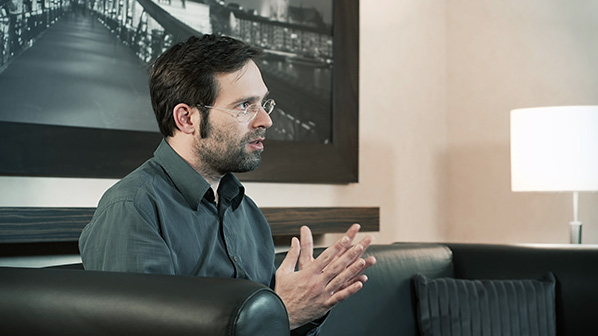
Eva Kekou: I would like to start this interview with this quote which seems to be significant for your work and in particular the recent one – the secret race film and discussion at Goethe Institut Washington. As you well state in your event invite: “It was pure coincidence that for a few days in the summer of 2013, two unrelated events simultaneously dominated the major headlines in the German press: the monitoring and spying scandal of 2013, triggered by Edward Snowden’s leaks of National Security Agency top-secret classified documents, and the official acknowledgement of the prevalence of doping in competitive sports, best symbolized by Lance Armstrong’s televised confession.” What is the significance of surveillance in a globalized social and political context and where is the place of art within it? There are obvious reasons you decided to launch this in Washington through Goethe but I would like you to comment on this.
Tobias Rosenberger: Surveillance and espionage are as old as civilization. Power was always constructed, maintained, and expanded through monitoring, categorising, repressing, and excluding people. We all know that the digital apparatus opens a new world of possibilities to organize, quantify and control life and society in a before unknown scale, speed and efficiency. While I agree that we need early warning models to anticipate and fight cruelty and injustice whenever possible, I don’t believe that we can draw a sharp border between an evil surveillance that fuels unfair and inhuman systems and a necessary one that pretends to save dignity and a lawful order. The challenges of our time can no longer be met by elitism and secretiveness, but require the joint efforts from the middle of society. An independent art that rejects the simple desire for (self-)confirmation does not only open a non-biased discursive space for critical reflection, but it also has the potential to demask and break the mechanisms of power, as long as it takes its audience seriously. But to be able to do so, art also has to find its audience.
EK: It occurs to me that place and space play a very important role in your work and inspiration. How do these relate with each other with pieces of your work in a globalized and mobile network underlined by politics?
TR: I have a very pragmatic approach to what I am trying to do: Not following a specific agenda and always staying as curious and open as possible. This requires both a certain naivety and an observing attitude. I never start an artistic process with a specific idea or question, but i get attracted by places and spaces that i try to discover without too much of my personal baggage. But since space and place are never abstract but segmented by politics both on macro and micro layers, the resulting works often deal with political questions.
EK: How did you become interested in China and what do you find fascinating or difficult working there? Is it interesting for you as a European?
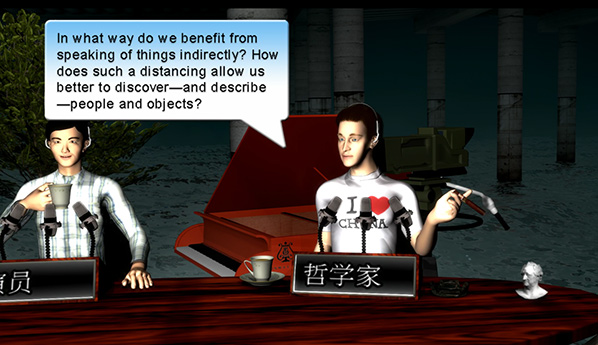
TR: I have a very special relationship to China. With my Chinese wife I decided three years ago to move there and to found a family. I was always fascinated by China as a cultural space, with a tradition of art and philosophy at least as long as in Europe. I also really like the food and the people there. As a foreigner I experience it as very fruitful to see things from a specific distance, both if I try to understand the culture, but also especially if I look back from there to where I come from. It is very interesting to observe the relation between art and politics, how the government here really appreciates art and how it is also afraid of it.

How artists, critics and curators fight for free space, a career, or both. In Shanghai you have both the global economy and the local life at your house-door. The country faces a lot of problems, and very often one can get the impression that things are not happening at all just because there is a small possibility that something unexpected could happen. So many people behave very pro-actively in a way that they won’t run into any problems themselves. But this maxim “to have everything running smooth” you certainly don’t only encounter in China.
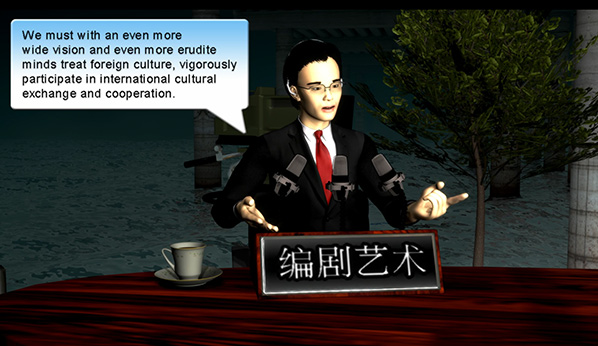
EK: Referring to some of your recent works (installation and performance): Choose any you like… How do you reach out to audiences and what is the main aim in your own work?
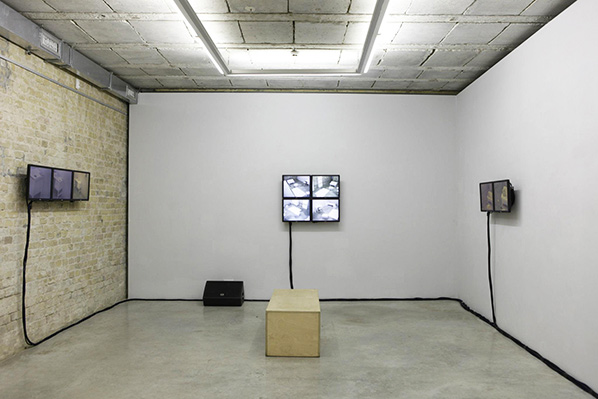
TR: “The First Twenty Years” is an installation that was shown in two different versions at the end of 2012 in Kiev and Dnipropetrovsk. I developed the basic idea for that work in 2011, when I was invited to spend some time in a small Ukrainian village near Kiev at a private artist residency programme. During that time the nation celebrated the 20th anniversary of its independence. There was a strange, partly paralyzed mood. But I also witnessed very controversial discussions with artists, curators and critics, and a new generation that seemed not anymore willing to accept living in a nation that was more and more perceived as a prison. So when I was approached during that time to do a work based on my experiences in the Ukraine, I decided to base it on Xavier de Maistres “Journey around my room” and Schuberts Music, which was inspired by a poem by Christian Friedrich Daniel Schubart.

I didn’t intent to comment directly on the situation there, but rather was trying to understand for myself what was happening. For me, art is not about expression but about the creation of a space where everybody is invited to take a bit of distance so to be able discover something from different perspectives and to think in his/her own way.
Surveillance Cameras dancing to Schubert, on Vimeo
EK: Can you give us a bit more information about a project that you have described alsewhere in the following way: “Right now working on a light sculpture for permanent setup in a former WWII Top secret military site, where some crazy NS-Germany scientist wanted to invent an x-ray wonder-weapon to shoot planes and soldiers, this involves an always transforming multichannel-sound installation, motorized miniatures (arduino-controlled), 2 projectors and led-objects. I will make an extra independent video of this work, filmed with multiple moving surveillance cams.”?
TR: I was approached by a cultural initiative that runs today a small history museum in a former research bunker, which was secretly constructed in 1942 / 1943 underneath a camouflage building. I came across a letter in which a certain Professor, Dr. Ernst Schiebold, proposed “An additional weapon to fight and eliminate the crews of hostile airplanes and ground troops in the defensive via x-ray and electron radiation”.
A weird ten pages male war fantasy about a new kind of tubular x-ray canon, written in a crude mixture of physical pseudo-science, soft patriotic enthusiasm and German pedantism. Schiebold really got his bunker built to start with his research. Everything was kept top secret, but stopped 18 months later without results. I decided to bring Schiebold’s proposal back into the space which only existed because of it: As a pure proposal, enhanced and communicated with new media technology.
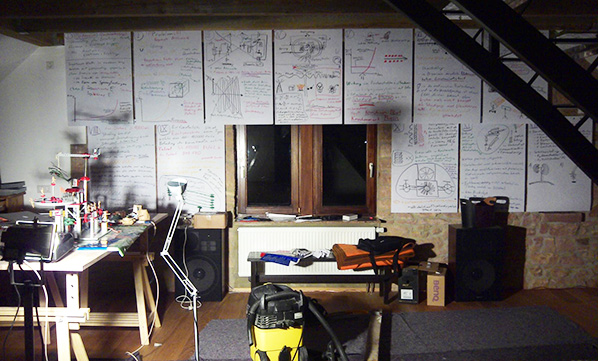
A lot of the tools that we are using as new media artists exist mainly through military development. So my intention was also to give something back. The audience will listen to single sentences that are randomly taken out of Schiebold’s letter and re-arranged into a constantly transforming synthetic sound atmosphere, which is synchronized with light beams crossing a motorized miniature military model. The toy miniatures cast shadows of moving soldiers and airplanes onto the walls. LED lights are flashing out of a tubular manhole, which was originally constructed to be used with a Betatron. All the technology that I use is quite low-budget and geeky. Last week I started to install the parts on site, and I have to admit that it is also a very weird experience for me to spend nights working alone in a former military research bunker, climbing down in a manhole and setting up the mockup of a “super-weapon” people researched in the darkest years of German history. Sure I will also try to document it properly.
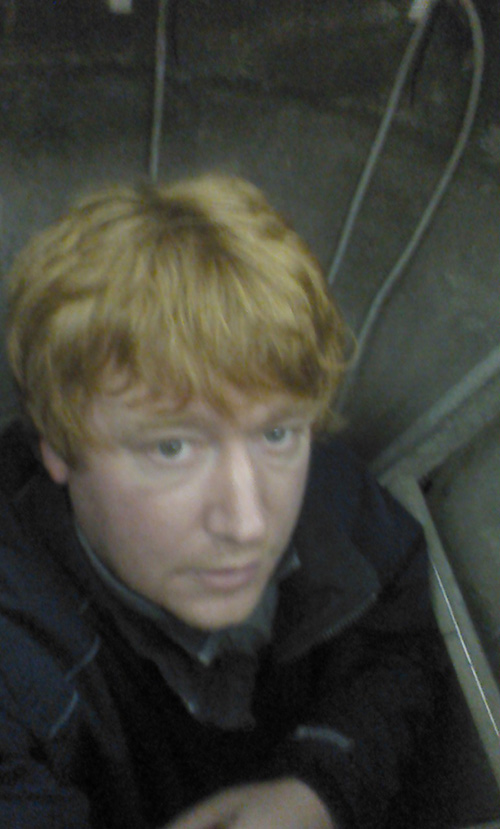
EK: Do you think art can be global and political, if not, what are the main restrictions we are all subjected to? How can art and artists make a difference in this respect?
TR: I think that art is per se political, since it deals with and also influences our perception of reality. And while all our lives are clearly connected in a global economy of good and information-exchange, art does also always operate on a global scale. As an artist I believe that it is worth to be curious and to investigate the (media) apparatuses and dispositifs that surround us, to take them apart and re-design them. What are they good for, what effects do they cause? While the world is getting closer, the world is never the same – people have different histories, problems, possibilities and hopes. As Europeans we take many things for granted, that other people see differently – or vice versa. I think artists can always make a difference, as long as they stay independent and continue to tackle serious questions, but don’t take themselves too seriously while doing so. We should laugh more together.
EK: What are your future aims and plans?
TR: I am looking forward to the new semester in Shanghai, where I will mentor the graduate works of eight students. I will also collaborate with Chinese artist Mujin (Lixin Bao) – a fellow teacher at the Shanghai Institute of Visual Art – on a series of works exploring the notion of the “Chinese Dream” and its perception both nationally and globally. I guess this dialogue will become quite interesting.
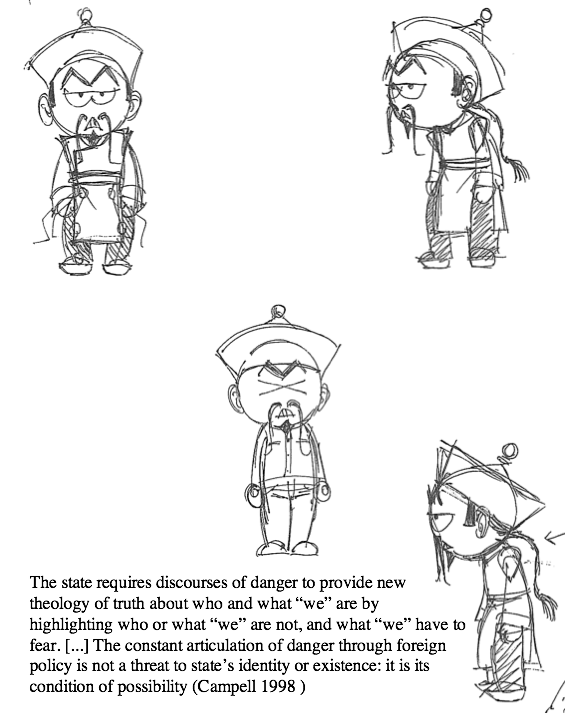
Featured image: Mari Velonaki, “The Woman and The Snowman”. Responsive installation incorporating autokinetic robotic sculpture (2013).
I first met Mari Velonaki in person a couple of years ago and since then have attended one of her lectures. I was impressed by her work as a cross-disciplinary arts-led researcher. Also, her imaginative approach in her art practice which spans across interactive installations, robotics and kinetic sculpture and human-robot interaction. This interview is an opportunity for readers to find out more about the ideas and the contexts behind her work, including plans, dreams and also what is happening in Sydney Australia, where she is based.
Eva Kekou: I am fascinated by the project Fish-Bird, it operates as a metaphor for me to connect and relate two different notions in the most poetic way as in the case of art, science and technology. Could you please give us some information about the idea of this project and both its artistic and research views – also how audiences responded to this.
Mari Velonaki: “Fish-Bird” is an interactive autokinetic artwork that investigates the dialogical possibilities between two robots, in the form of wheelchairs, that can communicate with each other and with their audience through the modalities of movement and written text. The chairs write intimate letters on the floor, impersonating two characters (Fish and Bird) who fall in love but cannot be together due to “technical” difficulties. This was an interdisciplinary project that involved the creation of novel interfaces for human-robot interaction, experimentation in distributed sensory systems and robot ‘perception’.
The wheelchair was chosen as the dominant object of the installation for several reasons. A wheelchair is the ultimate kinetic object, since it self-subverts its role as a static object by having wheels. At the same time, a wheelchair is an object that suggests interaction – movement of the wheelchair needs either the effort of the person who sits in it, or of the one who assists by pushing it. A wheelchair inevitably suggests the presence or the absence of a person.
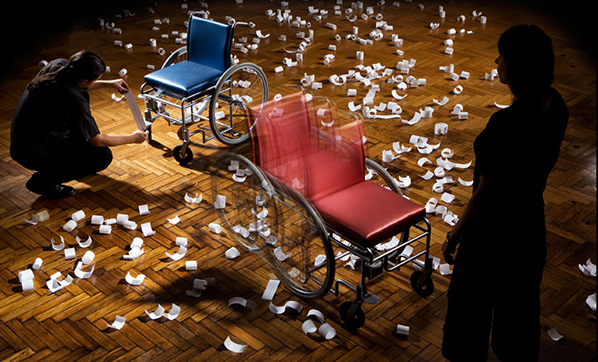
Furthermore, the wheelchair was chosen because of its relationship to the human – it is designed to almost perfectly frame and support the human body, to assist its user to achieve physical tasks that they may otherwise be unable to perform. In a similar manner, the Fish-Bird project utilizes the wheelchairs as vehicles for communication between the two characters (Fish and Bird) and their visitors. Finally, the wheelchair also possesses an aesthetic that is very different from the popular idea of a robot, as it is neither anthropomorphic nor “cute”. Given that a wheelchair is a socially charged object, the interactive behaviour and the scripting of how the chair should move was developed in consultation with wheelchair users. The participants are actively discouraged from sitting on the wheelchairs: if a participant sits on a wheelchair a sensor embedded in the seat upholstery pauses the entire system until the participant vacates the wheelchair.
What we’ve learned from the Fish-Bird project in relation to human-robot interaction, after 35,000 recorded encounters in five countries, is that behaviour is more important than appearance. Although Fish and Bird have the utilitarian appearance of an assistive device, participants were drawn to them because of the way they move and interact physically with them, and because of the handwritten style ‘personal’ messages that they print for their audience.
EK: Your project Diamandini brings up issues of femininity, interactivity into the context of computer and informatics. It again works as a nice metaphor but in practice it is a research project between the Centre for Social Robotics, Australian Centre for Field Robotics, the University of Sydney and yourself. Can you give us more information about this and also report to us about the outcome of the research project about the understanding of the physicality that is possible and acceptable between a human and a robot within a social space.
MV: The original intent of the Diamandini project was to create a robot that was non-representational and non-anthropomorphic – also, I wanted to work with the concept of one-to-one interaction: one human, one kinetic agent. As I started experimenting with a variety of abstract sculptural forms, although interesting in shape and structure, I found it extremely difficult to assign behaviours to them that could lead to emotional activation of the spectator/participant. These considerations influenced my decision to create a humanoid robot. This was a challenging decision, especially when I had to decide how the robot should look. I didn’t want Diamandini to have a typical humanoid robot aesthetic. I began to think of Diamandini as a female sculpture. In my mind Diamandini had a diachronic face that spans between centuries, a style that could be reminiscent of post-World War II fashion influences, and at the same time with futuristic undertones. Diamandini is small – only 155 cm high. I wanted her figure to be small and slender so that people didn’t feel threatened by her when she ‘floats’ in the installation space. I wanted her to look youthful, but not like a child, and for her age not to be easily identifiable. Interestingly, in my mind she is between 20 to 35 years old. Because I am a woman, I feel more comfortable working with a female rather than a male representation.
In relation to people interacting with Diamandini in social spaces, we are still processing data collected from 3,682 interactions at the Victoria & Albert Museum in 2012. From these interactions what we know so far is that, although people would spend – on average – more than five minutes with her in the Medieval and Renaissance Galley, only 88 people embraced her or held her hand. It will be interesting to compare this result with new data coming from Diamandini’s current exhibition at FACT, Liverpool, where she is exhibited in a contemporary gallery setting.
EK: You are an artist and researcher. How do you think that these two relate to each other, give feedback to each other and can give a mutual input to your work? How connected are art and research in general?
MV: I see my work as practice-led research. I’m interested in developing and testing new concepts of what an artwork can be, in the same way as I’m having conceptual and aesthetic concerns of what a robot can be. Interactive media art has a long history of looking at sharing spaces with projected and kinetic characters. I’m interested in the brief moment when a spectator becomes a participant – conceptually and physically. This is where the core of my research lies.
EK: The female character and femininity plays a crucial role in your work. How can “fragile femininity” be embraced by science and technology and its connected artwork under the light of media art?
MV: I don’t perceive my work as fragile femininity – at least consciously. Many of my characters don’t have gender: for example Fish-Bird, Fragile Balances, Current State of Affairs. If a representation of gender is necessary – as in previous works that contain projected digital characters (Pin Cushion, Unstill Life, etc.) or is a humanoid robot – I choose to work with female forms as I am more comfortable to sculpt, script and create a kinetic language for a female representation. The element of fragility, though, is a thread that links many of my works. Anne-Marie Duguet wrote a wonderful essay “The Power of Vulnerability” about my work ‘Fragile Balances’ (2008) in which she writes “’A fragile balance’ could define all complex interactive processes that involve human intervention. Interactivity always extends to the limits of more than one language, more than one reality. It relies on operations of interpretation and coding that, as a matter of course, produce slips of meaning, simplifications and omissions which can undermine the effectiveness and reciprocity of exchange, and hinder the pleasure of transgression.”

EK: I know you have exhibited in different parts of the world – how do audiences respond to your work?
MV: I guess it depends on the work. In general I think maybe I could add that I think people are attracted to my work because – although it partially depends on complex technological systems – the work itself doesn’t look at all technological. I want to believe that my audiences are attracted to my ‘characters’ maybe because of the element of surprise: a porcelain-like sculpture that moves; wheelchairs that write love letters; wooden cubes that act as embodied avatars for robotic characters.
EK: What are your next steps as an academic, artist and researcher? Which of your dreams do you want to make true through your work (relating them to art, science and technology as another metaphor)?
MV: At the moment a lot of my focus is on growing and strengthening the Creative Robotics Lab (CRL) at NIEA. I founded CRL with an aspiration to build a cross-disciplinary experimental space for human-robot interaction research and interface design. At CRL people from different disciplines – arts, robotics, psychology, philosophy – work together because they believe that, to improve human-robot interaction, a cross-disciplinarily approach is not complementary but essential. CRL for me is a safe place for risk-taking.
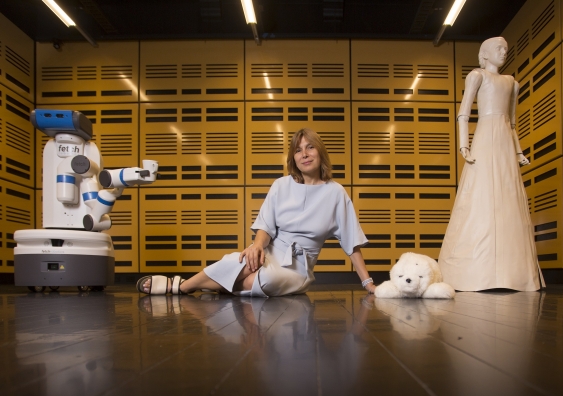
Mari Velonaki has worked as an artist and researcher in the field of interactive installation art since 1997. Mari has created interactive installations that incorporate movement, speech, touch, breath, electrostatic charge, artificial vision and robotics. In 2003 Mari’s practice expanded to robotics, when she initiated and led a major Australian Research Council art/science research project ‘Fish–Bird’ (2004-2007) in collaboration with roboticists at the Australian Centre for Field Robotics (ACFR). In 2006 she co- founded, with David Rye, the Centre for Social Robotics at ACFR, a centre dedicated to inter-disciplinary research into human-robot interaction in spaces that incorporate the general public. In 2007 Mari was awarded an Australia Council for the Arts Visual Arts Fellowship. In 2009 she was awarded an Australia Research Council Fellowship (2009–2013) for the creation of a new robotic form. In 2011 she was appointed as an Associate Professor at the National Institute of Experimental Arts (NIEA) at the College of Fine Arts, The University of New South Wales, where in 2013 she founded the Creative Robotics Lab. Mari’s artworks have been widely exhibited internationally. http://mvstudio.org/
Tatiana Bazzichelli is a researcher, networker and curator, working in the field of hacktivism and net culture. She is part of the transmediale festival team in Berlin, where she develops the reSource for transmedial culture, an ongoing distributed project of networking and research within the transmediale festival. She received a Ph.D. in Information and Media Studies from Aarhus University (DK), conducting research on disruptive art practices in the business of social media (title: Networked Disruption: Rethinking Oppositions in Art, Hacktivism and the Business of Social Networking). Bazzichelli is also a Postdoc Researcher at the Centre for Digital Cultures /Leuphana University of Lüneburg (DE).
In light of absolute domination by market forces over all of our lives, and with the top-down orientated power systems’ bias towards business and the implementation of a consumer class. New ways of thinking around the problem is called for. There has been a dramatic shift of unethical companies such as BP funding art’s and technology projects, and mainstream museums and galleries in the UK. [1] Alongside this, those hoping to receive arts funding are told to be innovative and more entrepreneurial than they already are. What they really mean by ‘innovative and entrepreneurial’ is, get in line with the values of a corporate mentality, and not be contextual or critical in one’s art practice. This wholesale move towards business as it further dominates the content, ideas, societal context, and missions by artists and art collectives – is of deep concern for all who wish to explore freedoms of expression on their own terms and not inline with the state’s or a corporation’s set of diverting agendas.
Art activism in media art and transdiscilpnary arts culture has engaged with political and societal issues while under the gaze of neoliberalism quite successfully. However, what changes have occured that we can draw upon to say we have built real alternative values for others to work with? There are plenty of people from the dark side calling us to join them, like that eirie voice from the original Evil Dead movie.

I’m reminded of Thomas Frank’s insightful words in his article TED talks are lying to you, that those who urge us to “think different” almost never do so themselves. [2] And this is the nub, what will become us if we step over into their world and adapt our minds to their visions?
“To expect or even wish those who rule and those serving them to change, and challenge their own behaviours and seriously critique their own actions is as likely as winning the National Lottery, perhaps even less.” [3] (Garrett 2013)
So, this brings us Tatiana Bazzichelli who has been thinking about this stuff a lot. Her Proposition is that we need climb out of these oppositional loops in order to find different ways of being, and refocus on potential art strategies in relation to a broken economy. In her publication Networked Disruption: Rethinking Oppositions in Art, Hacktivism and the Business of Social Networking, Bazzichelli puts forward the notion of disruptive business and it “becomes a means for describing immanent practices of hackers, artists, networkers and entrepreneurs”, and sheds “light on two different but related critical scenes: that of Californian tech culture and that of European net culture – with a specific focus on their multiple approaches towards business and political antagonism.”
Marc Garrett: In your book you examine a breadth of disruptive practices of networked art and hacking culture in California and Europe. You propose your main objective is to rethink the meaning of critical practices in art, hacktivism and social networking, analyzing them through business instead of being in opposition to it.
Could you explain how this would change situations and what it would bring to artists exploring disruption as part of their practice, networked art culture and the wider community, and what this may look like?
Tatiana Bazzichelli: I will begin answering your question by adding another one: Why do we need to rethink artistic and hacktivist oppositions in the context of social media and after the emergence of Web 2.0? This question is at the core of my book, and also the main link that connects together my previous book, Networking: The Net as Artwork (2006), and the following ones centered on the concept of networked disruption and disrupting business.
The idea of conscious participation in media practices is central to analyse the evolution and transformation of the concept of “networking” in the age of social media. My reflections are the consequence of a process of direct involvement within the activist (or rather “artivist”) scene in Italy since the mid-90s, and furthermore, they are based on the analysis of a more international fieldwork of practices between the Europen tradition of netculture, and the development of cyberculture in California. Practically all my books are to be thought of as subjective, and as consequences of a personal experience which aims to create connections between very diverse fields of action, applying the idea of networking both in theory and practice, and as a methodology of writing.
Between the end of the 1990s and the early 2000s, many actions of media criticism were often very dialectical, and rooted on the idea of antagonism as radical opposition. I am for example thinking about what was (erroneously) called “the anti-globalization movement”, the protests in Seattle, Prague, Goteborg, Genoa, etc.: somehow it was easier to identify an “enemy”, for everyone to unite against the same power. Unfortunately this also meant that it was easier to identify the members of the movement(s) themselves, and many protests faced violent chains of repression by the authorities. In particular in Genoa, the Italian movement and its global counterparts were hit hard. My personal opinion is that the frontal opposition, the idea of assaulting the “red zone” during the protests, did not work at all: we basically played the game of the police. Without dismissing this experience, which was very important in itself and for the start of new activist projects, after Genoa 2001 I started searching for a new way of activism that was not black and white, and which would be harder to appropriate. This was also the reason why I started entering in contact with many projects in the queer, pink, and independent porn culture, which were combining ludic strategies and playful disruption beyond oppositional confrontation. I was trying to connect those to the concept of hacking – mixing the codes to create disturbance, to generate subliminal interventions, to give rise to paradoxes, fakes and pranks, as previous projects based on multiple identities, from Luther Blissett to Neoism and Monty Cantsin, had done before.
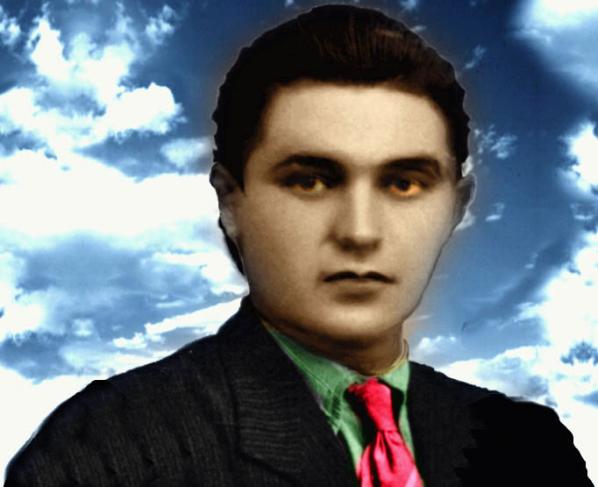
“In 1994, hundreds of European artists, activists and pranksters adopted and shared the same identity. They all called themselves Luther Blissett and set to raising hell in the cultural industry. It was a five year plan. They worked together to tell the world a great story, create a legend, give birth to a new kind of folk hero.” Luther Blissett.
But after 2004, which is also the time of the emergence of Web 2.0, the critical framework of art and hacktivism shifted: networking, a concept which had informed the Avant-garde since the 1960s, became a tool for a wider audience, and a pervasive business strategy. The ideas of openness, do it yourself, sharing, the “mottos” of the hacker culture in the 1990s, became the main rhetoric of the Web 2.0 companies based on the appropriation of “free culture”. This meant to me that also artistic and hacker practices needed to be recontextualised, since the concept of social networking became something completely different from its roots, and the business companies themselves were applying the concept of disruption as main business logic. Is it possible to oppose disruption with disruption?
In the era of immaterial economy and increasing flexibility, the act of responding with radical opposition no longer looks like an effective practice, since the risk is to simply feed the same machine replicating the capitalistic logic of competitiveness and power conflicts. In my opinion, and here I speak through my “artivist” experience, even the concept of the multitude as a model of resistance against the capitalist system – which runs at a theoretical level – is difficult to apply on a pragmatic level without having to recreate the traditional dynamics of the “power-contra power” conflict. The point is to try to figure out how to imagine new forms of participation that go beyond dualistic conflict – and that go beyond the creation of a hegemonic and holistic entity, although presented as a plural (the multitude, indeed). As a result, it is definitely necessary to reformulate the language, which enters the sphere of production and the political, as Paolo Virno states, but most of all, activists practices and critical strategies need to be rethought.
What my book Networked Disruption suggests is the act of performing within the capitalist framework, not against it, keeping the dialectic open through coexisting oppositions. The notion of disruptive business is useful for reflecting on different modalities of generating criticism, shedding light on contradictions and ambiguities both in capitalistic logics and in artistic and hacktivist strategies, while rethinking oppositional practices in the context of social networking. In this book the concept of the Art of Disrupting Business must be interpreted beyond categorical definitions, and as a new input for imagination. “Disruption” implies a multi-angled perspective and it is a two-way process, where business and the antagonism of business intertwine. Adopting a hacker’s strategy, hacktivists and artists take up the challenge of understanding how capitalism works, transforming it into a context for intervention and trying to alter business logics. Rethinking strategies and modalities of opposition implies that new forms of interventions and political awareness should be proposed without antagonising them, but rather by playing with them and disrupting them from the inside of the machine. The vision of a distributed network of practices, participations and relationships can only be fragmented, and based on multiple layers of imagination.
Today there are artists and activists who are inspired by a certain tradition of “disruption”, creating interventions from within, critically appropriating the business logics, stretching its limits, or proposing alternative models to it. Many of them are the case studies of my book, where I propose a constellation of social networking projects that challenge the notion of power and hegemony, and where social networking is not only technologically determined. Projects and experiences such as mail art, Neoism, The Church of the SubGenius, Luther Blissett, Anonymous, Anna Adamolo, Les Liens Invisibles, the Telekommunisten collective, The San Francisco Suicide Club, The Cacophony Society, the early Burning Man Festival, the NoiseBridge hackerspace, and many others. Of course there are many more of these. Holes in the system are everywhere, ready to be performed and disrupted.
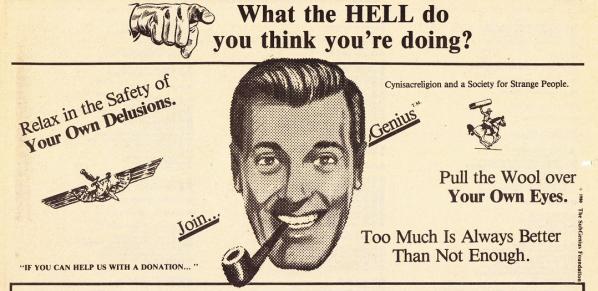
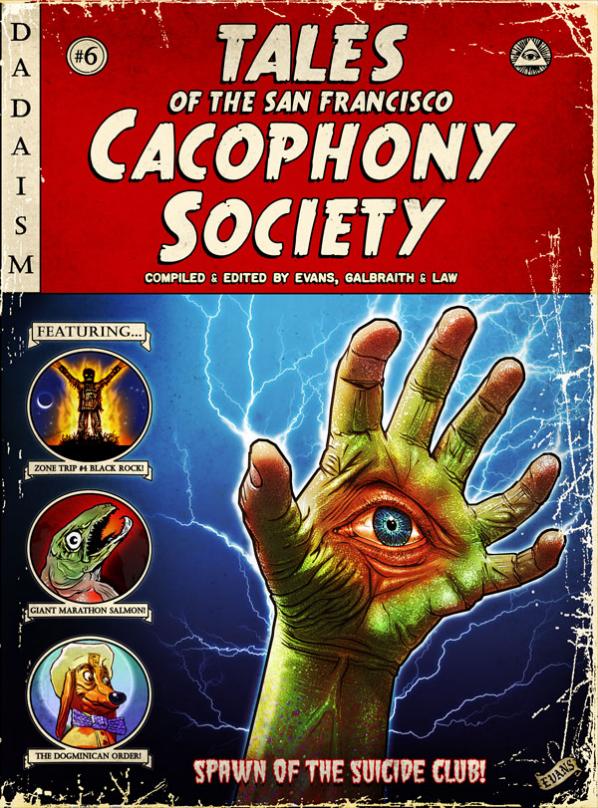
MG: There is a quote in the book that it says, “Innovation is rooted in Desire, not need. Desire is the motivation for behaviour. Desire leads to goals, and goals lead to motivation, the internal condition that gives rise to what we want to do, based on our goals, what can we do – based on the norms of behaviour – and what we will do – the actions that we voluntarily decide to undertake. Motivation is the ethos of goal-oriented behaviour, and a company’s ability to understand motivation directly contributes to the success of their products and services in the marketplace” (Manu, 2010, p. 3).
I’m wondering, coming from an activist background myself where do you think free culture fits into this dialogue, especially in respect as a critique of products and services in the marketplace, as well as social forms of emancipation?
TB: The quote you are referring to comes from a book entitled Disrupting Business: Desire, Innovation and the Re-design of Business (Alexander Manu, 2010). As we can read in the business literature, the concept of disruptive business is rooted in the idea of disruptive innovation. Disruptive innovation, a term coined in 1997 by Clayton Christensen, Professor at the Harvard Business School, is used in business contexts to describe innovations that introduces a product or service in ways that the market does not expect. In the business culture, disruption not only means rupture, but links to the idea of innovation and re-design of behavioural tendencies. Therefore performing disruption shows a process that interferes with business, whilst at the same time generating new forms of business. This mutual feedback loop is at the core of my analysis.
However in my book business is neither analysed through classical business school methodologies, nor seen as positive or negative, but it is a means for working consciously on political practices – and for raising questions on art and media criticism. In 2009 I was a visiting scholar at Stanford University where I was researching the reasons of the progressive commercialisation of networking contexts after the emergence of Web 2.0, through the development of hacker culture in the Silicon Valley. From the interviews that I conducted, and also via the close reading of the book From Counterculture to Cyberculture by Fred Turner, it was evident that since the development of the early cyberculture hackers and members of the so-called “counterculture” have been trying to disrupt business via their practices, and in parallel, business corporations have been trying to do the same through technological innovation. Since the 1960´s, hackers and artists in California have been active agents in business innovation while at the same time also undermining business. This is also very evident today in the business context of Web 2.0 where many hackers are working at the core of business, while disrupting it – the Anonymous entity is one of the most successful examples of this.
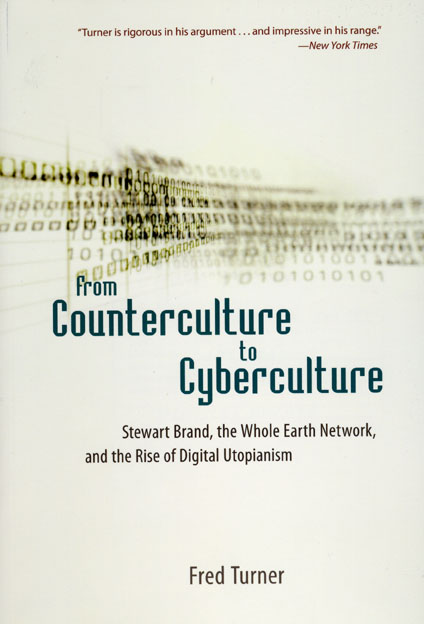
In my book I compare what the concept of business disruption meant in the European context and in the US, especially in Silicon Valley. When I was interviewing computer engineer Lee Felsenstein he told me that in California hackers would refuse hegemony but not business. This is also why many of them have no problem in working for Google, which is actually employing the best hackers of the area. In Italy we always claimed that hacking is politics, and politics is an “attitude”, which informs your everyday life and lifestyle. What I discovered in the Silicon Valley is that libertarian practices are often linked with the refusal of the political, and this is the position of many members of the hacker culture in California. Therefore, what for me was the initial “problem”, the contamination of business and free culture, was not considered as such among the hackers that I met between San Francisco and Palo Alto.

This consideration leads me to create a model of analysis named the “disruptive feedback loop”, based on the idea of layering instead of cooptation – such an idea of “layering” rather than cooptation, was proposed by Fred Turner in the lecture “The Bohemian Factory: Burning Man, Google and the Countercultural Ethos of New Media Manufacturing” (2009), while discussing the social phenomenon of Burning Man. The idea of the “mutual feedback loop” between business and hacker culture is instead the result of a conversation in 2009 with Jacob Appelbaum, who at the time was an active member of NoiseBridge in San Francisco, when we were reflecting on the development of hacker spaces in California. In my disruptive loop model, artists and hackers use disruptive techniques of networking in the framework of social media and web-based services to generate new modalities for using technology, which, in some cases, are unpredictable and critical; business enterprises apply disruption as a form of innovation to create new markets and network values, which are also often unpredictable. Networked disruption is a place where the oppositions coexist, and it is a reconfiguration of practices into a structure of mutual feedback instead of opposition.
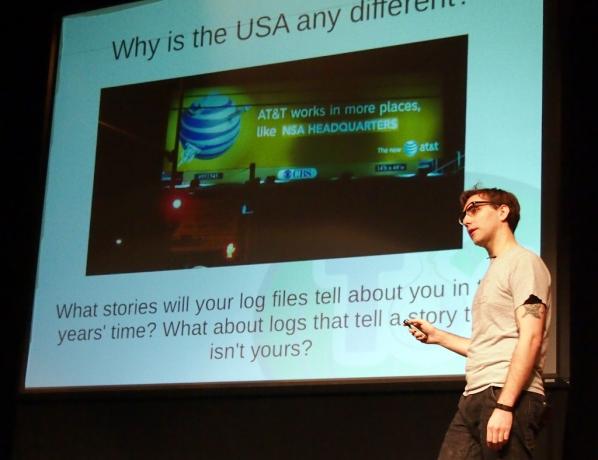
Here I propose disrupting business as an art practice: artists and hackers adopt viral and flexible strategies, as does contemporary networking business, and by provoking contradictions, paradoxes and incongruities, business logic is détourned. This model can be applied both in the analysis of business contexts of social networking and of critical practices generated by hackers and artists. For example, projects such as Anna Adamolo and Seppukoo reflect on the tensions between the open and closed nature of social media, stressing the limits of Facebook’s platform, and working on unpredictable consequences generated by a disruptive use of it. Paradoxically, to be critical of business we should learn from it.
The Telekommunisten collective explains this well, and it is not a coincidence that Dmytri Kleiner comes from a Neoist background: the experiences of Luther Blissett and Neoism made it hard to see any “truth”, they forced us to question and examine our identities. If you claim to have the truth, you will fail – someone else will proclaim the truth, and perhaps with much more strength and power than you. The Miscommunication Technologies by the Telekommunisten show that the enemy can eat you up and that the capitalist system has endlessly more resources to force its “truth” on you. We have to learn from business, understand how to be pervasive. My point is that we should stop looking for the enemy, because who is the enemy today when disruption and its opposition are feeding the same machine? The challenge is to unite where the system can’t get you, and you’re not playing into its hands, exposing contradictions, generating disturbance, to disrupt and perform the feedback loop at once. The challenge facing the art of disruptive business is to dissipate oppositions through a network of multiple, distributed, playful and disruptive practices.
MG: It was licensed under a peer Production License (http://p2pfoundation.net/Copyfarleft), similar to a Copyfarleft License (http://p2pfoundation.net/Peer_Production_License). Very different than a Creative Commons Licence, and drawn up by one of the artists you write about in the book Dmytri Kleiner. It feels relevant to be on the P2P Foundation wiki, however it would be useful know how it relates to the context of your publication?
TB: As it is stated on the P2P Foundation website, based on the text published in The Telekommunist Manifesto, “the Peer Production License is an example of the Copyfarleft type of license, in which only other commoners, cooperatives and nonprofits can share and re-use the material, but not commercial entities intent on making profit through the commons without explicit reciprocity”. The Peer Production License is a hack of the Creative Commons licenses. Where the Creative Commons is mostly used for sharing works non-commercially, the Peer Production License wants to contribute in expanding a non-capitalist economy, generating earnings that are shared equally. Commercial use is therefore encouraged for independent and collective/common-based users only, proposing a business logic that does not lead to a private appropriation of community-created value.
This logic is also at the core of the “Venture Communism” concept coined by Dmytri Kleiner in 2001, which proposes to allocate equally the collectively owned material wealth, and to create a peer-to-peer social commons as an alternative to venture capitalism.
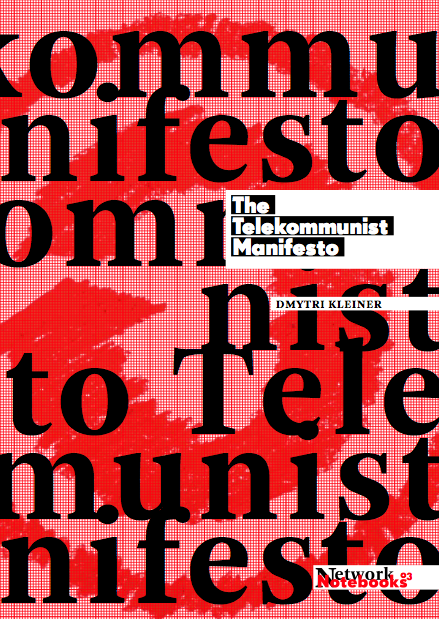
I decided to release the Networked Disruption book under this license because I consider it a coherent intellectual gesture, and also a “business experiment”. From what Dmytri told me this is the first book released under this license after the Telekommunist Manifesto, and hopefully the use of such license, if increased, will be part of poking a small hole in the capitalist economy, generating value which is not going into few owners’ pockets, but is shared equally among the workers and producers. This is also the reason why all my publications exist both online and on paper and are freely downloadable from the web, because it would be contradictory to write about certain topics and then release my toughts under proprietary licenses. In this case, since the book is about disrupting business, I decided to apply a disrupting business license, and to my point of view this is what the Peer Production License is.
Conclusion:
Bazzichelli’s investigation is a timely and necessary critique on how to free up networked forms of freedom of expression and its varied practice. At first, I was suspicious. Indeed, in a later publication on the subject co-edited by Tatiana Bazzichelli & Geoff Cox, called Disrupting Business: Art and Activism in Times of Financial Crisis; “Bifo” Berardi, in his article EMPTINESS says “Business is, in my opinion, the most despicable word in the vocabulary. Well, I will try to express it better: the meaning and implications of the word ‘business’ in contemporary culture and daily life, and the positive emphasis placed on this term, are the most telling symptoms of the abysmal alienation of our time.” On this I agree.
We are all emersed in the sea of neoliberalism and we are struggling to keep our heads above the water at various levels. Some are aware of it and are not dealing with it, most are unconscious of it and are drowning in it, and then there are those actively awake and exploring different and innovative ways to survive and hack ‘around, in between and through’ this deep totalising ocean.
Whether we like it or not, business unfortunately is the dominating regime controlling our interactions, and this includes our cultural, digital interfaces and social contexts. Bazzichelli asks us to stare into the monster’s face – what Bifo sees as a deep emptiness. She pulls out of the slimey depths a glimmer of hope and an advancement for playful and critically aware forms of artistic disruption. It is an academic and cultural hack and reminds me of Donna Haraway’s proposition in the mid 90s for Situated Knowledges. Haraway realised with other collaborators that it was a fantasy to think that the patriarch was going to somehow willingly hand over control and be enlightened to the idea that women scientists should be accepted as equal in history and academia.
“We seek not the knowledges ruled by phallogocentrism (nostalgia for the presence of the one true world) and disembodied vision. We seek those ruled by partial sight and limited voice – not partiality for its own sake but, rather, for the sake of the connections and the unexpected openings situated knowledges make possible. Situated knowledges are about communities, not isolated individuals.” [4] (Haraway 1996)
Her proposition is not suggesting that critical, ethical artists and pranksters give up and put down their tools and become business men and women instead. Using terms such as ‘disrupting business’ is not conforming or giving up the fight. It is a shift in strategy. She has successfully illustrated that there is a continual rise in imaginative experimentation where artistic hacking with the protocols, interfaces, code, data and surveillance is alive and well. It is about infiltration of these ideological defaults and the power systems that rely on them. Resistance is not futile, it is just changing direction from reliance for absolute desire (which lets face it is rarely fullfilled) from momentary tactics and momentary hacks, into informed hacking with socially aware and engaged strategies. She is asking for an intelligent response, a less macho way in dealing with the problem. This means building deeper relations with others through affinities and sharing critical knowledges while disrupting the business of neoliberalism. And most of all, carry on playing…
Featured image: Cardboard Soldier, 2009 exhibition T-Space Gallery Beijing. Joseph DeLappe.
Joseph DeLappe’s art projects have received much interest ranging from the art world, New York Times, Wired magazine, and publications such as Joystick Soldiers The Politics of Play in Military Video Games, the first anthology to examine the reciprocal relationship between militarism and video games. DeLappe is considered a pioneer of online gaming performance art. His art examines the conditions and processes of cultural information to provoke and critique the state of military influences on everyday culture and people’s lives.
DeLappe’s work includes the controversial game based, performance and intervention, Dead in Iraq 2006-2011. This involved him frequently visiting the US Army’s online recruitment game and propaganda tool America’s Army. Using the login name dead-in-iraq, he methodically typed in all of the names of U.S. service personnel killed in Iraq, co-opting the Army’s own technology challenging the official figures as a reminder to its players of the real consequences of war. He also directs the iraqimemorial.org project, an “ongoing web based exhibition and open call for proposed memorials to the many thousand of civilian casualties from the war in Iraq.”
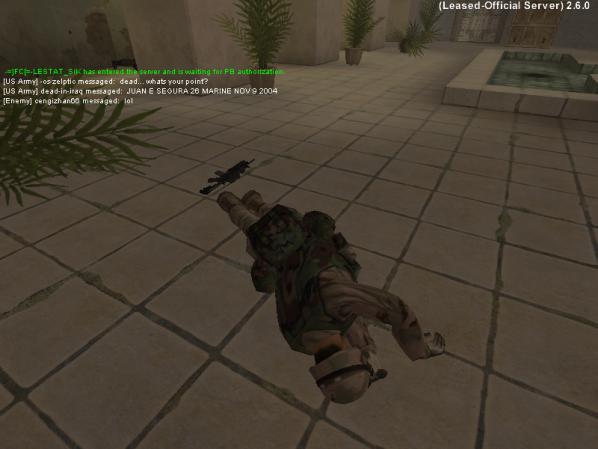
Joseph DeLappe, “dead…whats your point?” dead-in-iraq screenshot 2006-2011.
“The players ask DeLappe to stop what he’s doing, but when he continues they shoot him or simply kick him out of the game. You can see the strong reactions from the other players as a proof that DeLappe’s performance are successful. He succeeds to break the game illusion, in the same way as Brecht “Verfremdungseffekt” breaks the illusion in drama.” [1] (Jansson)
Much of DeLappe’s work is known for challenging his own nation’s involvement with war. However, if we look at The Salt Satyagraha Online: Gandhi’s March to Dandi in Second Life 2008, his work reflects a wider context introducing his concerns on the human condition. Over the course of 26 days, from March 12 – April 6, 2008, using a treadmill customized for cyberspace, DeLappe reenacted Mahatma Gandhi’s famous 1930 Salt March. “The original 240-mile walk was made in protest of the British salt tax; my update of this seminal protest march took place at Eyebeam Art and Technology, NYC and in Second Life, the Internet-based virtual world.” [2]
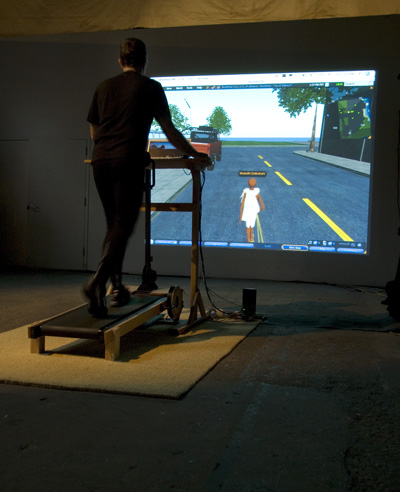
On hearing about DeLappe’s The 1,000 Drones Project – A Participatory Memorial, I was immediately intrigued. I wanted to find out more and discuss his approach as well as how he intends to bring to light the lives lost by these unmanned Arial predators as an art project, and what this would look like.
Marc Garrett: Could you tell us why you felt it was necessary to do this project even though there is already much media attention out there relating to the use of drones in domestic, military and commercial culture?
Joseph DeLappe: There has indeed been much media attention surrounding the use of militarized drones as a part of US foreign policy. Our drone policies have received much attention yet, as with the coverage of civilian casualties from the Iraq war, the actual human costs of our drone strikes remains rather illusive. Through the work I am doing regarding drones that specifically focuses on memorializing civilian deaths I hope to actualize the estimates of civilian deaths and to call into question the moral issues surrounding such remote killings. You might say that drones have struck a nerve with me. There is something different about drones. They seem to perfectly combine aspects of our worst fantasies of digital technologies, interactivity, computer gaming and war. One might consider them a bit of a “gateway” weapon (the drug reference is of course intentional here). I suspect we have indeed opened a Pandora’s box leading to the further utilization of remote and robotized weaponry that will make our current drone usage seem quaint.

The above is “An ongoing series of image interventions downloading images of UAV’s (unmanned arial vehicles) in use by the United States Military, including: General Atomics MQ1-Predator Drone, MQ9 Reaper Drones and Global Hawk Drones from the top results of Google image searches. Each image is slightly adjusted to include the marking “COWARDLY” upon it’s fuselage. The saved images are uploaded to my website with basic titling information “Predator Drone”, “Reaper Drone”, “Global Hawk Drone” – with the intention of having these images begin to appear in searches for information and images on drones occurs online. The works are intended as a subtle intervention into the media stream of US military power.” DeLappe
I am working on several drone projects at the moment, including The “1,000 Drones Project – A Participatory Memorial”, and seek to draw attention to and creatively memorialize those innocents killed by drones. It invites the public to create a small scale, papercraft replica of a General Atomics MQ-1 Predator UAV (Unmanned Arial Vehicle) – a drone. Participants are asked to write the name of a civilian drone casualty upon the wings of the aircraft.
This project is an adaptation of The 1,000 Cranes or “Senbazuru” tradition from Japan. This tradition holds that anyone who folds one thousand cranes will be granted a wish. Since World War II the tradition has been associated with the atomic attacks upon Nagasaki and Hiroshima – the folding of the cranes has become a wish for peace. [3]

MG: You are inviting participants to be a part of the project. In what capacity will they be taking part?
JD: The 1,000 Drones Project has been commissioned by the FSU Art Museum of the exhibition “Making Now – Art in Exchange”. The FSU Department for Art has for the past few months conducted a series of workshop events where the public is invited to make a small, paper drone from a provided template. The form is made directly from MQ1 Predator Drone plans found online. The drone shape is cut out, there are then five dotted lines denoting where to fold the paper – the result is a simple paper facsimile of a drone. Once the drone is created, the participant is invited to write the name of a civilian drone casualty along with their age at the time of death, upon the wings of the drone. The Bureau of Investigative Journalism estimates that between 2004 and 2013, drone strikes in Pakistan killed between 2,536-3,577 people, of these, it is estimated that 411-884 civilians and 168-197 children have been killed. The list of civilian drone casualties comes from The Bureau of Investigative Journalism. We are also using a list of drone casualties from Yemen found here: http://en.alkarama.org/documents/ALK_USA-Yemen_Drones_SRCTwHR_4June2013_Final_EN.pdf
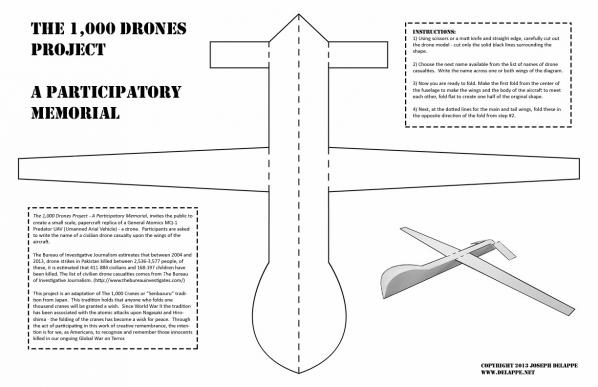
At present we have a total of 464 persons identified as civilian drone casualties from Pakistan and Afghanistan. To complete the 1,000 drones, the remainder will be marked “unknown”.
The paper drones are to be strung together in groups of 18 per string, 55 strands will be hung in the center of the gallery to create an installation that will be triangular in shape. The making of the drones will continue with the opening of the exhibition in February until 1,000 are complete and installed.
MG: What will others learn or gain from this participation?
JD: This is difficult to pin down. My intention is that through the act of making a drone, followed by writing a name or “unknown” upon their creation that individual participants will in some small way actualize the loss of individual lives due to our drone attacks. The intent is to perhaps for some brief moment make real these deaths taking place in our name on the other side of the globe. The actions are decidedly low-tech as well – there is something important in this – the deaths become physical, perhaps drawn from the digital media stream, the digital process of the killings to a direct, physical act of making and remembering. I am very interested as well in the overall effect of the piece – to see 1,000 white paper drones hanging in space as a memorial will likely have a powerful impact. Numbers of civilians killed as reported through our media are all too often numbing and abstract – this piece will hopefully make real this abstract process of digitally remote killings.
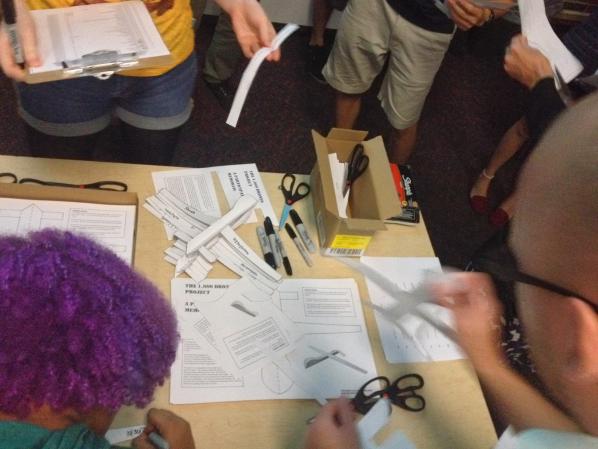
MG: What is the lineage of this project?
JD: I’ve been working intensively over the past decade to creatively shed light on civilian and military casualties as a result of our ongoing “war on terror”. This includes “dead-in-iraq”, my intervention as a memorial and protest taking place within the America’s Army computer game and iraqimemorial.org, a crowd sourced project launched in 2007 inviting anyone to post concepts, imagined memorials to the many thousands of civilian casualties from the Iraq conflict.
Looking at DeLappe’s breadth of work informs us how detailed and complicated the subject is, and it equally reminds us how distant we all are from any quality debate about war and drone technology and the impacts these militarised technologies have on citizen’s lives. Thankfully, on the subject of drones the Internet is supplying us with different view points that mainstream news media fails to seriously investigate. Russia Today, reported that classified documents from the CIA could not “confirm the identity of about a quarter of the people killed by drone strikes in Pakistan during a period spanning from 2010 to 2011.” [4]
Kate Rich and Natalie Jeremijenko in 1997 as part of the then, anonymous Bureau of Inverse Technology were pioneers of the first art drone ‘The BIT Plane’. This work was featured in a group show at Furtherfield’s gallery, Movable Borders: Here Come the Drones! in May 2013. [5] In an article in Mute magazine Rich wrote, “The morally disgusting asymmetry of drones relates not only to their deployment by the powerful against the weak, but also to the radical disparity of risk entailed in exposing the defenceless living to pilotless killing machines.” [6] This brings to mind how vulnerable we all are to the whims of the powerful. This feeling of fear will strike at the heart of any humanist not on the ‘right’ side of those wielding such awsome destruction without challenge, until its too late.
DeLappe’s art not only reflects the militaristic world we are living in he is directly engaged with it. His focus on his nation’s obsession with war echoes what James Hillman wrote in A Terrible Love of War, “Hypocrisy in America is not a sin but a necessity and a way of life. It makes possible armories of mass destruction side by side with the proliferation of churches, cults and charities. Hypocrisy holds the nation together so that it can preach, and practice what it does not preach.” [7] (Hillman 2004)
Many contemporary artists are working with and critiquing Bio-Technology, Nano-technology, engineering, issues on Climate Change, border controls, data-mining, surveillance, economic and political fluctuations, and the military. This is in line with the expansion of the networked society. Controversies and battles are taking place in a time of uncertainty, where the very technology and systems that have supported progress, through its worldwide channels of production and prosperity; are now the very same tools threatening the survival of our species, contributing to climate change and the emergence of the economic, global crisis, as well as a threat to our civil liberties. Art and critical thinking examining this complex and strange territory and its impacts on us and the planet are right up there in pushing forward a new kind of radical investigation as an art practice.
Joseph DeLappe’s next exhibition ‘Social Tactics’ will be from January 24 to April 27, 2014 Fresno State Center for Creativity and the Arts, in the US.
The artist and curator Art Clay was born in New York and lives in Basel. He is a specialist in the performance of self created works with the use of intermedia and has appeared at international festivals, on radio and television television in Europe, Asia and North America. His recent output focuses on large media based performative works and spectacles using mobile phone devices. He has received prizes for performance, theatre, new media art, music composition and curation. As an educator, he has taught media and interactive arts at various art schools and universities in Asia, Europe and North America including the University of the Arts in Zurich. He is the initiator and Artistic Director of the ‘Digital Art Weeks International’ and the Virtuale Switzerland.
Eva Kekou: Could you tell us about your work and what inspires you?
Arthur Clay: The question about inspiration has been posed to me before and most often in the moment when people first see the program that the Digital Art Weeks (DAW) is offering. As an artist I am very much inspired by the every day. I think it is important to be aware of the things around you and by so doing, my artwork seems to have more of a present day dialogue and the events I curate more to do what is actually going on in the society around me. So basically, everything and nothing and all the things in between inspire me. There are no rules, but with a lot of effort to try and come closer to things might be the one I apply the most.
On the one hand, I am a practicing artist and most of this work is concerned with sound. On the other hand, I believe that curation is an art in itself and requires a high level of creativity. It is easier for me to make an artwork in comparison to harmonizing a group of artworks. The two meet in the fact that I grounded the DAW projects in order to provide a platform for my own work and that of others, who think in like minded ways.
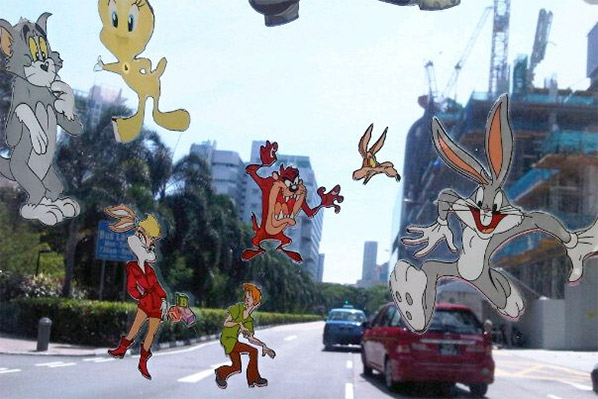
EK: You were the curator for the Augmented Reality exhibit “Window Zoos & Views” in collaboration with the participation of the School of Digital Media and Infocomm Techology from Singapore Polytechnic. On the project site, it mentions that the main element of the project was inspired by an image of a car driving down Singapore’s legendary Orchard Road. Could you tell us a bit more about this and the project?
AC: As DAW Director, I am confronted with the same situation each time we bring the festival: Representation and integration. By representation is meant that we have institutions both public and private that act as stakeholders and in turn expect a high level of visibility; talking about integration is much more complex, because there are many levels of integration that must be addressed. First off, the festival structure demands that we integrate local artists into the program along with the international artists participating. Integration of local artists can also mean or entail a high level of knowledge and skill transfer. We do all this during what we like to call the “Exploratory Phase”, which is basically entails dropping the DAW team into a unfamiliar city and making every effort to make it familiar. This includes becoming aware of the general culture the festival will address, how digital that culture is, the art and non art spaces that will become the stage of the festival, and of course trying to find out who is doing what in terms of arts and technology.
To get back to your question about the image of the car driving down the street, the most important element of integration is becoming aware of what is going on in the world of things in which the festival is to be presented. The car we are talking about was a car whose windshield was plastered with cartoon stickers. So, imagine you’re self-sitting at the wheel of that car driving down Singapore’s Orchard Road. It is a really surreal experience; the stickers take on a kind virtual elelment as it floats down Orchard road. The image sparked my imaginations and the AR Parade project was born, which was a very important part of the “Window Zoos and Views” exhibit. Basically, the AR Parade mimicked the effect of the stickers on the car window, but instead of a car windshield, we used an iPhone app to view the images. It was very cool, popular on the street and got a lot of clicks.
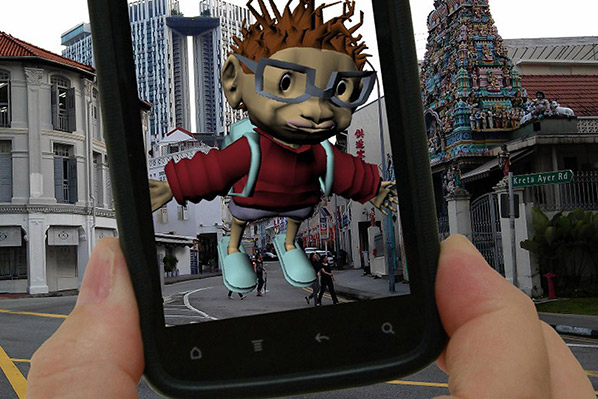

EK: There were various artists in the festival showing Augmented Reality art as installations. This included artists such as Tamiko Thiel (DEU), John Cleater (USA), Will Pappenheimer (USA), Lily & Honglei (CHN), Marc Skwarek (USA), Lalie S. Pascual (CHE), John Craig Freeman (USA), and Curious Minds (CHE). It must of have taken a lot of time and energy to organize this, especially the technological aspects of the project. How difficult was it to set all of this up?
AC: In one word: impossible. It is new area of technology, a new approach to curating art, and above all you are dealing with a non-art public – basically anyone who is on the street. That is a big challenge. Add to it the new type of management skills that such an international project work requires and I think you are close to the impossible that I am referring to. For such exhibitions, “Management 2.0” skills are a necessity. The artists, the tech people, and the curators and admins meet and work solely in virtual space. So there are no walls, no tables, and there is no going for coffee together after the meeting. It is a different world from all sides.

Another interesting aspect of this work is that you have to develop a feel for the city and develop a dialogue with it. For the Hong Kong show we did for SIGGRAPH Asia, Monika Rut and I spent about a week working on site, visiting the different areas of the city to check things out and to get a feeling for which works should go where and why. We travel with a lot of special equipment so that we can make tests on site and produce a mock up of the exhibition and test how the experience of viewing the exhibit will be. It is very inspiring but exhausting work and the dialog between Monika and I helped greatly in making all the decisions. Basically, we get to know the cities we are working in quite well and the kick back is, you get to know where the best coffee houses and local restaurants are.
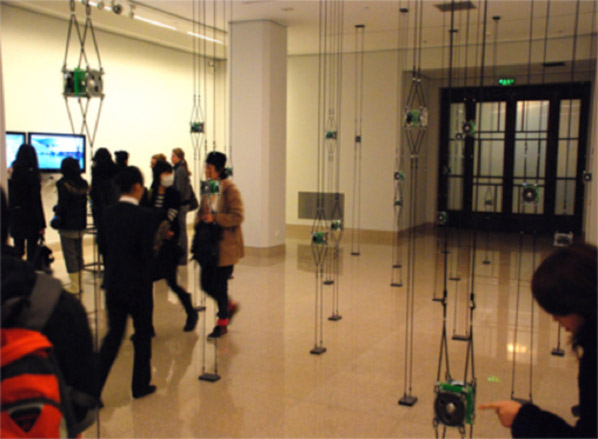
EK: Why hold the DAW in Asia, and what kind of differences do you experience culturally when working in Asia compared to working in Europe?
AC: The DAW is at home in Asia and much of our curating has to do with having visitors get pro-active. This means that it is not just about looking at an artwork, it also entails actually touching the artworks in many cases. In Asia, the museum visitors are not that schooled in museum etiquette. They like to touch things and this is great for the kind of work we like to do. Things break, but it is kind of a “I Like” thing for us.
The other aspect to consider is that you have a language barrier, because no one is going to understand anything if it is not translated. Here, it is also important to know that the approach Europeans take in terms of explaining artworks, does not really come over so well in Asia. Things are often inspired by poetics of nature in Asia and are much less conceptual than works coming from Europa.
Last but not least, the role of size also plays a large part in Asian arts. When a dynasty was at its peek, it produced very large artworks, monuments etc. So size is historically a sign of wealth and prosperity in Asia. When a dynasty fell, they produced much smaller works. So the bigger the better, so to say. For a European artist this is completely meaningless, however, bigger artworks have more visibility. So when you are curating group exhibits in Asia that artists from diverse countries, it is a challenge to keep balance in terms of impact of the works.
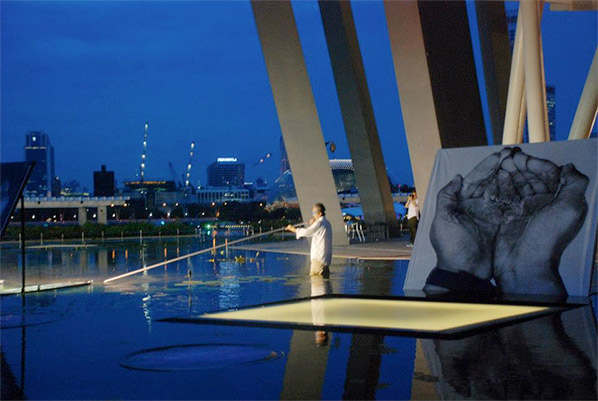
EK: Getting back to There DAW AR Float Parade, which was the first of its kind and celebrated as the coming age for Augmented Reality art. Could you tell us more about this aspect of the festival’s project and how it turned out?
AC: Knowledge transfer plays a major role in getting a project like the AR Parade to work. The DAW has an “OutReach Program”. This is a program that invites creative leaders from around the world to hold workshops before or during the festival. The contents of the AR Parade in Singapore were the results of a workshop with the AR artist John Craig Freeman and the Curious Minds group. John Craig dealt with the technical details and the bootstrapping a group of twenty-five creative industry students from the Singapore Polytechnic. The members of the Curious Minds art group hung around, integrated the group into the DAW, taught the students about public interaction, and came up with how to go about actually making the AR Parade happen and come to life.
The proof of a good project for me is when it takes on its own life on after its initial presentation. After the Singapore DAW, the AR parade went to Hong Kong and in 2015 it will be shown marching down the Bahnhofstrasse in Zurich as part of the Virtuale Switzerland festival – the world’s first festival “virtual biennale” that focuses solely on virtual artwork. For this we want to go a bit deeper into the creative industry world and see if we can act as modern alchemists and pick up on the float parade from New York and turn Miss Kitty into an artwork by shifting context from the real to the virtual.

Live- Performance “Beads are the Breath of the Landbridge “ with 1st Nations artists, Peter Morin. (DAW Singapore 2013)
EK: What is your view regarding the social contexts of the DAW?
AC: Basically, we are concerned about things and we make an effort to improve things that are within our reach to improve. For the festival in Taipei that will take place in 2015, we are really trying to make people aware of the role of creativity in general. Artists are highly creative people and the world really needs good ideas as well as a more social approach. We try to provide an answer to the question: “How is what we do of benefit to the society in which we are operating?” We think this should be more a question that businesses should be asking themselves. The future needs fewer companies who are “profit first, prosperity second” and more social entrepreneurships that embrace social needs as part of their business model.
EK: Could you tell us what themes and aims we can expect from of the DAW project in the future?
AC: We are off to Seoul, South Korea in 2014 and the theme there is “Creativity and Convergence”, which is a hot topic in Asia, because the government feels that innovation is intimately connected to being creative and thinking out of the box. I think they’re thinking of what makes the West tick and in an odd and ironic way to imitate – which is not exactly creative, but then again I have lot of respect for Asia and admire the work ethic of Asian people. So I think they will do well by addressing these themes. In 2015, we are off to Taipei and the theme (working title) there is “ImagiNation” and here we are trying to run a kind of “Skills-Festival” and platform creative businesses and the approaches that they have taken. It is a new approach and if you think about what Beuys said, “Everyone is an artists”, we might stretch it a bit and also say “everything is art.” At least this is the start and interestingly enough we are working with groups from the labor department in Taiwan, with knowledge transfer departments of universities, and with spin off and start up companies from Switzerland. It is very exciting and really what the DAW is about: creating a platform for research and experiments in social-cultural context.
Digital Art Weeks International
The DAW INTERNATIONAL’s is concerned in general with the bridge between the arts and sciences in cultural context with the application of digital technology in specific. Consisting of symposia, workshops and cultural events, the DAW program offers insight into current research and innovations in art and technology as well as illustrating resulting synergies, making artists aware of impulses in technology and scientists aware of the possibilities of application of technology in the arts.
The Virtuale Switzerland
The Virtuale Switzerland is a biennale for virtual arts. It focuses on the use of public space and mobile communication technologies, inventing “playful” new strategies to coax the public into the festival as “real” visitors with a unique experience of the virtual. The Virtuale Switzerland encompasses Artworks using Augmented Reality, Urban or Location Based Gaming, and Digital Heritage applications. It is interdisciplinary in nature, bridging areas such as art and technology, digital heritage and tourism, as well as digital culture and art mediation.
Featured image: Screenshot of Apodemy by Katerina Athanasopoulou
Eva Kekou interviews Katerina Athanasopoulou about her film Apodemy commissioned by The Onassis Cultural Center on the theme of Emigration for Visual Dialogues 2012, and her hybrid art practice of live action, animation and film. In 2013 Athanasoppulou won the Lumen Prize, described by the Guardian as “The World’s Pre-eminent Digital Art Prize”. She works as an Animation Director, collaborates with other artists and companies, and is an Animation Lecturer at the London College of Communication.
What is your background and what brought you to London?
I studied Painting at the School of Fine Arts of Aristotle University in Thessaloniki. My work involved large canvases painted in a serendipitous way, building layers, erasing and restarting, seeing where my lines were going to take me. I was frustrated by the stillness of the final piece, longing to recreate the gesture in time that had created it. At the same time, I was passionate for cinema and animation so I tried it out in my own computer at home. In a way, I discovered animation for myself, as there was no film nor digital element in my course. That meant that there was no right and wrong way to go and it was such a joy to be producing moving images, to be able to finally paint in time! My first films were digital cutouts and manipulated live action. The big change came when I arrived in London in 2000 to do an Animation MA at the RCA, where suddenly completely new creative possibilities appeared. Short film festivals were also a source of great inspiration, places to meet like-minded filmmakers and watch films all day long.
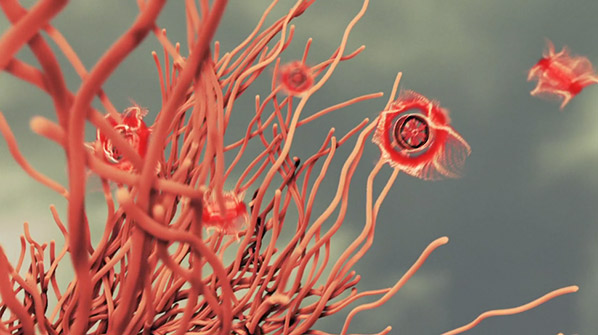
What’s the effect of English education in your work and in the way you appreciate art?
When I became a student in the UK, I was at the same time delighted and terrified by the informality of the teacher-student relationship, like addressing your tutor by their first name. I was really impressed by the enthusiasm for research and for the creative journey itself. Process becomes a major part of the work and that frees you from concentrating only on the outcome. I saw how Animation can be enlisted in very different ways, from a more commercial manner to very left-field experimental practices so that was an exciting new point of view for me. At the same time, the early 2000s were a time of conflict between analogue and digital practices – which of course has not quite gone. As an educator myself, I love the intensity of the way that students debate their work, so the English system of education still very much inspires me.
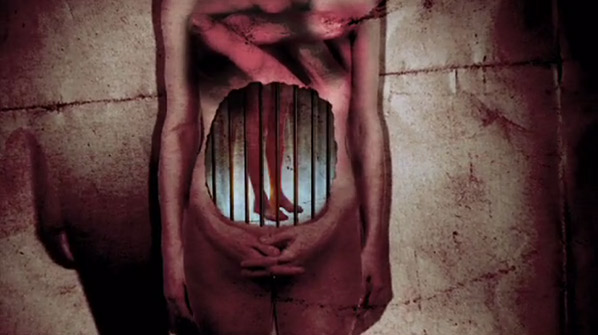
What was your creative practice up to the Lumen Prize.
Since 2002 I have been making short experimental films that have been screened in film festivals and galleries, my process being one of playfulness and embracing chance. I like to try out different ways of creating moving images, and I try to make each film follow a different road, even though it’s very tempting – and at times fruitful – to revisit old concepts. In the last three years I have developed a big interest in Architecture and how that can be depicted in time, through 3D, 2D and live action. Animation for me is Alchemy, I combine elements together, in textured space and time and see what happens. These experiments some times involve diving into live action that I have captured on location, and other times are about creating that space digitally.
Animation Installation is a field I’m fascinated by at the moment, devising ways of materialising the digital element, of making it even more about light and shadow. My latest film, Triptych 1, was made especially for the facade of the Museum of Contemporary Art in Zagreb and reimagines it as built of interconnecting corridors.
Talk to us about the theoretical and philosophical background of Apodemy.
Apodemy was commissioned by the Onassis Foundation (Stegi) on the theme of Emigration and the Economic Crisis. It was to be part of an Art Show in an old archaeological park in Athens, called Plato’s Academy Park, where the philosopher is believed to have taught. The title of the Installation was Visual Dialogues so I was drawn to Plato’s Dialogues where I discovered the metaphor of the human soul as a birdcage. I was very keen to instil in the work philosophical elements related to the space itself. With migratory birds being one of my initial ideas about the piece, the solution of a travelling birdcage in an abandoned half-finished city became apparent. The marble arms were part of Plato’s birdcage metaphor, where he describes how, as we grow up we fill our mind/birdcage with ideas/birds. When we need to recall something, we put our hand in the cage and grab a bird. I imagined those hands to be aggressive, so they became statue fragments carried by cranes that eventually mar the trolley cage’s journey. Theo Aggelopoulos inspired me with his images of a Lenin statue traversing the river and of a single arm, floating accusingly yet innocently. In times of political upheaval we like to break down our past heroes, in an attempt to cleanse ourselves of mistakes. Only that sometimes those past leaders still come back to haunt us.
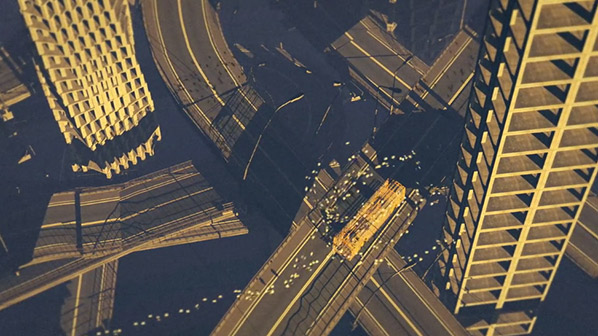
What techniques did you use?
I designed the city on the computer in 3D and then started to drive cameras inside it, discovering it on the road, like I was exploring a real landscape. The film was built like a documentary, following the migration journey of a cage that is also a trolleybus, the yellow kind that I was riding in Athens when – in the late nineties – everything was promising.The construction industry ground to a halt when the crisis took hold so, today, many buildings remain unfinished and look like birdcages themselves. After the City was built, I started making the birds and the bus. Then I moved it inside the city, following a broken road which eventually leads to the fall. The entire film developed through trial and error, it was my first 3D film and I had limited time and resources. But restriction breeds creativity and, in the two months that I had to complete it, I tried to make a film designed in a minimal but impactful way.
What does the Lumen Prize mean to you and how can such a recognition make a difference in your work and life?
Winning the Lumen Prize was a great honour, especially amongst so many great works from entirely different platforms. The prize revolves around fine digital art and encompasses film, installations, interactive work, print, sculpture, collage. Amongst such a plethora of forms, it meant a lot that Apodemy was awarded, both in terms of my digital animation practice, but also as it’s a film that’s about the collapse of my country of origin. The Lumen Prize show has already been to New York and will also be part of the Digital Symposium at Chelsea College of Art and Design in March, as well as in Hong Kong in June. It’s wonderful that Lumen is propelling the film further forwards, and it’s been great to meet some of the other artists involved. Seeing the works by Nicolas Feldmyer, Kalos&Klio, Margarita Koulikourdi, Vasileios Chlorokostas and others has been very inspiring.
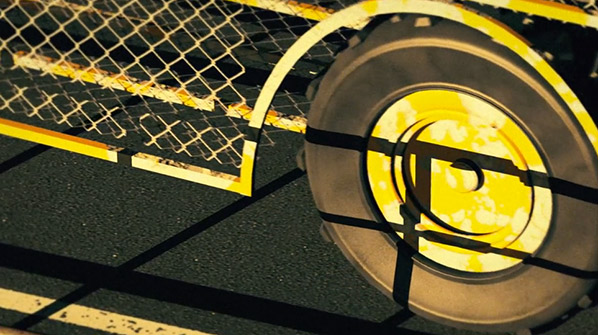
What draws you to animation?
Through cinema, we immerse ourselves in different waters, achieving a kind of immortality. One could argue that also happens whilst reading, or listening to music – yet somehow film combines literature and poetry and music too and almost all the senses get involved. What’s more interesting for me is the connection between moving image and the imagined: it’s almost like we dream other people’s visions and we physically try to make that disconnection from reality by favouring watching films in dark rooms. The cinema I’m interested in is one of spectacle, that transforms reality into a surreal play, that explores light and shadow and looks for monsters under the bed. At the same time, I’m currently very curious about taking animation off the screen and applying it in space, by projecting rooms, objects, corners. For me, there’s no greater magic than instilling life in the inanimate and create moving worlds that don’t depend on cameras and actors – what’s in your head can be made real, a real that’s still beautifully elusive and chimeric, that doesn’t contain all the answers but asks exciting questions.
What are your future plans?
I have been working on an experimental narrative of an obsessive mother that cocoons her children, which may work as a single screen work or perhaps as an installation that includes a film. I’m also researching the Architecture of Melancholy, which lies somewhere between cabinets of curiosities and abandoned homes. I always have several experiments on the go, it’s really about finding the right time and opportunity to commit to a project. As delightful as animation is, it takes time to complete, but it also means that ideas may have time to mature and not be rushed. As long as my ideas keep me entangled, I’m happy.
See Katerina Athanasopoulou’s work online at kineticat.co.uk
A DISTINGUISHED DATA-BENDER AND ACCOMPLISHED SOUND-PLUNDERER, Benjamin Berg (AKA stAllio!) has made a career for himself as a member of the Indianapolis-based art band Animals Within Animals (AWIA) since the turn of this century. Alongside of that, Berg’s also emerged online as the host of a rad radio program on Numbers FM, as the founder/curator of the Tumblr called glitchgifs, and even as a pillow-seller. Midwestern breakcore fanatics may recall seeing his name on bills back in the day alongside such legends as Doormouse or Xanopticon. AND It turns out he’s also a rather skilled skill-sharer. Monty Cantsin [AKA Rap Game Gertrude Stein], big fan of stAllio! since 2007, corresponded with the artist recently [11/2013] by email for this interview.
Montgomery Cantsin: How did you first encounter the “plunderphonics” approach? And, looking back over the last few decades, what (for you) are the highlights and stand-out tracks that define that particular genre?
Benjamin Berg: A co-worker told me about Negativland so I tracked down a copy of Escape From Noise. That was a game-changer for me, and still one of the highlights of their catalog. The Evolution Control Committee’s (ECC) Whipped Cream Mixes were hugely influential and still stand up better than most “mashups” made since (same goes for their track “Rocked by Rape”). I’d also list: John Oswald’s early work, like Plexure; pretty much anything by Orchid Spangiafora; Osymyso’s “Intro-inspection;” Wobbly’s Wild Why. To that list I’d maybe add something by Wayne Butane or Cassettboy for a touch of humor.
MC: What were some of the first projects that you worked on in that vein?
BB: We were maybe mid-way through the first Animals Within Animals record when I discovered plunderphonics, so the first experiments were on the first two AWIA releases (Yard Ape, and Mono a Mono).
MC: When ECC started, I think they were doing work using a simple dual-cassette system. Did you ever do any of that? I am stealing the name of one of your greatest hits, “Mash Smarter Not Harder,” to title this interview; was that track made using simple editing software? Because, by the time you made “Bust A Groove” (a similar sort of track) you’d decided to use Ableton, is that correct?
BB: A bunch of the first AWIA record was made on a 4-track, and at least a couple of those tracks used a pause-button sampling technique, so that was effectively dual-cassette. Also, a lot of my earliest video work was done with simple pause-button editing; I didn’t have access to real editing equipment, so I would just hook the camera up to a VCR and edit that way. On some of those I was very loose about where my edits were; I would just fast foward to some point at random on my source tape and copy a clip over The Mash Smarter Not Harder EP and the first few tracks I recorded for A Huge Smash were done in Adobe Audition. But after a while, it got to the point where I just had too many cuts and the program crashed. When I lost a track and had to start it over, I switched to Ableton, which not only performed better but also made it easier to sync my edits to the beat.
MC: Now what about your personal history of glitch music? This one is a bit harder to pin down, perhaps?
BB: Yeah I can’t name a particular moment when I discovered glitch music or a particular artist or release. It was probably something off of the Mille Plateaux label, if I had to guess. The early M^2 records were an influence for me, as well as early Kid606 (but not anything he’s done in the last 10 years). My favorites are Lesser, DISC, and Farmers Manual… anything by them is great. Ryoji Ikeda is really good, too.

MC: An old film projectionist once remarked to me that “digital failure is absolute.” I guess he was frustrated… when analog equipment falters it still often gives you something (some image, some sound) and can be worked with. Whereas sometimes with a digital system it’s more of a black box situation where it’s either on (‘one’) or it’s off (‘zero’). Does the glitch represent a sort of exception to this? Can you talk about glitch in the context of this–perhaps mistaken–notion that digital failure is “absolute?”
BB: I wouldn’t say that digital failure is always absolute. Sometimes it is, like clipping versus analog distortion, where you hit a sort of peak and can’t break things any further. But it depends on the system, and the assumptions that engineers make when designing systems. An obvious example would be your TV going to a blue screen when the picture is bad, instead of showing snow as they used to. There’s no technical reason why a TV has to do that. Hardware manufacturers decided that nobody would really want to watch a heavily distorted picture, and designed their devices not to show one. I like to say that glitch art is like dancing on the edge of a broken system. You want to break things enough that it affects the output, but not so much that your tools stop working or the system fails altogether.
MC: I have to say that “Fuck Windows” (your track composed entirely of Windows and Sim City samples) is one of my favorite audio pieces that you’ve done. What can you say about that one? …Are computer games what got you interested in fucking around with ‘data?’
BB: I made “Fuck Windows” in 1996, and it came about in large part because I already had those sounds on my computer. It seems weird to think about now, but back then samples weren’t so easy to come by. You either had to rip them yourself from a CD (and being in college, I only had so many) or record them yourself using a shitty computer microphone. The system sounds and video game sound effects were practically the only WAV files I had, so it seemed natural to use them. …I started using data as audio around the same time, but it didn’t directly spin out of that track. I was using a program called Impulse Tracker to compose/arrange music on the computer. Going back to what I was saying earlier about assumptions: most programs assume that unrecognized file formats can’t be read (or they make you explicitly tell them how to interpret such files). Impulse Tracker assumed the opposite, and let you open any file on your hard drive as if it were a sample. I discovered that pretty quickly and spent hours just browsing through my computer, listening to all the data.
MC: “Blue Screen of Death” is another one of my favorite audio works that you’ve done. You describe this kind of work as ‘data-bent’? What is your process for it?
BB: These days I’ve taken to calling that style of music “data sound”. The general process is that I browse through my hard drive, converting data files to sound and trying to pick out the ones that sound the most interesting. Then when I have enough cool sounds, I arrange them into a track. My first data sound release, Dissonance Is Bliss, was done entirely in Impulse Tracker (both the sonification of the data and the arrangement of the samples). Then I switched to using WAV editors to sonify data, and loading the WAV files into other music-making tools. “Blue Screen of Death” was arranged in Fruity Loops. Everything on my newest data sound release (On the DLL) was arranged in Ableton.
MC: What can you say about chance? And, is there a distinction to be made between the data-bent and the glitched? Can something be a glitch if it is intentionally created? …This reminds me of a somewhat related question, that of “found objects”–can we rightly call them that if we specifically go out looking for them? [In surrealism there is the so-called “chance encounter of a sewing machine and an umbrella on an operating table.” It seems to me that it’s largely the chance aspect that is of key importance there–the notion that such objects could be juxtaposed unintentionally somewhere in the world and you could just happen upon them.]
BB: I think glitch is like the intersection between chance and formalism. In the 20th Century artists started asking questions like “What is music?” and “What is a painting?” And you had things like The Art of Noises, musique concrète… you had painters who were more concerned with exploring the nature of paint and canvas than with “representing” some physical object or scene. Glitch practices are like that stuff, but because digital structures are more hidden, you can do things where even if you know pretty much what’s going to happen, you don’t really know what the end result will look or sound like. It’s not really chance, because there are rules governing it, but it feels like chance because you don’t understand those rules. Even if you have a good grasp of something like JPEG compression, you probably can’t look at the code and tell what the image is going to look like. So it’s a way of creating things that you wouldn’t have thought of yourself, just as in the tradition of John Cage, Bryon Gysin, etc. As for the difference between a “natural” glitch and manmade glitch (or what Iman Moradi called “glitch-alike”): it’s an important distinction that had to be made, but it’s not one I find particularly interesting. For one thing, the audience generally can’t tell the difference unless you’re really obvious about it, so it’s mostly a question of what you feel comfortable with as an artist. Encountering a glitch in the wild (what Antonio Roberts and Jeff Donaldson call “glitch safari“) is exciting, but the idea that if it’s not a wild glitch then it’s not “real” is very limiting and precludes all sorts of interesting art practices.
MC: I wonder how is it that a whole industry (websites, music and art careers, academic conferences, etc.) seems to have sprung up around The Glitch. How can so much be generated within that narrow of a conceptual/aesthetic space?
BB: I’m not surprised by the growing popularity of the glitch. We’re surrounded by technology but we’re not that used to thinking about how it works, let alone how to deliberately misuse it. Glitch practices constitute a different way of thinking, and these kinds of ideas are infectious. You can apply glitch theory to pretty much any technology or system, so it’s widely applicable, and it tells us things about the world that might not be obvious otherwise.
MC: You are founder of glitchgifs Tumblr? Is it you alone?
BB: Yeah, I run glitchgifs. GIF is such a great format for glitch art, because it’s the only common shareable format that allows motion and looping without the user having to click anything. I run the blog alone, and I would actually love to invite other curators, but because it was the first Tumblr blog I created, I am unable to do so. To Tumblr, I am “glitchgifs” and there is no way to tell it otherwise, even though I have a blog at http://stallIo.tumblr.com that’s intended to be my “personal” account. There are those pesky design assumptions again.
MC: Plans for the future?
BB: I’d like to find the time soon to do some video work again. I have footage; I just need to assemble it and set it to music. Musically I have a release coming out (hopefully) soon on a German label called Betonblume. I’m really pleased with it and can’t wait for it to come out so people can hear it. After that, I hope to make some new post-mashup tracks and finish the follow-up to Wack Cylinders. I’m still going to be active posting new art on Tumblr, and my weekly show Active Listening / The Act of Listening on numbers.fm will continue at least for the near future.

MC: Finally, please tell me more about this big international show you are in right now, and about this amazing text generator thing you did for it.
BB: The Wrong – New Digital Art Biennale is a massive online art show, consisting of 30 individually themed pavilions. Bill Miller graciously invited me to contribute to his pl41nt3xt pavilion, which centers around art made with simple technologies like text, rather than fancy 3d environments or video processing or stuff like that. So I made a glitch text generator and text-art canvas. It lets you quickly generate “glitch text” out of combining diacritics (g͖̣̝͎̙͐ͅl̵̮̰̝᷇̑̾î̶̢᷾ͭ̈́ͩt̯̬̰̓ͦ᷁͋c᷿͖̙ͯ͛̊᷇h̳̭͓͛ͬ᷈᷄) as well as generate other fun stuff like ◞▀╗▪┐│╌╈◚┱▍▷▀╻▪╶ …plus it’s a text art canvas for making art out of the text you generate. You can even download the scripts yourself and add them to your own project.
MC: OK, stAllio! thanks for your time! Oh, one last thing: what is your favorite ‘dingbat’ or ‘wingding’?
BB: My favorite Unicode pictographs are in the Miscellaneous Symbols and Pictographs block. Not many fonts support this block right now, but it has some crazy stuff in it. Probably the craziest is Love Hotel. A love hotel is a hotel that is geared toward sex. The fact that there is a character for this in Unicode blows my mind. Another great one is Dancer, which looks like John Travolta on the cover of Saturday Night Fever. It’s so perfect. Travolta has literally become an icon.
This week the ReadingClub organised two live reading sessions with us at Furtherfield. The first performance with Aileen Derieg, Cornelia Sollfrank, Dmytri Kleiner and Marc Garrett, was based on a chunk of A Hacker Manifesto by McKenzie Wark [version 4.0]
The second session took as its starting point one of the ARPANET dialogues from 1975 -1976. What we first took as a historical moment, encapsulating the collision of modernist and postmodernist art world figures and the disruptive effects of digital network communications, turned out to be an ongoing research project by Bassam El Baroni, Jeremy Beaudry and Nav Haq.
Alessandro Ludovico, Jennifer Chan, Lanfranco Aceti and Ruth Catlow reenacted the historic collision in a contemporary context. The result – a new text called “Postinternet is net.art’s undefined bastard child”
You can view the recordings of both performances here:
ARPANET dialogues
Hacking, The Hacker Manifesto
Below we reproduce a translation of an interview by Annick Rivoire originally published in French for the publication Poptronics. Read original article here.
One might think (wrongly) that the “Reading Club” is a mixture of a “Fight Club” and a “Bookfighting” (book battles invented by a community from Orleans called Labomedia). Rather, the activity of the “Reading Club” is above all reading – an active, participatory, collaborative and performative reading on the Internet.
Annie Abrahams and Emmanuel Guez wanted this project to be nomadic and shared, so they invited, in addition to IRL institutions like the BPI Centre Pompidou or Le Jeu de Paume in Paris, network partners like Furtherfield, an art and digital resource center in London, and Poptronics. When Annie Abrahams (a challenging net-artist whose work Poptronics likes) told us about the “Reading Club”, it did not take us long to accept the proposition! This “interpretative arena” had a taste for experimentation.
So, in June began the first test (which I attended). Then, during the summer and early September, the device has been refined and made public. An extract from “A Hacker Manifesto” by McKenzie Wark, and snippets of the “Arpanet Dialogues“, these pre-chatrooms conversations from the 1970s attended by Yoko Ono, Marcel Broodthaers, Jane Fonda and a certain Governor Ronald Reagan, have been chosen for the fourth online session with Furtherfield on Monday 21st and Tuesday 22nd of October.
Annie Abrahams and Emmanuel Guez both have a taste for experimentation. The proof? They immediately organised a “Reading Club” session where the two of them answered me a few questions about their project! What you read below is the final version of this session. The writing process is visible on the Reading Club site (by clicking on the arrow at the top right).
Annick Rivoire: “Reading Club” is an “online performative reading experiment.” In this statement, what term do you prefer?
Annie Abrahams & Emmanuel Guez: Experiment, in terms of both the act of reading (and writing) in common and the audience to actively attend these readings through a chat window. Experiment, also in the sense that piloting the project and its various sessions allows us to experiment with different conditions of reading and writing.
Reading is generally considered something a little outdated (see: the complaints by publishers and teachers on the crises of the book and of writing since the advent of the digital). Is it to rehabilitate reading you’ve imagined “Reading Club”?
In the Reading Club, reading is not unthought, not a background. The text can be easily decomposed and recomposed. The radicality of text becomes visible. Words; the text allow what images can only indicate. They are closer to the temporality of thought, bring along a certain slowness, a return to attention. Text gives way to reflection. An image globalizes, leaks everywhere, encompasses but does not travel.
You invite critics, artists, performers to participate collectively, to share the “Reading Club” experience. Why?
Because without participation, the “Reading Club” does not work! It is a device made for people who love to read, who love to write and love to share. These three actions are combined and objectified in a single time and place. But the “Reading Club” is not restricted to the world of art and literature. We would love to propose a “Reading Club” to a wider audience over a longer period, for example in a series of sessions of 10 to 12 consecutive hours.
You explain that the “Reading Club” was inspired by the “Reading Group” of Brad Troemel and the “Department of Reading” by Sönke Hallman. Can you tell us more about these experiences?
Existing texts are at the center of both projects who ask to be payed attention to, to read and then discuss these together. Troemel proposed this on irregular intervals in the rather classical context of a workshop called Reading Group, whose archives unfortunately disappeared from the net. The project by Sönke Hallman, “Department of Reading” (2006), however is much closer to ours. It is an interface, a combination of a chatbot, written in python, and a wiki, developed to slow down and explore the act of reading and writing in a group.
Having participated in the first experiment of the “Reading Club”, I was surprised by the latitude of intervention of the “readers” to the text, which transformed this test session of shared reading into a writing session, or rather a writing “battle”. A very amusing, stimulating and annoying play with simple rules, which resulted in the complete rewriting and inevitably in the emergence of another text on arrival. Did you plan this “killing game” to revisit in color?
Please, take into account that the session in which you participated was a test session during our residency at Zinc (Marseille). We carefully chose which player was going to work on what tesxte (sic), but the interface had many bugs, so, we were forced to do only one tesxte with a group of very heterogeneous readers. It is true that the use of color leads to toying with the visual side of the interface, especially if the text is turned on itself, if it offers a thought biting its tail.
How did you set the cursors and determine, or even change, the rules of the “Reading Club”?
The setting is not fixed. For each session we redraw the reading modalities, the rules of the game. We can act on the identification of the readers (by removing the color, they become anonymous), the duration and length of the text and the number of characters to be used. For example, a short time will not allow a lot of thought. A low upper limit of the number of characters forces the readers to play with the letters rather than with sentences, etc. The choice of the readers in relation to the original text is also important. We know for example that a performer seeks to occupy space, to make the interface “shake”.
In the presentation of the project you mentioned the notion of the “interpretive arena”. One can not help but think of the violence of comments, tweets, the most aggressive sentences thrown as fodder on the Internet by the blogosphere, etc, in short, that other textual arena which is the Web as a whole and, even more, the social networks of Web 2.0. To what extent “Reading Club” is a criticism, a mise en abyme of that arena?
The “Reading Club” does not criticise the aggression you describe. Moreover, the “Reading Club” is not a critical apparatus, but something that makes possible a new form of criticism carried out jointly. What “Reading Club” reveals is that a shared reading and writing passes through emotions, through tensions, through power lines, but also through a certain euphoria. Any act of writing involves a certain symbolic violence. This violence is translated here by the control of the writing space (do not forget that the number of characters is limited). What remains in the end is a text and the whole session which we keep as an archive and which is visible through a timeline. They embody the thoughts, affects, the emotions of the readers at that time.
What is the status of the final text, who is the author, and how is this status questioned in the various experiments (in single or multiple configurations from Zinc to the Bpi Beaubourg)?
We have our specialist Antoine Moreau, one of the founders of the Free Art License, under which we placed all the productions of the Reading Club. We are less interested in the final text of a session than in the process of reading and the accompanying writing strategies. To answer the question, let’s say that the final text is both the product of the device we designed and a process that is the work of the invited readers, without forgetting the author of the original text (in French “texte originel”) – you will notice that we did not use the concept of “original” (in French “original”). We are therefore multiple authors…
The appointment, the performance, the text… All concepts that are being undermined on networks, where fragmented practices, the consultation and mass production of images (video, photo) push in a different direction. Doesn’t your project, which advocates writing (that of an author, those of the readers), promote something “old fashioned”, i.e. the weight of words rather than the shock of the photos?
If the question is “are we old fashion” (sic), we reply that it is cheesy to oppose text to image (it can not be seen but we are laughing). If you look at the timeline, you can see a film of a shared thought in the making.
Is the choice of texts the result of long discussions? The authors are (as far as the first editions of “Reading Club” are concerned) rather engaged personalities (artists or researchers). Are you inventing a form of controversy 2.0?
Not necessarily. The texts are selected jointly with the partner of the session. Sometimes it takes a long time, sometimes we immediately have an intuition that appeals to all partners. We aspire to have the selected texts reflect the concerns of the structure or the institution hosting the session (and ours). We do not seek controversy, it is already there all the time, everywhere. Rather we want to create a situation of confrontation, to ask the reader the question of how to choose his place, his attitude towards others who treat and mistreat the text along with him, to put him in the position to see evolve a thinking in which he participates, but can not control.
“Reading Club” goes international with this new edition with Furtherfield. How do you handle the issue of language? At the BPI, the selected text was signed by Mez, an artist who, as you explained, “wrote her names and texts as names of application and lines of computer code.” A solution to the issue of translation?
The language is that of the original text. Difference exists. Take a look at Mez 3.9.11 _i_dentity_x _or[s]c[h]ism_ (2005-09-29 06:17)
Featured image: XRay by Claude Chuzel
“One of the most consequential outcomes of this ubiquitous mode of organization of social life is that we have become so accustomed to relating to space in “either/or” and “here/there” terms that we have become mentally trapped inside this binary border-based model, making it difficult to imagine alternative ways of territorial organization.” Popescu [1a]
Maps inform us where things are situated. The borders depicted in each map propose a different view on the social conditions, attitudes, and interactions with others in the world. The AntiAtlas of borders project shows us different approaches for understanding “the mutations of control systems along land, sea, air and virtual states” and their borders. It has done this through the combined contributions of social and ‘hard’ science researchers and artists, all engaged in creative practices including Internet art, tactical geography, filmmakers, performers and hackers. The project also includes other relevant actors such as people working as professionals for customs agencies, surveillance industries and the military.
This is the first of two interviews with Isabelle Arvers who has collaborated with the IMERA team (the Mediterranean Institute for Advanced Research of Aix-Marseille University), to curate this expansive and dynamic project. The first interview discusses the operational side of the project and the next interview examines selected writings, artworks, projects and ideas featured as part of the project.
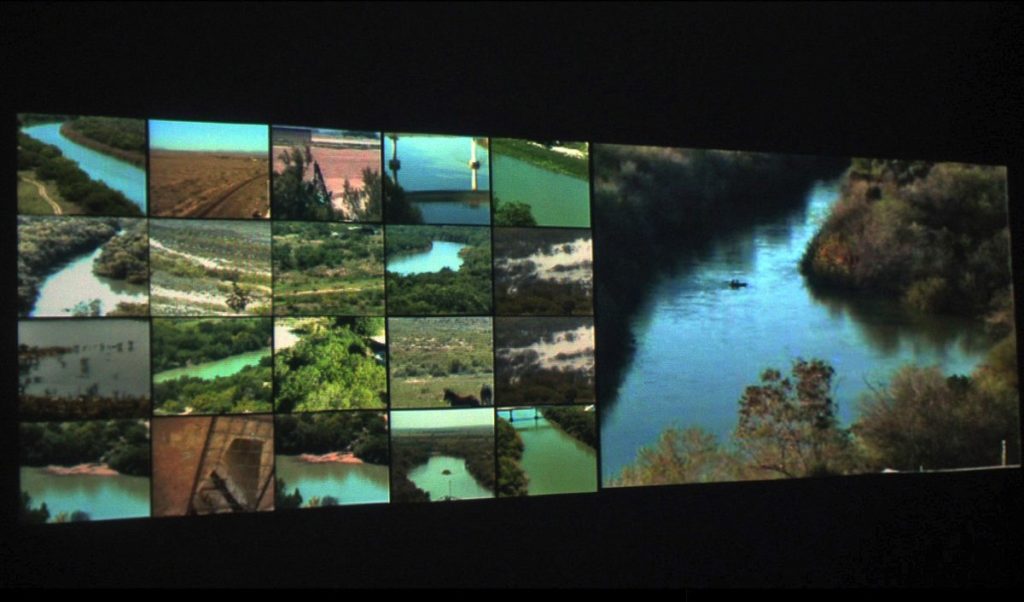
Marc Garrett: Before we begin the interview it would great if you could tell us when and where the exhibitions, events, publications and other parts of the project begin?
Isabelle Arvers: The AntiAtlas programme will run from 30 September 2013 to 1 March 2014 and will be composed of five initiatives: an inaugural international symposium, two exhibitions, a website and the publication of a book. The International Conference will be held from 30 September – 2 October 2013 at the New Conservatory of Aix en Provence. The main aim of this conference is to present the results of the interdisciplinary workshops that took place in the last two years at IMéRA et at the Higher School of Art of Aix-en-Provence.
The AntiAtlas of borders will present two interlinked exhibitions. The first will take place in Aix-en-Provence at the Musée des Tapisseries from 1 October to 3 November 2013. The second will take place in Marseille at La Compagnie creative arts centre from 13 December 2013 to 1 March 2014. The two exhibitions will present works developed in collaboration with social scientists, researchers in the hard sciences and artists. They will offer several levels of reading and forms of participation. Visitors will discover new works, engage with transmedia documentation and participate in experiments. They will interact directly with robots, drones, video games, walls and systems. The aim is to encourage everyone to reflect on how we are directly and personally affected by the transformations of borders in the 21st century.
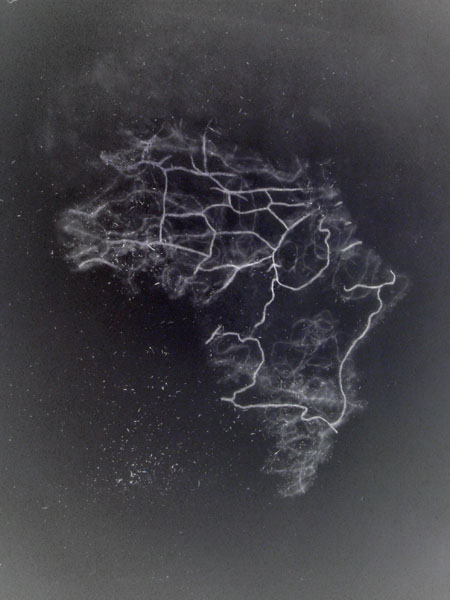
The final version of the website www.antiatlas.net/eng is an online extension of the exhibitions. Most importantly, the website provides access to works of net.art and artistic interventions in the form of an online gallery of works. This website and its documentation will extend the progress and reach achieved by the project. It will act as an archive and documentation site for the general public, artists, researchers and institutions.
In 2014, an AntiAtlas of border publication will be produced, gathering publications of researchers and artists on different and selected themes of the international conference and the two exhibitions.
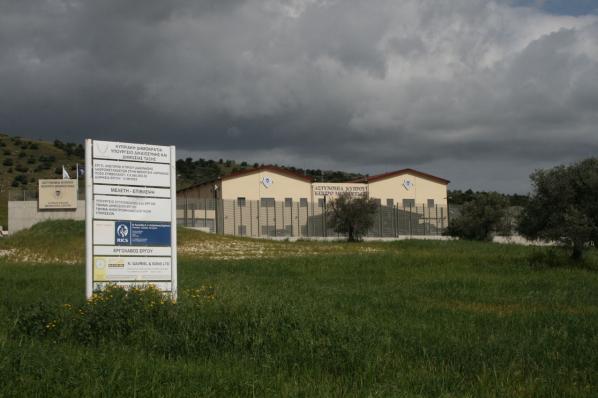

MG: What has been your involvement with AntiAtlas?
IA: When I met the IMERA team (the Mediterranean Institute for Advanced Research of Aix-Marseille University), they were looking for a curator in order to disseminate the outcomes of the past three years of seminars they conducted on borders. I saw this project as a great opportunity as there was a political dimension within it that attracted me. Also, I am deeply interested in tactical media and tactical geography and by new forms of visualisation and new aesthetics related to systems of control like drones, robots, satellites or surveillance cameras.
I wanted to create a participatory event that would allow people to follow our work online and offline. I also wanted to mix different kinds of works from research in the hard and social sciences to artistic installations, websites, games and videos. To do so, we decided to create a website www.antiatlas.net that would gather artworks, research articles and interviews, an online gallery and also all the presentations given during the different seminars conducted by IMERA on borders during the last three years. Thanks to the website, we were able to launch a call for proposals as I wanted to get the testimonies and the voice of migrants about their vision on borders.

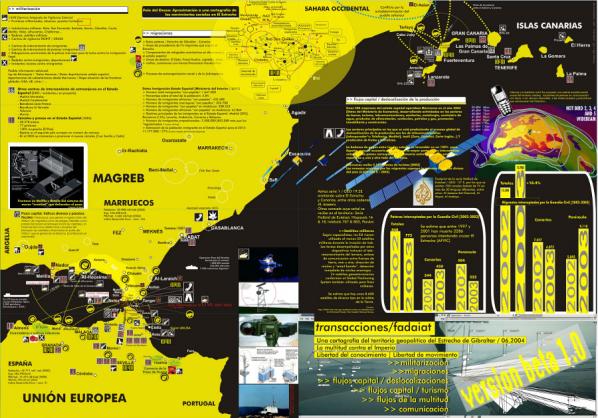
Very quickly we understood that we needed to get more funding and partners, so I offered to seek media, private and institutional partnerships as well as to manage the communication of the entire event. This fundraising was needed to promote a global vision of the antiAtlas of borders and to link all the parts of the event: from the website, to the call for proposal, till the international seminar and the two exhibitions. Because of my multiple engagements in the project, I became one of the 5 co-producers of the programme.
MG: This is a complex project. It is noticeable that there is a diverse and dynamic, cross section of different practices being bridged to make it all happen. Has it been difficult to combine all of these practices so they can relate to each other coherently?
IS: Combining all these different practices was a wonderful and exciting adventure. During one year and a half, we worked very closely with the scientific and artistic committee and tried to exchange as much as possible between different visions and ways of working. I learned a lot from researchers and was amazed by the deep understanding and knowledge they have on the subject of borders. Thanks to their research and to their approaches to this issue, I was able to get a very diverse understanding of this complex subject. From me, they discovered the online communication and the power of the web and social networks to diffuse and share the information. They also got a better understanding of the tactical media field and we learned so much from each other that this experience is already a beautiful success in sharing and learning from passionate human beings. I come from media art world and I tried to respond to a scenario that the committee conceived with artists’ works, which is a very different way for me to work. This time I had a script to follow; the way I did it was to try to find some ludic interactive installations, as well as documentary projects or games, in order to allow the experimentation of the subject by the audience. They trusted me even if it wasn’t a field they knew well.
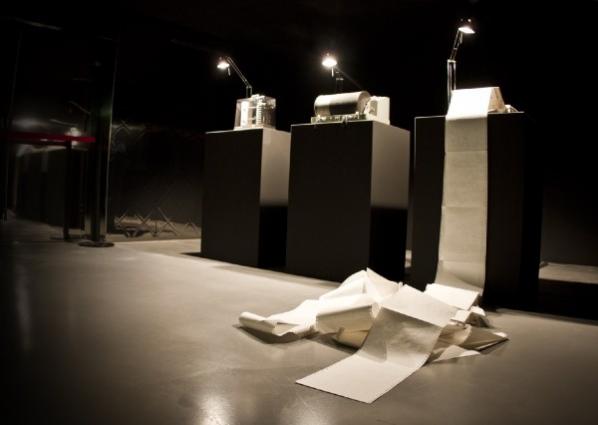
MG: Do you feel that it has de-compartmentalised these varied fields of knowledge successfully?
IS: What was particularly positive in the last seminars on borders we organised was that they allowed plenty of time to discuss and facilitate the exchange between the different perspectives. A specific example is a game project resulting from the collaboration between an anthropologist – Cédric Parizot – and a interactive laboratory from the Superior art School of Aix-en-Provence, which is led by the artist and game designer Douglas Edric Stanley. The idea is to create a “crossing industry game” drawing on the data collected by Cédric Parizot on trafficking. The collaboration addressed the visualisation, contextualisation and re-appropriation of a field of knowledge through game mechanics. I think that this experience really enriched all the team. The anthropologist was able to analyse his data in a different way, while the interactive students got closer to the reality of trafficking as they were experiencing through a game.
There are many other cross-disciplinary projects made in the framework of the AntiAtlas. I would say that what we want is to multiply different experiences and forms of knowledge on borders across and between the separate but intersecting fields of art and science. The exhibition is conceived to mix everything: research through the documentation space, researchers’ interviews, counter cartographies, interactive installations on biometrics and surveillance technologies, applications to divert control systems and documentaries providing a wider point of view on multiple dimensions of borders and their representations. Artists and researchers meet three times per year, some of them collaborate on trans-disciplinary projects, so that the conditions to meet and de-compartmentalise these fields are created. This is only the beginning. The process still needs to be pushed and facilitated as the antiAtlas is an attempt to create a new kind of cross-disciplinary encounter, let’s see how it will evolve!
This first interview with Arvers attended to organisational and operational aspects of the inter-disciplinary border-crossing within AntiAtlas project. The complex task of collating, sharing and collaborating to make it all happen at all could use its own map. The processes and engagements that evolved as the project took shape involved a collaboration of many different fields and practices, individuals, groups, organisations and cross cultural relations. This transdisciplinary approach helps us to unpack the deep levels of the meanings and value of crossing borders, in an organisational sense. Their dedication to transcend the seemingly ‘scripted’ blockages and restraints echoes a strong feeling that we need to re-assess the maps given to us, and what this means.
“What is needed to escape the modern mental “territorial trap” are ways of seeing and drawing that reveal what the geographical abstraction of the borderline obscures. It is only in this way, then, that we will acquire the necessary tools to think through a technologically enabled world of border flows and portals” Popescu.[1b]
Isabelle Arvers is an independent author, critic and exhibition curator. She specializes in the immaterial, bringing together art, video games, Internet and new forms of images by using networks and digital imagery. She has organized a large number of exhibitions in France and overseas (Australia, Canada, Brazil, Norway, Italy, Germany) and collaborates regularly with the Centre Pompidou and French and international festivals. http://www.isabellearvers.com/
Featured image: Drone Shadows by James Bridle
I met the London-based artist, publisher and programmer James Bridle in Oslo back in May 2013, as part of the conference The Digital City. Bridle was in Oslo to speak about drones, algorithmic images, and urban software. His most recent art projects, Dronestagram and Drone Shadows, have caught a great deal of interest by the popular press, with recent features published in the Wall Street Journal, Dazed & Confused and Vanity Fair. Bridle is no stranger to getting the timing right. Addressing issues of drone surveillance and invisible technologies in ‘leaky’ Snowden times, or manage to get a bunch of academics, writers and critics, to talk about the birth of a new movement – based entirely on a Tumblr-blog he called the New Aesthetic – surely qualifies as good timing. In our conversation, Bridle, or the New Aesthetic’s commander-in-chief as Vanity Fair calls him, reveals that he never really meant to talk about aesthetics. It is not the printed pixels on a pillow, so often taken to be emblematic of the New Aesthetics by its critics, that is of interest to Bridle. Rather, Bridle wants to encourage a conversation about the kinds of images and sensibilities that emerge from algorithmic and machinic processes, and the embedded politics of systems that make certain images appear (and disappear).
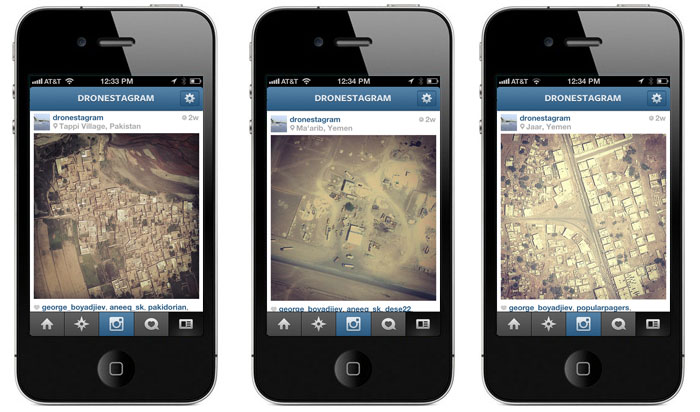
Taina Bucher: Hi James, would you care to tell us a little bit about your background?
James Bridle: I studied computer science and artificial intelligence at UCL, University of London. By the time I finished, I hated computers so much that I went on to work in traditional book publishing.
It quite quickly became clear through working as an editor and publisher that publishing was heading for crisis, because it is an industry that is full of people who are afraid of technology. So I went on to specialize in e-publishing, looking at what happens to books as they become digital, which gradually grew into an examination of other cultural objects, and what happens to them as they get digital and the nature of technology itself.
T: Do you think that your background in computer science influences the ways in which you think about art and artistic practices?
J: I consider myself as having a background in both, and I actually think that having the literacy in both is incredibly valuable.
T: Interesting, what does this literacy in art mean to you?
J: Being able to speak the language of it and to be able to communicate it. Not just having an understanding of it, but also to be able to talk to people in publishing and the arts about the Internet without scaring them, and also to be able to talk to people in technology. They are still two separate cultures but it is possible to translate between them.
T: Do you consider software or code to be the material of your artistic practices?
J: Sometimes. I do think though that this should be the last concern. There are different ways of describing the world; materials are just a way of expressing it.
T: How then does software influence the kinds of expressions that you create?
J: Not only the material, but also the ideas coming from software are important here. There are plenty of ideas coming from technology that become really valuable as they are applied in the arts, for instance from the tradition of systemic analysis. You know, breaking things down to basic principles, algorithmic type steps, is a really valuable tool of analysis. It is also a dangerous one, as it can give you a systemic engineering view on problems.
T: You’ve said that you’ve been accused of romanticising the robot, or rather, that the New Aesthetic has been accused of this. What do you think the critics mean by that?
J: Well I do understand it in a way, because one way of talking about these things is really to anthropomorphize automated systems. When you do that, you bring a whole bunch of other questions into it, like whether these systems have a separate agency or not, whether they truly see and understand the world in ways that we do not entirely understand, or whether they are purely tools of human imagination. In order to understand these things, I think sometimes it is necessary to take a position, you know, talk about it as if it is true, and then you learn more by finding out where that description breaks down and where it doesn’t apply.
T: What is the New Aesthetic anyways? An aesthetic of the digital, or a digital aesthetic?
J: I never really meant to talk about aesthetics. The New Aesthetic is not about aesthetics. One of the earliest keys to it was looking at some of these images that result from systems, looking at things like computer vision and how the world is seen through machines, but really this is a shorthand of how the world is mediated through technologies in all kinds of ways, not just aesthetically. The aesthetic is a starting point where you can visually notice these things, but I am really interested in what it reveals about underlying things. I am not interested in notions of beauty or the aesthetics of it.
T: We could also understand aesthetics in terms of ways in which something is made to appear in certain ways. To talk about software aesthetics in these terms, would imply the view from technology, as opposed to the view on technology.
J: Not only the ways in which these technologies influence the ways we see things though, but the ways in which we think about them and understand them is important. By using some technology you’re bound by some of its biases and if you don’t understand what some of these biases are, then you’re slightly fooled by them. There is always an underlying politics to these things, and if you’re not aware of it, then you’re a victim of it.
T: Is it the artists’ job to reveal these biases in a certain sense?
J: Don’t know about job, but yes, that’s why I am doing it. The interesting thing to me is to explore deeper levels of these things. Getting a bit closer to the meaning and the underlying biases.
T: How do you work with, or get at the biases of technology?
J: By exploring and getting a technical understanding of it, but also by looking at how technologies actually operate in the world.
T: Do you think that a certain sense of code literacy is needed then?
J: I struggle a bit with that. I think that I do, the way that I work. Having a technical understanding of how things work is really, really important. But I am always struggling to figure out if it’s possible to do that without having the possibility to read the code. It is hard to study a foreign culture without knowing its language. Put differently, great artists mix their own paint. They have a fundamental understanding of the material. I think that if you’re making work with and about technology, and if you don’t understand how that technology works, you’re going to miss out on a huge chunk of what the technology is capable of doing. There is a lot of digital art that is very, very basic, because the people who are making it don’t actually understand how it works.
T: Could we see your work as a kind of software studies?
J: Yes, probably could see it like that. Some parts of software studies definitely informs my work, concepts like code/spaces. My practice is situated between art and technology and the stuff that always interests me, is when domains like software studies meets other domains, for instance where software studies meets architecture. I’m really interested in architecture because it is such a situated practice. It is not like art or high-flown critical theory, which is kind of above the world; it really has to be rooted in the world. The crossovers are what are interesting. People like Eyal Weizman or Keller Easterling, who talk about how architecture shapes not just the physical domain, but also the legal and political spaces.
T: One of your projects that I really like is “A ship adrift”. Besides being a bot, how can we understand this “ship”? How does it work and which data sources does it use?
J: It is part of a larger art project in London called “A room for London”, which was a one-room hotel built on top of another building on the south bank of London in the shape of a ship. It was both a one-room hotel that you could book and stay for the night, and it was used for art things, music projects and other events. I was asked to do something that connected it to the Internet, to some kind of an online component. I didn’t want to do something that was totally separate, but something that was rooted in this idea of the ship, and its actual location. One of the major things is that it is a ship that doesn’t go anywhere. It fails at the first condition of being a ship.

I put a weather station up on the building to monitored wind speed, direction, and a bunch of other stuff, and took all the data from that, to drive an imaginary ship. For example, starting in January, and from the physical location of the ship: If the wind blows 5 miles an hour, my imaginary ship would move five miles east or wherever the wind was blowing. So this thing was driving friction-free. As it’s going, it knows its own location and searching the Internet for stuff nearby. It is looking for information on the web that also has a geographical tag to it. Good sources for that are Wikipedia as there are lots of articles that have a physical location tied to it, so you can look those up and read those in. My favourite source was Grindr, a sex network for Gay men that was geo-tagged. Unfortunately they did upgrade the security there three months into my project, so I no longer had access to that data. I was also feeding it other texts as well. There was for instance a sub-thread running through the whole project around Joseph Conrad who I’m a huge fan of. So I gathered all these texts and running really, really basic language generation text programs on it, the same kinds of programs that generate spam emails. So it is not intelligent in any meaningful way. It is really about how we read broken texts. I just quite love that, because it is really part of the vernacular of the web. It’s what language sounds like when it is broken through machines. It is also quite empathetic, and it makes us examine our own feelings towards technology.
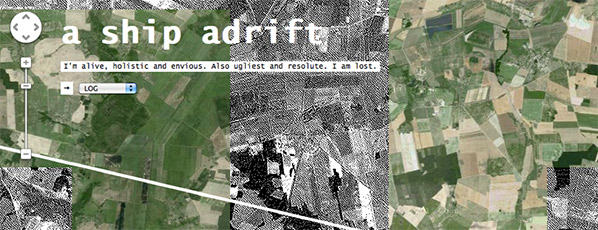
A Ship Adrift by James Bridle
T: Let me just quote you: “Forget controlling the machine; impersonate it. Fake it till you make it, like horse_ebooks, like A Ship Adrift” (Impersonating the Machine). How far would you take your own aphorism? Did your bot actually make it?
J: You can pick your criteria of success. My criterion of success is to produce an emotional response in me and in other people as well. And in this case, other people were really following along, particularly on Twitter. It had it’s own voice, although it was still generated by a semi-autonomous software system. It is not a bot really, it is not intelligent, it does not have agency, but it is generating a feeling about machines, which I think is important.
T: How did people respond to the ship?
J: Someone called it a ‘Robot Polari’. Polari is a European argot, which is almost gone now. Polari was a secret language that originated in circuses, travellers and theatre companies in the 19th century and became the secret language of gay men. It was a kind of coded language they used to communicate. Argots like that served multiple purposes. On the one hand concealing communication from the outside world that may be hostile to it, but also within the group, in terms of creating a bond between its members. So for me, the ship adrift felt kind of like an argot to the machines; machines kind of identifying themselves to each other, semi-protecting themselves.
T: There is a tendency to treat bots as ‘fakes’, as somehow inauthentic beings, which is really being framed as an increasing problem online. Why are we so obsessed with this notion of the inauthentic of that which is not entirely human?
J: That is a really good question. This problem of authenticity and technology extends much further. The whole New Aesthetic project springs in some extent from trying to understand what people consider being authentic digital experiences. I think we have this quite big problem, which is that we are so unsure with how technology operates that we have a deep distrust of it.
I think Instagram is a really good example of that. The entire mechanism of Instagram is predicated on applying the filters of analogue cameras to digital photographs, which for me is a process of authenticating. We are aware on some level that these photos are apparently less stable and less persistent than the photographs you keep in a shoebox, some server going down could delete them any moment. There is a precarity to them. We’re all the time trying to authenticate stuff, and all of this is tied to our fear and confusion around digital things.
T: It seems that questions of the invisible, or making what is seemingly kept from view visible, is a core element of your artistic practice. What is it about the invisibly visible and visibly invisible that intrigues you so much?
J: Take the drone programme. It is a political programme. It’s a natural extension of our international relations and we’ve developed a set of technologies to address these relations. The drone is perhaps the most emblematic and also a largely invisible one. It’s really been going on for the past decade, but it has only very recently become a very political issue. This is due to the fact that drones are largely physically invisible. They are secret technologies that no one ever really sees. In all kinds of ways: You don’t see them in newspapers, until very recently, and you don’t see them in movies. The invisibility is conferred by them being seen as technological objects. Because they are technologies, they are not criticized in a way that a policy, or a person, or human actions can be. Even though they are all about policies and human politics. Because humans in general, are not technologically literate, they just back off from that. For most people, it is just the way it is.
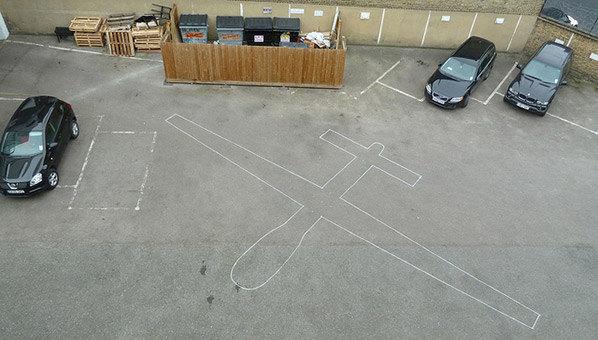
T: Would you say that it is the technology itself that is actually invisible, or the institutions and the kind of political work going on in the background of these drones?
J: Both of those things. This is where it gets interesting, because a lot of this technology materializes that political will. Stuff that would have been entirely secret previously, now exists as objects in the world. There is this incredible paradox, technologies both reify and materialize power and human desires, but are made invisible in a way that makes them beyond comprehension.
T: How have people reacted to your drone work?
J: Well, people have had discussions about drones they would not have had otherwise. But I hope that my work also raises questions about technology and the media on a deeper level, not just in terms of the drone programme.
T: Now that even our police forces are starting to talk about smart policing and using drones for surveillance purposes, what do you think would be an appropriate response?
J: I am not sure how the situation looks like in Norway. But London is the most heavily surveilled city on earth. Yet, we don’t talk about it much. For the most part everyone seems to be ok with that. It is a matter of technology, and thus easy for most people to ignore. If drones raise greater fears about surveillance, then maybe that will push back on all forms of surveillance. I’m not particularly more worried about drone surveillance than I am with cameras on a building. They are all functions of the same thing, but if it actually makes people think more about surveillance and control mechanisms then that is a fairly interesting way for it to go.
T: Maybe we’ll just end up in an overly visible state, where the amount of visibility goes counter to what it is supposed to do. If everyone is highly visible all the time, then the questions becomes one of analytics. How are we to make sense of this visibility?
J: The best I can hope for is a kind of democratization. We should all have access to them and be able to see through them as well.
T: What is up for you next?
J: I think I will have to take a lot of the momentum of this drones work and try and push it back up a layer to the political and legal space. I’ve never been interested in just the drones. I’ve always been interested in the wider implications of the technologies that they embody. So the drones are just the start, but there is a much larger conversation we should be having. So the question is how we can expand this conversation to those other areas and not just make it about weird sexy planes.
T: How does your work connect with social media? Do you use social media as a useful platform, or a point of critique itself? Does social media in any way change the possibilities of your artistic practice?
J: Yes, totally. I represent myself, and I have my own audience. It amplifies the things that I do, but I don’t theorize too much about it. That would be a whole rabbit hole to go down to. And I’m very well aware that I’m living inside, so it would be difficult to have such a critical eye on, because I’m so involved in it. I think that I will at some point though. One of the key tenets of my practice is not to perform manifestos, I don’t want to draw or come to any conclusions because I think we are at such an early stage with these social networks and social media, and the Internet in general that we don’t even have the critical frameworks to talk about it seriously, let alone come to any serious conclusions about it, yet.
Rick Prelinger, an expert on ephemeral cinema, was once asked to estimate how many educational and industrial films were made between 1930 and 1980, just in Canada, the UK and the USA. He gave a long answer but his ballpark figure was around 500,000. The true number may never be known, but it is safe to say that no single archive or university film library has collected them all. And in fact the trend in the last twenty years has been for institutions to get rid of their 16MM collections, given that the cost of storing and digitizing the material is so great. Many works have become “orphans,” having fallen through the cracks of official and commercial preservation programs, and having been abandoned by their copyright holders. Some such films suffer from having been poorly conceived and produced in the first place. Some have lost their educational value due to containing outdated information or out-of-fashion attitudes and imagery. But many are still worth watching (for various reasons) and nearly all can tell us something about an “other” history of cinema, and about the world and ideologies of the 20th Century.
Some 20 years ago, Skip Elsheimer stumbled upon a lot of 500 old films which he managed to purchase for a mere $50. And thus A/V Geeks, his Raleigh-based archiving club, was born. By now the A/V Geeks 16MM stash is among the most impressive collections in America–containing about as many titles as the George Eastman House (though not as many as Stephen Parr’s Oddball Films in San Francisco). Elsheimer now provides digitization services to clients such as Duke University and North Carolina State University, and has traveled around the country sharing gems (and stinkers) from his stacks. Earlier this month Elsheimer corresponded with Montgomery Cantsin (a fledgling archivist currently wanting to digitize 20,000 feet of 16MM) to discuss his experiences and knowledge in this area.
MONTGOMERY CANTSIN: So, you guys have 22,000 films?
SKIP ELSHEIMER: More than 24,000 now. I just got 400 films a couple of weeks ago and I’ve not updated the count.
MC: Which means what you have is among the largest collections of 16MM orphans in the U.S.A?
SE: Yes at some point, though, it’s less about how many you have and more about what you are doing with them.
MC: How long would it take a person to watch all of these films?
SE: I recently tried to figure that out–very unscientifically. I estimated that each film averaged roughly 15 minutes. It’s about 6000 hours. So 250 days of watching films straight through. If you devoted 40 hours a week to it, it would take you 2 years to watch them all.
MC: How many of these films do you watch in an average week?
SE: I watch maybe five or six new films. Unfortunately, I’m getting, on average, two new films a day.
MC: Did you study A/V preservation?
SE: Nope. They weren’t really teaching this stuff when I was in college in the mid to late 1980s.
MC: Have you found yourself to be eligible for grants to do what you do?
SE: I’ve not really pursued any but I think some are out there. I’m lousy at filling out paperwork.
MC: Any advice for emerging amateur 16MM archivists like myself?
SE: Well, my biggest recommendation is: don’t take on too much. It’s better to have a small well-curated collection than a giant collection where you’ve not seen most of the films. This is what I’m coping with. I basically bought a boarding house to house the collection and have to work to support it–this means that I don’t have time to watch those very films. It’s a little counterproductive.
MC: You raised almost $20,000 on Indiegogo. What makes for a successful crowdfunding campaign in your experience?
SE: Yes. Essentially, the crowdfunding project was a way to bring in money so we could block off time to watch and digitize the films in the collection that we hadn’t seen. It was very successful among the friends, family and fans of A/V Geeks but we really didn’t get word out as well as we could have.
MC: Alongside the well-established discourse surrounding “orphan” films, you seem to have initiated a study of the “bastard film.” Can you talk a bit about this?
SE: Well, I had always wanted to host a little symposium. Something were folks could show films and then talk about them afterwards. The first Orphans Symposium was like this and I learned so much then. So, as a joke, I said to some friends that we should have a Bastard film symposium–not really thinking about it as a genre. But after we announced the symposium, a genre started to appear.
MC: Was anything extraordinary unearthed at your recent conference?
SE: There was some amazing stuff. The schedule is still online. I liked the fact that we gave a loose definition of “bastard film” and folks ran with it. Everybody had a film that they’ve always wanted to show an audience but not their average audience–they wanted to be able to show the film to an audience of seasoned film archivists (collectors and academics who would get why the film was a bastard). Also, we made the seminar very screening-centric. We limited introductions to only five minutes (and had an official egg timer to time it) and encouraged discussion at the end.
MC: Was it you that curated the collection called Cartoon Propaganda? What can you tell me about that?
SE: Yes, it was one of my first compilation shows. I’ve since revised it–calling it Anxious Animated Agendas.
MC: Do you know of any evidence demonstrating that CIA fronts produced educational films during the cold war era?
SE: Well, there were a lot of conservative organizations that were making educational films in the United States–because there was a big conservative swing after WW2 and anti-communist slant. The United States Information Agency–our propaganda wing–made lots of films that were distributed around the world.
MC: Yes, since the CIA covertly funded much of that anti-communist “cultural” and intellectual activity, [as outlined by Frances Stonor Saunders in her book Cultural Cold War], I would think they would have had front companies devoted to film production.
SE: It’s possible but really probably wasn’t necessary! The status quo was so conservative and anti-Communist after WW2.
MC: How well-versed are you in copyright law and fair use? How much does it matter that you be well-versed in the laws to do the work that you do?
SE: I’m pretty well-versed–although I’m always learning something. To exploit the films for stock footage use, I have to know something. Also, it’s useful when YouTube issues a take-down of a clip. I have at times been successful in getting things put back up.
MC: Can you talk about one or more of these take-down cases? Did you cite Fair Use? Have they ever wrongly taken something down that was Public Domain?
SE: Yes, they have. The most recent one was where I posted a Sid Davis film called “The Bottle and the Throttle.” It was taken down within 24 hours because it supposedly had content from a Neil Young video in it. I looked at the Neil Young video and realized that it was a bunch of edited Public Domain films–and it even stated so in the video’s description. I appealed to YouTube and it took them about a month to respond. In the meantime, the video was down and I wasn’t allowed to upload anything over 10 minutes–as a punishment. Anyway, in this case, I didn’t have to cite Fair Use. The material in question was in the public domain.
MC: Isn’t your main purpose educational? Isn’t any educational re-use, even of copyrighted material, protected by Fair Use?
SE: There are a number of considerations before you can claim Fair Use. This includes the “purpose and character of the use;” the “nature of the copyrighted work;” the “amount and substantiality of the portion used;” and the “effect of the use upon the potential market for, or value of, the copyrighted work.” Posting educational films in their entirety on the internet knocks out three of the considerations. I’ve been very careful (I’m on my 4th YouTube account) to only post Public Domain stuff.
MC: Do you make ad money on Youtube?
SE: I make a little bit. Like, pennies per a video per a month.
MC: Have you been to Europe to show films?
SE: I’ve not. It would be a challenge to me as a lot of my programming deals with American culture and irony.
MC: Have you met any producers or directors of old educational films? I know Katharine and Bruce Cornwell just passed away recently here in Brooklyn. (I’ve been showing their 1979 film “Dragonfold” to audiences lately.) I know AFANA in San Jose, CA has profiled various makers on their website, such as the Cornwells and Bert Van Bork.
SE: Yes I’ve talked with a couple of producers and lots of people who appeared in the films. That’s one of the benefits of putting these films online–the filmmakers and crew come out of the woodwork and rediscover their work.
MC: Can you describe some special films of yours that are near to your heart?
SE: Depends on the day, but, right now, my most special is the A & B roll from my favorite music video of all time, Renaldo and the Loaf’s “Songs for Swinging Larvae.” Also, I like “Pride on Parade”–an Oscar Meyer film about high school marching bands and making lunchmeat. And, “Tire Rigging Demo”–a promotional piece to show off a new camera rigging that films automobile tires on the road.
MC: Take us through the mental process of determining what films go on to your digitization priority list.
SE: That also depends. With last year’s digitizing campaign, I let those that donated pick from a list of 2000 films. Then I would sometimes pick other films that fit with their lists. Now, its based on projects. If I am working on a project that requires digitizing some film, I’ll upload all the films that are in public domain. Also, sometime there’s a holiday or current event that will have me dig in the collection and try and find appropriate Public Domain films.
MC: Thanks for your time.
SE: Good luck!
Learning with the Lights Off: Educational Film in the United States by Dan Streible.
The Public Domain by Stephen Fishman
Since the Nineties (at least), Mckenzie Wark has been writing colorful and critical texts that have raised the bar in countless conversations regarding networked culture, “weird global media events,” the philosophy of open source, game theory, and so on. He’s also been known for his active and ongoing engagement with a certain body of ideas associated with the Situationist International (S.I.)–a coalition of subversive thinkers and doers who coalesced in Europe around 1957 (to drift, drink, and détourn). Wark himself came of age in the (post-situationist) 1970s: a decade where, as he says, “everything turned to shit.”
…In spite of everything having already turned to shit, Wark kindly met with Brooklyn’s Montgomery Cantsin on the 16th of May, 2013, in Manhattan. Prior to a show and tell–of Wark’s 3D-printed Guy Debord Action Figures (“His action is smoking,” says Wark) and Cantsin’s metagraphic tattoo (from a design by Isidore Isou)–the two spoke briefly about philosophy, history, science, and technology. Wark was on his way to the U.K. where in addition to having an event at Furtherfield he’d also been booked for a speaking engagement for his new book (Spectacle of Disintegration–just published by Verso), where he’d be right alongside the Situationists Alice Becker-Ho and Jacqueline de Jong.
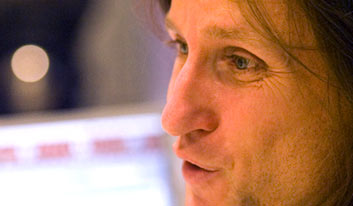
MONTGOMERY CANTSIN: According to Anselm Jappe, “technology levels a more telling critique of everyday life than does poetry, for it is able to challenge current everyday experience w/ realizable possibilities, not with mere reveries.” He also notes, though, that under existing conditions (of uneven development, etc.), technology “constitutes a new kind of alienation.” Your thoughts?
MCKENZIE WARK: First, we ought not necessarily think of the poetic and the technological as separate categories. They are always entangled with each other. The interesting moments in poetry–not always, but often–coincide with new technological affordances, new ways of communicating. I wouldn’t want to see those as either/or categories. (Poetry is a technology; technology is poetic.) It’s always worth looking for the breaks. When a technology is relatively new, no one usually knows what the fuck it’s for or what to do with it, and that’s kind of a moment to try to play with it and sort of elastically stretch out the boundaries of it and establish a beachhead for struggling around what it can be like and what you can do with it. At present though, we are entering more of a moment of consolidation with how technologies work. In the Eighties and Nineties there was this huge opening of spaces and possibility, and now an enclosure is returning.
MC: Facebook comes to mind here. Can a situationist perspective show us how to disentangle ourselves from that whole mess? Should we hope that there can be “situationist uses” of social media?
MW: Yeah Facebook wants to, in a sense, control historical time as people experience it. That’s what ‘timeline’ is. But there are always little affordances. Part of the legacy of thinking in the wake of the Situationists is that you have to understand what the tactical openings and gaps and spaces are that are available to you, and to in fact not see it as a sort of ‘expressive totality’ where everything is always and already saturated in advance with the totality of capital or spectacle. To some extent that is a correct diagnosis. But it’s also not the whole story. And that’s why, when one reads the Society of the Spectacle,[1] it is the second-to-last chapter that is the one that counts. The second-to-last chapter is about détournement, it’s about the way that you appropriate and use the whole of poetry and technology as always and already belonging to all of us. You act on that basis, self-consciously. That’s the struggle, that’s the strategy. And, to the extent that there’s a learned capacity to to struggle in and against things like Facebook, I say let’s credit the struggles of the Eighties and Nineties around free networked communicative cultures and practices. Those in fact originally started as an avant-garde (of thirty or so people); [such movements] seeded certain tendencies into the mainstream.
MC: If blanket surveillance of telecommunications is a given, if all our emails and texts are being monitored, I suppose one is forced to wonder, is there is any point in staying away from Facebook?
MW: As I’ve said elsewhere, it is the height of vanity to think that you are under surveillance. No one gives a rat’s ass about most of us. But yeah, we ought to just assume that data is being collected about all of our lives for possible future use. You can just kind of assume that. And so then [what’s called for] is a counter-tactic of a certain nuance and unreadability and opacity about everyday life–to not announce everything in advance, and to not be careless with language. To try pass silently in some things. You know, before the Situationist International was even constituted, the police arrived. And Guy Debord writes about this in a letter, I think to Gallizio. Reading his version of it, it looks like the way he avoided the police trying to proscribe them is, he pointed out “We haven’t even been constituted yet!.” So the S.I. as an organization was under surveillance before it even started! Even though the S.I. was a minor insignificant organization in its time–in the moment of its founding, it’s like half a dozen people–there was always a certain carefulness, an opaque quality. Not everything has to be said to just everyone. So, act on that basis.
MC: Can you say more about secrecy, or opacity? I wonder, what does Stewart Home (or Len Bracken) achieve by bringing up secret societies in the context of discussing the S.I.?
MW: Stewart Home is actually one of my favorite contemporary writers and his interest in the S.I. is in the context of an astonishingly broad knowledge of avant-garde art and literature, and the culture of his own city (London). As for the occult, I personally have no interest in the occult, but the idea of opaque social realms is something that Stewart has an interest in (and I do too). There’s a sense in which the S.I. at various stages is doing that. There’s a difference between the internal communication and the external one. And it’s useful to look at because it is so different from the spirit of our times where everybody is just tweeting to everybody every fuckin’ last thing they did. The idea that you can create this little circuit-breaker, this internal conversation that’s separate from the external one: it’s a kind of a useful valid space in which to operate. […] Not a secret society, but a discreet group. […] Interestingly, Stewart is extremely uninterested in the Debordian strands in the S.I., and to me he was a really important voice in moving away from seeing it as centered on Debord. And when I wrote Beach Beneath the Street,[2] his was one of the voices I was responding to. There I wanted to sort of synthesize the stuff about Debord with this anti-Debord strand of which Stewart’s a key representative–to put these two back together again. The second book, Spectacle of Disintegration, sort of does that as well. There’s like whole chapters on Sanguinetti and Vienet, and Vaneigem. And a lot of material on Debord’s films–with that I tried a lot more than I think Stewart ever would.
MC: Home claims that Debord’s films are sort of stuck in the avant-garde gesture–the whole “end of cinema” thing. But you show that Debord’s later work is actually not like that. It’s richer than that.
MW: It’s a valid point about his early films, though I think that they are defensible in other ways and there are resources you can get from looking at that stuff. I think it was really important for Stewart to say “No” though, because there was just so much repetition of this Debordian “specto-Situationist” stuff (as he calls it). He was right, it was boring. If you look at the people who were just imitating that: it was boring as all hell. (All they have to say to you, or to each other, is: “spectacle!” and “recuperator!” Its boring.) So, Stewart shuts that door and opens these other ones. And he’s doing a sort of détournement of that, into another space that’s much more Anglophone. Stewart draws this into a whole series of British and Anglophone traditions successfully.
MC: You note that that Simon Critchley views the Situationists through a sort of religious lens? To which of Critchley’s books are you referring here?
MW: Yes it’s in Infinitely Demanding.[3] One of Simon’s core propositions, and it’s an interesting one, is that “philosophy begins in disappointment.” There are two kinds: religious disappointment and political disappointment. He actually classifies Debord as almost a theologian of disappointment. (That’s my phrase, not his. But that’s how I’m reading what he does there.) So once you have a disappointment, then your consolation is philosophy as a high theory tradition. There’s also a low theory tradition though, and it begins in boredom with these discourses of disappointment. So, how does one–in an interstitial space outside of cultural and academic institutions–produce a critical language of the everyday itself, where what it’s going to do is write and think with extremely broad horizons? Well, the practice of the everyday will always fall short of that horizon. One is only disappointed though if one has a naive idea about thought’s ability to dominate life in the first place. The fact that you cannot practice what you can theorize: that is the very thing that makes both possible. So, it’s not a failure of praxis when your ideas and action don’t align. That is the praxis. The gap is the thing. You think that relation in its irreconcilability. Disappointment is just a moment in thought. And then one’s bored with that. You try it again, and in a sense you do not give up. As Asger Jorn says: “The avant garde never gives up!” That struggle of thought opens horizons which get foreclosed and then you open another one, so it’s kind of a tactic of reinvention.
MC: How can the S.I. assist us in addressing questions that are outside the realm of science, or maybe outside of the knowable?
MW: I think it was Andre Breton who said “Science is useful for the solution of many problems, all of them unfortunately of secondary interest.” (There’s a certain poetic hubris about that, perhaps even more evident in our time.) A scientific method isn’t going to deal with unclassifiable, undefinable problems–those are really more in the domain of a tactics. Where Debord is useful for that is in the way he thinks through Clausewitz. Clausewitz is one of his key figures. In Clausewitz there is a kind of continuum from pure unreflective action to rational strategic thought. And for him it’s kind of a hierarchical relationship where the state has a rational motive but the field commander is kind of responding in this kind of affective way, and troops are pure action. Strategy is in between, in a sense, mediating between reason and action. It also just happens to be fairly close to how Sartre thinks the situation as the space where consciousness and its other confront each other in a domain that’s not knowable in advance and that’s only discovered in the act. That’s why it was called the Situationist International, after Sartre. Debord borrows the word “situation” from Sartre, but more about the actual practice from Clausewitz. Clausewtiz doesn’t call it a situation, to him it is the friction and fog of war. I think Clausewitz is Debord’s main guy though. And I mean more Clausewitz’s descriptions of campaigns rather than On War. On War has this kind of pseudo-systematic quality, whereas when Clausewitz writes about Napoleon’s defeat at Waterloo or Napoleon’s Russian campaign you really get this sense of struggling with the parameters of the unknown. And there you need this other knowledge, this other practice. Debord thought the art of war was a good place to look for a ‘sober’ assessment of situatons, without the silly chatter of optimism associated with ‘politics’. Maybe in our time we could pay close attention to the applied sciences as well. In some ways the limit to the later, so-called ‘political’ phase of the S.I. is that it shut down dialog with different ways of knowing and acting–from architecture, urban planning, and so forth. It bought a certain theoretical rigor at the price of shutting down certain tactical elbow room.
MC: I’m waiting for someone to put Debord into conversation with Paul Feyerabend, given the latter’s discussion of an epistemological anarchism…
MW: Well, I don’t know what to say about Feyerabend, I haven’t read him in twenty-five years. But he is in fact back on my shelf here on the reading list as part of this opening back up to the sciences. I know he’s an important moment in getting us out of a sort of narrow idea that there is a (single) scientific method […] to pluralizing that and showing how it’s a class of experiment. Even dada is a metaphor we could use for it. A science is not like poetic dada. A science is bounded as a set of practices in a way that art isn’t. But yes he’s one of those really key voices in a kind of plural epistemology, that there are different kinds of knowledge. A problem of our time is knowledges don’t have hierarchies, they have relations. So, what’s the non-hierarchical relation between different knowledges that do different things? That seems to me to be a very contemporary kind of issue. The S.I. kind of fails at that and it’s kind of interesting to the extent that they do. (Some of the Clausewitzian hierarchy lingering, perhaps.) They’re sort of not able to weave together even art and writing–to transcend, to get out of them. It’s notable that Constant’s interest in a kind of speculative engineering approach to the world doesn’t fit with what would be Vanegeim’s more writerly version of unitary urbanism. In a way, they’re still stuck in this command discourse and it’s a certain theoretical one that I think’s not helpful, as if theory was in command. One needs to be able to put these things alongside each other and not try to reconcile them. Irreconcilable qualitatively distinct kinds of discourse can remain separate–they don’t have to be synthesized. They can have linkages and border conditions and things like that.
MC: It seems that the S.I. found itself incompatible with the early ‘cybernetic’ thinkers. Your whole body of work seems to suggest a certain potential for linkages.
MW: The situationist who got it first as far as what cybernetics implied was Constant. He was reading Norbert Wiener on the ‘Second Industrial Revolution.’ He pretty much “gets it” that something like the internet is going to happen and that it will totally spatially reorganize the planet. Constant arrives at that realization right in the early sixties, it’s astonishing. And look, every single great utopia or avant-garde always comes true. All of them are realized, but one element is always reversed. There’s always like the key that element doesn’t happen. With Constant, its a big one: it’s that we didn’t abolish private property. Communication spatially re-organizing the planet–that’s exactly what happened. But, it’s not re-organized in the way that he imagines. He was right about that–that the spatial reorganization would happen–but not which one. He was still thinking that we could abolish work, whereas what we did was find new pools of cheap labor. […] That’s gonna rattle on for another century, the exploiting of the last pools of cheap labor. Though it seems like Chinese workers are already bored with this whole thing, so capital (or whatever this is now) is trying to move to Indonesia and Vietnam and so forth.
MC: DARPA’s creating machines that mimic the most subtle movements of the human hand, but–
MW: –Right, but we’re not abolishing labor. It really is the case that these relations of production are a fetter on the achievement of another life. We have not made the qualitative break. But, the tools are there. There’s a strand in the S.I. that’s very interested in this: The fact that the means are there. It’s in early Debord, it’s in Constant. Jorn and the later Debord have a more anti-technological feel to the way they are writing. But still though: Debord’s using cinema–experimenting with that. Vaneigem does occasionally hint that cybernetics has the tools there to create the good life but it’s being used for the opposite purpose–being used for control. He doesn’t have a whole lot to say about it, but there’s this kind of intimation in Revolution of Everyday Life, there’s something there, which is kind of prescient. Its not quite as brilliant as Constant’s conceptual architecture though. Constant imagines a world of the control of things as the infrastructure for another cybernetics, the free play of the human.
MC: Anselm Jappe talks about two different strains in Marx: 1) Liberation from the economy and 2) Liberation by means of the economy. Can you talk about this, maybe in the context of your reply to Nick Land’s “Accelerationist Manifesto?”
MW: Well, you have to go through one to get to the other. It’s Marx’s version of Nietzsche’s “God is dead.” There’s no going back. What we take to be the sort of romantic pre-capitalist worlds that we would want to return to (and in the name of which we might resist) are illusions produced by capitalism itself. In a sense, the machine has to go to its end and break down in order to then use its resources to build something else. So if we restrict the meaning of Accelerationism to that, Marx is one of them. There isn’t a going back. There’s only going forward. There is no resisting, there’s only trying to push things in a certain direction as they sort of rocket towards the end. The thing I like about the Accelerationists, well the first thing, is Nick Land is just a joy to read. I read it as sort of a “fatal strategy.” Some people reacted badly to it, like “OMG he says that the machines have gone cellular and are evolving without us and we’ll just be redundant!” Well, it’s like pushing a certain rhetorical logic as far as it will go; it’s Baudrillardian. It’s really quite beautiful, and a delight. People have pushed back against that and tried to extract elements from it. And to re-animate the futurist element of the avant-garde strikes me as a really contemporary thing to do. The one thing that’s probably unassimilable to “contemporary art” is the futurists. (By definition–it’s outside the frame of there being a contemporary.) Is there a way to revive the futurist bit of the avant-garde legacy or to détourn it in a way that cracks open this now all-encompassing space of so-called “contemporary art?” That would be kind of promising and it looks like the Accelerationists have made gestures in that direction. So, it’s like, more power to ’em. Great.
MC: How are we to make sense of things like the recent London riots (or the Stockholm riots) maybe as compared to the Thailand revolts you bring up in Spectacle of Disintegration? You’ve characterized certain happenings (Tiananmen Square, OWS, the 1987 Stock Market crash) as “weird global media events”–
MW: –Yes, and each of those four terms is kind of key. Weird in the sense that these events are singular and there’s a strange space-time that’s specific to them. It exceeds the space of the city. There’s a global communicative space to which it’s connected. International relations, flows of money, flows of military force, and flows of information get drawn into the event. There are particular affordances of the media that are embedded in a particular space. You have to see media and the architecture as a continuum. Media’s not a separate element. Communication and architecture are the same thing, they’re cognate–just different dimensions–and you have to understand the particular arrangement of that. In the case of Tiananmen Square, we have to ask: How was the government able to insinuate troops into the city, and in which particular directions? What were people’s particular lines of retreat? How did the global feedback loop of international news media work? (People locally were relying on international circuits of news to figure out what was going on mere blocks away from them.) That sort of stuff. Then, as far as the last term in that phrase, it’s an event. (But not in Badiou’s sense, mind you.) Really what I think would be a better word would be situation–where some variables are known, some are not, and one has to act strategically and try to understand lines of force. “Weird global media events” are not a constant in the way that a riot is (there’s always a riot going on somewhere); these events break out of routine spectacular space and time. Debord is all about how the spectacle erases historical time. And yet I think he’s still holding on to the possibility that historical time erupts. We’ve seen that it does.
MC: So, not all events are necessarily immediately recuperated into the spectacle…
MW: One definition of ideology is: the story precedes the facts, and you fit facts into an accepted story. When you have apparent facts that fit no story, then all hell breaks loose! And you get these really interesting moments that are like breaks in transmission, wherein the spectacle has no idea what it is supposed to be narrating! And Tiananmen Square was one of them. It’s not that ‘the truth’ is there, it’s more like ideological confusion is there, where occasionally fragments of the actual event can be deciphered. Next time it happens, hit the RECORD button on everything and gather all that stuff! A classic example is 9/11. We’re now down to like three images of that event. If you watched it live on television you saw people jump out of fucking buildings. That image is completely censored now! It’s never to be experienced. But you saw it happen live on television. Astonishing stuff. There were people saying extraordinary things about what was going on around them but it’s all been sort of fitted back into this neat narrative about, you know, we have to keep insisting on the heroism of the first responders. The thing that can’t be uttered is the absolute confusion of the first responders! That the police and the fire brigade had no fucking idea what to do is part of the real story, but that is unutterable. So yeah, when the weird global media event happens, pay attention.
MC: Your new book looks at current terrorism as well as that of Italy in the 70s. The young Italian Situationist, Sanguinettii, was writing of ‘false flags’ some 25 years ago. That term ‘false flag’ is perhaps drained of its meaning at this point, largely associated with the loudmouthed paleoconservative buffoonery of Alex Jones (who you also mention briefly in the book). Do you think there are contemporary conspiracy researchers though who are worth reading? (Len Bracken’s book Shadow Government comes to mind as something that also considers 9/11 in relation to Italy and the “Strategy of Tension.”)
MW: It’s not something I pay attention to, and that stuff tends to be based on an image of states being able to create events rather than just react to them. I think the other line of thought is more interesting. It’s not that states have this omnipotent, omniscient ability. The opposite case (that states have this enormous power but have no idea what they’re doing anymore) is kind of a more interesting line of thought. The problem with Sanguinetti is that it does depend on there having been a conspiracy in a sense, that the Italian state directly produces the Red Brigades through manipulation of these activist cells, through agents provocateurs and so forth. There’s evidence that that might have been the case; Italy in the seventies is crazy. But what I think is a more useful line of thought is: it doesn’t matter if people are secret agents of the state. If they create terrorist cells, they’re acting as the state even if they don’t know that they are! They’re the dupe of the state. And not even of the state, but a ‘secret’ state. That strikes me as a more interesting way of processing that kind of Italian moment. Tracing down the actual who-planted-who-where part is much less interesting than the actual fact of these armed cells kidnapping people and murdering them. It’s a part of the state itself even if it is unintentionally so. It’s like a rogue cancer cell of statism being produced somewhere. That strikes me as having more purchase on the quality of those kinds of events.
MC: In Spectacle of Disintegration you make a distinction between Hegelian and non-Hegelian Marxism. What thinkers exemplify the latter category, Althusser…?
MW: Althusser would be one example. I think Asger Jorn would be another, because he gets his Marx mostly actually from Engels. Asger Jorn is underestimated as a theorist, he’s actually really interesting. There are other non-Hegelian schools. There were the Italians, like Della Volpa. There’s actually kind of several. And in English there’s a neglected Anglophone (mostly British) reading of Marx that goes through Ricardo and is much more attuned to the political-economic background and less interested in the philosophy. I’d also say that Marx himself is a master of détournement. I’d make the claim that that’s what he does with Hegel! It”s not that Marx is a “Hegelian.” It’s that Hegel is a useful thing to steal in order to describe the logic of the commodity. Literally Hegel’s Logic becomes the tool that is détourned to explain the commodity. But there are other parts of Das Kapital that aren’t Hegelian–that draw on other sources. Marx is oriented around a task–so he borrows heterogeneously from different sources and uses them. This is as opposed to being a philosopher who continues a tradition. So, of course all these different schools read different bits of Marx and re-assimilate him to the academic method. But that’s not what Marx himself is about. He’s not a philosopher; he’s not an academic. As Althusser says: Marx did not read ‘library Hegel’–he read the Hegel of the young Hegelian movement.
MC: Is Debord being a romantic when he makes reference to a “life lived directly?”
MW: Elements of the young Marx show up all over Debord, and that’s what Simon Critchley is drawing attention to also: this version of the young Marx that reads alienation as alienation from a species-being that pre-exists capital. I think later Marx lets go of this sort of skyhook idea of our species-being as an essence. He’s much more interested in our collective self-production of ourselves as a species. More in a Darwinian sense, as a population–where it is by and through capitalism that we are producing ourselves, and there is no pre-existing ideal form of the species-being that could act as a reference. Debord I think mobilizes the young Marx tactically. I don’t think those gestures in Society of the Spectacle are the essence to which I’d wanna reduce Debord. I don’t want to assimilate him to the Hegelian Marxist reading. I think he détourns the young Marx, where it seems useful to do so, and when it isn’t–someone else. The key to Debord’s texts and films is détournement as the method of composition, not picking particular fragments out of the construction.
MC: Anselm Jappe takes Lukacs to be a key influence on the Situs; Jappe’s book on Debord makes reference to this “minority tendency within Marxism that assigns crucial importance to the problem of alienation, considered not as epiphenomenal but as crucial to capitalist development.” You say however that Lukacs is in fact repurposed by Debord (rather than being cited in a traditional sense). Does Jappe miss this?
MW: First, it’s gotta be said that a lot of the secondary literature on the Situationists is actually really good. I think there’s enormous merit in all the stuff Ken Knabb did, and in Stewart’s provocation The Assault on Culture.[4] Sadie Plant’s book.[5] And Greil Marcus’s book, which of course really put this stuff back on the map. Despite what everybody says, this stuff is all great. And the Anselm Jappe book, well, he knows the Lukacs dimensions of this much better than anyone else does. It’s just that for me there’s a crucial difference between a citing of Lukacs and a détournement of Lukacs. To me, the key to Debord is détournement. It’s all about Lautreamont, not Marx. Debord absorbs all these Marxist elements into this avant-garde practice of détournement. And in fact Jappe is one of the great places to find out exactly what bits of Society of the Spectacle are détournements of what! He even has a little list: “Well, that chunk is straight out of Hegel, and there’s a bit of Marx, here’s a bit of Freud, right there.” He doesn’t make enough of that. To me it’s like “Oh, so what you’re reading is a kind of patchwork of chunks?” I think it’s that performative dimension of the book that is what really makes it. I give Society of the Spectacle it to students sometimes and they say “well it’s not really coherent.” Well, it’s method is absolutely rigorously coherent! You’re looking at the wrong level [if] you’re looking at the product and not the process. So, you have to look at the constant use of détournement as process. It’s the one thing Jappe is not quite attuned to in what I otherwise gotta say a really excellent book (from which I learned a lot). […] I think, even though there’s all this great stuff on the S.I. already out, the job’s barely begun of making sense of it in a way that can be used by people to produce new work. As far as the literature that’s there: there’s not enough keys to how to détourn the S.I. and produce something different in a qualitatively different environment.
MC: Is it possible that Debord’s melancholy and/or paranoia sometimes got the best of him, I wonder? Today he’d be called depressed. What would a therapist today even do with Debord?!
MW: Well a therapist would just say he’s a hard case, he’s a career alcoholic, you know. And it’s not to be gainsaid, one of his most beautiful pieces of writing is about drinking. “I’ve written much less than most people who write but I have drunk more than most people drink.” He writes so beautifully about it (although that’s probably détourned from somebody). Elsewhere he writes “There are those who got drunk only once but it lasted a lifetime.” I’m not recommending this by any means! I’m not a drinker. But it’s a certain kind of life. What is of value in the biographical dimension and why I don’t want to just write about theories but to write about the life-dimension to it, is, what are the ways that you can learn to create zones of autonomy in your own life? And they’re always gonna be partial. And perhaps should only be partial. (We ought to have obligations, perhaps.) But how can you have some autonomy in what your life is for and about? Debord’s just one of the great lessons in how to do that. It’s not that he owed nothing to anyone–he had patrons. There’s a way in which that may be a very 21st century idea (now that it’s just the “1%” and the rest of us). The rich really are different from you and I, and it’s not just that they have money. It’s that they live in a separate universe. But their lives become so boring; they wanna be patrons of things. In a sense we can no longer work in publishing or the university or journalism, all these zones are foreclosing. So, how to have a patron is something you could probably learn from Debord.
——————-
McKenzie Wark will give a talk at the Furtherfield Gallery about his latest book The Spectacle of Disintegration – Situationist Passages Out of the 20th Century.
Writer and academic Dr Richard Barbrook will give a short introduction to Wark’s work and to Situationism and its relevance to contemporary culture.
Saturday 25 May 4-5.30pm
More information:
http://www.furtherfield.org/programmes/event/mckenzie-wark-presents-his-latest-book-spectacle-disintegration
The Spectacle of Disintegration, Verso Books, 2013
Telesthesia: Communication, Culture & Class, Polity Press, 2012
The Beach Beneath the Street: The Everyday Like and Glorious Times of the Situationist International, Verso Books, 2011
Gamer Theory, Harvard University Press, 2007
A Hacker Manifesto, Harvard University Press, 2004
Dispositions, Salt Publications, Cambridge, 2002
Speed Factory, (co-author) Fremantle Art Centre Press, Fremantle, 2000
Celebrities, Culture and Cyberspace, Pluto Press, Sydney, 1998
The Virtual Republic, Allen & Unwin, Sydney, 1997
Virtual Geography, Indiana University Press, 1994
Roger Malina is a physicist and astronomer, Executive Editor of Leonardo Publications (The M.I.T. Press), and Distinguished Chair of Arts and Technology at the University of Texas at Dallas. Dr. Malina helped found IMéRA (Institut méditerranéen de recherches avancées), a Marseille-based institution nurturing collaboration between the arts and sciences.
Mariateresa Sartori and Bryan Connell are two artists recently based at IMéRA. Their work connects with human movement through the city, and addresses the intersection between technology and perception. Recent work by Venice-based Mariateresa Sartori has encompassed drawing and video. Bryan Connell, Exhibit/Project Developer at San Francisco’s Exploratorium, works especially with landscape observation devices and mapping.
Lawrence Bird interviewed Roger Malina, Mariateresa Sartori, and Bryan Connell about the intersection of their work with the city. Images above courtesy: Roger Malina, Rita Gambardella, Bryan Connell.
Lawrence Bird: Roger Malina, in your recent writing you make the case that science is no longer just a field of positive knowledge. Scientists are increasingly open to engagement with the arts — for example artists’ residencies at CERN. You’ve even argued that we’re in a crisis of representation as profound as that of the Renaissance or the 19th century, and this is “driving a new theatricalisation of science.”
Urban life has often been understood as performative – display, performance of social roles, presentation of oneself before others are all part of the public life in cities. How would you say that crisis of representation plays out with regards to this performative dimension of urban life? How is science implicated alongside art in the city, in these conditions?
Roger Malina: One of my arguments for the ‘crisis of representation’ really looks at Renaissance systems of representation — first driven by what the eye could see, and then the eye extended by microscopes and telescopes. These systems of representation were developed that led to a deep contextualising of the viewer in the world.
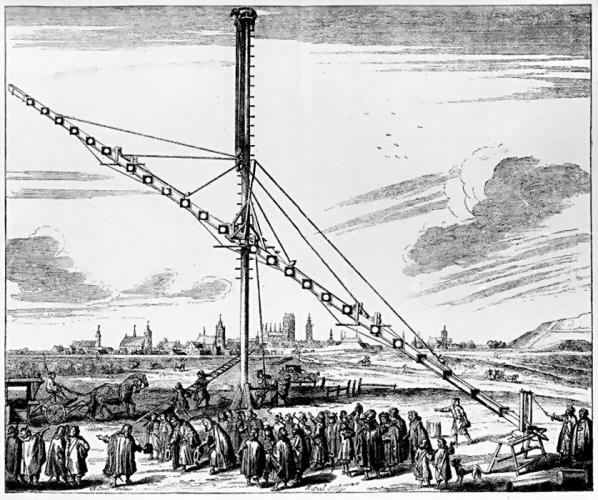
Today we are in a new situation because so much of our perception of the world comes not through extended senses but, in a real way, through new senses. This has been happening over a number of decades; the first wave of this was at the end of the 19th century when there was a cultural shock with the introduction of x-ray images, infra-red and later radio — which didn’t extend existing senses but augmented them.The most recent series of triggers maybe comes from the nano-sciences and synthetic biology — we now perceive phenomena of which we have no daily experience of (eg quantum phenomena). Field emission microsopy or MRI or some of the other new forms of imaging really don’t build on our existing experience — there are discontinuities and dislocations. Another element is of course the hand held device that leads to techniques for ‘augmented reality’ — I have a phone app that I can point at an aeroplane overhead and it tells me what the plane is, where it came from, and where it is going.
Coming to your question about the city — there is clearly a shift in map construction and reading — from the Cartesian map that we have been acculturated to. The ability to toggle between the bird’s eye view and the “street view”, and the ability to view maps that have multiple layers simultaneously are driving artists and others to develop new forms of representation.

Someone whose work is interesting in this regard is Bryan Connell in San Francisco, he just finished an art science residency at IMéRA in Marseille. He was working on a large urban trail project called GR13 — 300 miles through industrial, urban, sub urban, and wild landscapes (the city had a hell of a time getting right of way through these areas). Bryan is currently working on a web site for the Marseille European City of Culture events, where he’s working on some of these questions of representation. The project involves a collective of ‘artist-walkers’ that I think fits right into this question of performativity.

LB: There’s currently a great deal of interest in the connections between representation, digital technology, and politics, for example the current Hybrid City II conference in Athens. As you’ve pointed out, these often underline the connections between what digital media mean for artists and what they can contribute to citizens — what’s emancipatory about them. What can art offer civil life in this context? Are there any conflicts or contradictions in that relationship?
RM: One pertinent example is the work of Bruno Giorgini, a physicist, and Mariateresa Sartori (visual artist) who work on the “physics of the city.” They were recently in residence in the IMéRA Mediterranean Institute of Advanced Study which hosts artists and scientists in residence who want to work with each other. We now have access to incredible amounts of data on human mobility (pedestrian and various forms of transportation) so it is now possible to study human behaviour quantitatively. Sartori discovered that she could tell many things about a person just through the morphology or topology of their movements through the city. Girogini discovered that people’s movements could be predicted at the 80% level, but 20% of the time he had to introduce what he called ‘social temperature’; in discussions he also referred to this as a ‘free will’ parameter. Barabasi has found similar results analysing cell phone GPS data of individuals. So its interesting to think of the development of cities as 80% predictable and 20% serendipitous. This of course then highlights the role of the arts and culture in making cities part of the cultural imaginary that drives people to make choices. Recently Max Schich here at the University of Texas has analysed very large data bases looking at where prominent people are born and where they die over the last 500 years. Immediately you can see how suddenly certain cities become cultural ‘attractors,’ say the way Berlin or Hong Kong are now. And of course cities are now trying to ‘design’ this into the development of cities. Here in Dallas there has been a huge investment in the ‘arts district’ and in institutions of higher learning in the belief that healthy cities require such investments. See for instance the US National Endowment for the Arts Program; there are many similar programs in Europe.
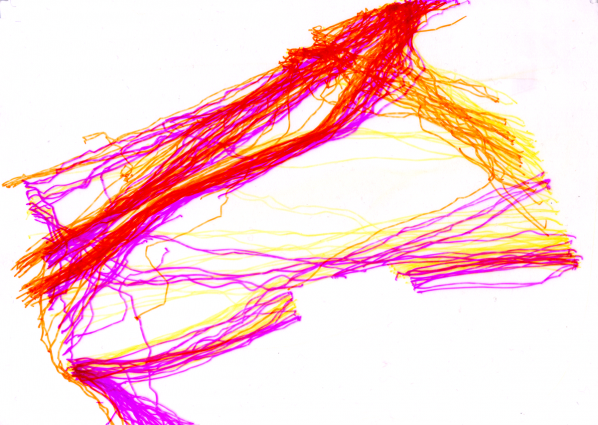
This doesn’t yet address your ’emancipation’ question. One of the things that is happening is that we are becoming a data taking culture (see the recent literature on ‘big data”). The cell phone has transformed every citizen (that has one) into a data taker. Of course much of this data is used by companies for marketing objectives. But many citizen groups are now able to take data for their social objectives. Some of this is captured by the ‘citizen science’ movement ( one example is here). There have been good examples of citizen’s taking data (on pollution, on illegal activities etc.) and then being in a position to challenge ‘authorities’ of various kinds whether scientific, political or economic (see for instance the way citizen groups have mobilised to collect data after man-made disasters such as oil spills, or illegal logging in forests).
A few years ago I wrote an open data manifesto which argued that I would like to advance a new human right and a human obligation:
1. Each of us has the right to the data that has been collected about ourselves and our own environment.
2. Each of must contribute to the knowledge construction by collecting and interpreting data about our own world.
Most scientific data collection is funded by public tax payer funding. The public has a fundamental right to all data collected and funded by public tax money.
LB: How do you imagine an artist’s training will change as these conditions evolve? And a scientist’s — could we foresee any kind of convergence?
RM: One interesting development is a cohort of hybrids, who have one degree in science or engineering and one in art and design ( for example J.F. Lapointe, a researcher at the National Research Council of Canada with degrees in molecular biology and dance) or degrees in Science or engineering and employment in art or design (like myself or Paul Fishwick, a key figure in the field of aesthetic computing). There’s been an emergence of art/science Ph. D. programs that take students from art or design or science or engineering. I suspect this cohort will grow over the coming years.
LB: Mariateresa Sartori, your IMéRA research project with Bruno Giorgini focused on mobility in the city. Can you tell us a little bit about how your work and Dr. Giorgini’s work complemented each other? What kind of evidence did you bring to the table as an artist?
MS: The project I worked on with Bruno Giorgini developed an exploration that began with earlier work in Venice. There I created a series of drawings using a rudimentary, even crude procedure: I traced out the movements of each pedestrian in the Piazza San Marco, drawing their paths with a felt-tipped pen on a transparent sheet placed over the computer monitor. I then faithfully transferred the results onto ordinary large sheets of white paper. The lines thus drawn in different directions created a space, drawing a St. Mark’s Square that is actually not there. As well as the actual physical space, it is also a drawing of our individual and collective manner of relating to space. Each single path determines the route of others, in a continuous and reciprocal game of influences that makes our collective progress.
At IMERA we developed this method for a new environment, a city more ethnically and culturally plural than Venice. Together we set up procedures and tools for collecting data about mobility networks there: nodes, links, chronotopi. These drew on the work of Bruno Giogini’s Laboratorio di Fisica della Città of the University of Bologna. We shot videos focusing on specific behavioural patterns where strategies of shifting, approaching and distancing play a decisive role; and we were also attracted by the places and situations of pedestrian congestion. Using the same technique as in Venice, I translated these into drawings of movement. These again created a space that marks out squares and places which are actually not there, each synthesizing space, time and humanity in a single image.

LB: Is there an emancipatory or governance-related dimension to this work? Degrees of mobility have human rights implications. How does your work as an artist connect with these rights, especially the notion of the right to the city?
MS: The first goal when I work as an artist observing reality is observation, i.e. a way of observing that implies a new attention. The result is always instructive because I do not have particular expectations. After lines have been traced following my process, something always emerges and what emerges can be a useful and indicative element for the emancipatory dimension of the urban condition. I would say that Bruno Giorgini is more involved in that dimension than me, especially in the notion of the right to the city.
LB: There’s a current preoccupation among researchers in a number of fields with the relationship between representation, often engaged with/through technology, and urban life. How has your latest work connected with this relationship?
MS: My way of working with technological instruments such as computers is very particular and limited. I use the computer as a technical tool strongly mediated by the senses, i.e. by human perception. I am very interested in modalities of perception: they are so imperfect, yet sufficiently perfect to make our existence possible.
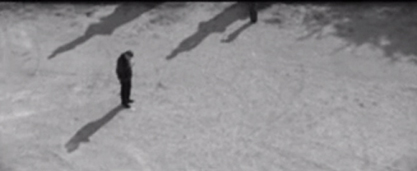
LB: You described the way you work with technological instruments as “particular and limited.” Another way to look at this is that you make the technological system slow down by inserting yourself into the process… and the result is your drawings, which still movement. Might this be one role for art — to insert the human into the machine? Much net art focuses on flows of information, virtual movement, and representing that. While not quite glitch art, do your representations of movement in some sense intentionally put a brake on the machinery?
MS: I find your words enlightening, you describe my way of working better than me….. Actually I insert myself into the technological process…..but this is not a statement of a position against technology.
I can say that what interests me the most (and art’s relation to science is just one instance of this) is the thread of connection between specific cases and general theory, between subjective and objective. Between, on the one hand, the singularity of events and, on the other, general theory. The individual’s experience is singular, unique; but there is always a thread, even if fine, that leads each individual case to a wider generalisation. What interests me is this incessant – indispensable as much as concealed – mental activity that every day leads us to search for generalisations and regulating principles. What interests me is the human tendency to comprehend phenomena, even the most complex, via schematic representation, via a generalisation that leads to the identification of organising principles. I mean “Comprehension” in very wide sense, where emotions and feelings participate too in embracing reality, including reality. Maybe in this sense I put the human in the machine…
There is a discrepancy between how we perceive reality, mediated by our senses, and the truth decreed by science. On a rational level we recognize the truth, but we cannot internalize in a deep way this knowledge; this is beyond our human capabilities. I think that in my artistic research I find myself in this deep discrepancy.
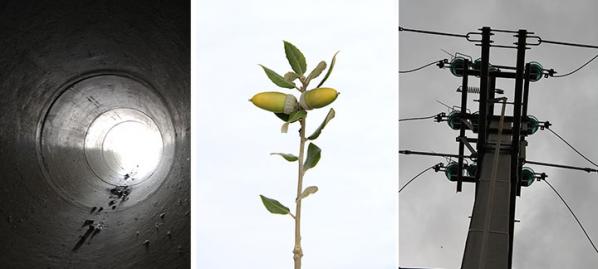
LB: Bryan Connell, your work in Marseille addresses, among other concerns, technology and its relationship to nature. Do you see the urban environment as playing any particular role in that relationship — of having a particular status in our negotiation of it?
Bryan Connell: One of the things that intrigued me about the metropolitan hiking trail in Marseille is the way it plays with our sense of meaning and value in the exploration of contemporary landscapes. Most long distance hiking trails are designed to lead out of urban environments, not into them. We don’t usually think of carrying a field guide that illustrates the taxonomy of fire hydrants, electrical pylons, or urban weeds on an extended city or suburban walk. That kind of engaged, systematic attention is usually reserved for wild natural terrains. From a traditional environmental perspective, the less altered a place is by human technology, the more scientifically interesting, ecologically exemplary, and aesthetically rich it’s going to be. Without undermining the validity of ever-present environmental concerns, the trail functions as an invitation into a more challenging and complex relationship to the emerging para-wilds and novel ecosystems that are arising at the intersection of the natural world and the technological infrastructure of the built environment.
Similarly, the Marseille trail doesn’t really focus on the kinds of urban sites that are traditionally thought of as having significant historic, architectural, or cultural interest. Instead, the trail route incites visitors into an exploration of the everyday environments and working landscapes of the contemporary urban transect – a world of parking lots, freeway overpasses, suburban developments, abandoned railways, and semi-rural wildlands.

Landscape ecologist Earl Ellis argues that to better navigate our way through the current geohistorical epoch, the Anthropocence, we must expand the traditional ecological concept of regional biomes into the parallel notion of “anthromes” – biomes that are complex interconnected melds of human technology and natural systems. In a sense, the GR 2013 Marseille trail is a sketch or system of exploratory paths into what a publically accessible, anthrome based urban ecology observatory might look like.
LB: A similar question is in relation to the image, especially sequential images. What does it mean for our negotiation of the relationship between nature and technology? Between science and art?
BC: We increasingly live in a networked digital metropolis with an image and information density that both mirrors and exceeds the high population densities of the physical metropolis. One topic of particular interest to me is the role these images play in transfiguring the quality of our desire. To what extent do scientific or aesthetic images that increase our ability to find meaning and satisfaction in observing and understanding urban landscape phenomena mitigate our need to physically alter the landscape to conform to an idealized image of what it should or shouldn’t be?
For example, the Marseille metropolitan trail didn’t require much physical alteration of the terrain – it’s a conceptually designated network of pre-existing roads, paths, streets and highways. The trail’s function is not to alter place, but alter the cognitive landscape of trail users so they have a richer sense of place. If you are fascinated by the diversity of ways a para-wild plant population has adapted to a technologically modified environment, do you need to engage in an energy and material intensive re-landscaping of that environment with a palette of conventional horticultural plantings to make it more “beautiful”? In this sense, constructing interpretive images of landscape is more than a way of augmenting a recreational hiking experience, it’s a way of shifting and re-configuring what we think we have to consume and alter to find meaning and vitality in contemporary landscapes.
http://uranus.media.uoa.gr/hc2/
Hybrid City is an international biennial event dedicated to exploring the emergent character of the city and the potential transformative shift of the urban condition, as a result of ongoing developments in information and communication technologies (ICTs) and of their integration in the urban physical context. After the successful homonymous symposium in 2011, the second edition of Hybrid City has grown into a peer reviewed conference, aiming to promote dialogue and knowledge exchange among experts drawn from academia, as well as artists, designers, researchers, advocates, stakeholders and decision makers, actively involved in addressing questions on the nature of the technologically mediated urban activity and experience.
The Hybrid City 2013 events also include an online exhibition and workshops, relevant to the theme
Hybrid City Conference 2013: Subtle rEvolutions will take place on 23-25 of May 2013.
The Hybrid City II events will take place at the central building of the National and Kapodistrian University of Athens.
This document was edited with the instant web content composer. Use the online HTML editor tools to convert the documents for your website.
Erica Scourti’s work addresses the mediation of personal and collective experience through language and technology in the net-worked regime of contemporary culture. Using autobiographical source material, as well as found text collected from the internet displaced into social space, her work explores communication, and particularly the mediated intimacy engendered by a digital paradigm.
The variable status and job of the artist is humorously fore-grounded in her work, assuming alternating between the role activist, ‘always-on’ freelancer, healer of social bonds and a self-obsessed documenter of quotidian experience.
Millions are blissfully unaware of the technological forces at work behind the scenes when we use social network platforms, mobile phones and search engines. The Web is bulging with information. What lies behind the content of the systems we use everyday are algorithms, designed to mine and sort through all the influx of diverse data. The byproduct of this mass online activity is described by marketing companies as data exhaust and seen as a deluge of passively produced data. All kinds of groups have vested interests in the collection and analysis of the this data quietly collected while users pursue their online activities and interests; with companies wanting to gain more insight into our web behaviours so that they can sell more products, government agencies observing attitudes around austerity cuts, and carrying out anti-terrorism surveillance.
Felix Stalder and Konrad Becker, editors of Deep Search: The Politics of Search Beyond Google,[1] ask whether our autonomies are at risk as we constantly adapt and tailor our interactions to the demands of surveillance and manipulation through social sorting. We consciously and unconsciously collide with the algorithm as it affects every field of human endeavour. Deep Search illuminates the politics and power play that surround the development and use of search engines.
But, what can we learn from other explorers and their own real-life adventures in a world where a battle of consciousness between human and machine is fought out daily?
Artist Erica Scourti spent months of her life in this hazy twilight zone. I was intrigued to know more about her strange adventure and the chronicling of a life within the ad-triggering keywords of the “free” Internet marketing economy.
Marc Garrett: In March 2012, you began the long Internet based, networked art project called Life in AdWords, in which you wrote and emailed a daily diary to your Gmail account and performed regular webcams where you read out to the video lists suggested keywords. These links as you say are “clusters of relevant ads, making visible the way we and our personal information are the product in the ‘free’ Internet economy.”
Firstly, what were the reasons behind what seems to be a very demanding project?
Erica Scourti: Simply put, I wanted to make visible in a literal and banal way how algorithms are being deployed by Google to translate our personal information – in this case, the private correspondence of email content – into consumer profiles, which advertisers pay to access. It’s pretty widespread knowledge by now that this data ends up refining the profile marketers have of us, hence being able to target us more effectively and efficiently; just as in Carlotta Schoolman and Richard Serra’s 1973 video TV Delivers People,[2] which argues that the function of TV is to deliver viewers to advertisers, we could say the same about at least parts of the internet; we are the commodities delivered to the advertisers, which keep the Web 2.0 economy ‘free’. The self as commodity is foregrounded in this project, a notion eerily echoed by the authors who coined the term ‘experience economy’, who are now promoting the idea of the transformation economy in which, as they gleefully state, “the customer is the product!”, whose essential desire is to be changed. The notion of transformation and self-betterment, and how it relates to female experience especially within our networked paradigm is something I’m really interested in.
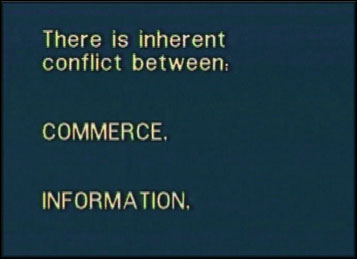
As Eli Pariser has pointed out with his notion of filter bubbles, the increasingly personalised web employs algorithms to invisibly edit what we see, so that our Google searches and Facebook news feeds reflect back what we are already interested in, creating a kind of solipsistic feedback loop. Life in AdWords plays on this solipsism, since it’s based on me talking to myself (writing a diary), then emailing it to myself and then repeating to the mirror-like webcam a Gmail version of me. This mirror-fascination also implies a highly narcissistic aspect, which echoes the preoccupation with self-performance that the social media stage seems to engender; but narcissism is also one of the accusations often leveled at women’s mediated self-presentation in particular, despite, as Sarah Gram notes in a great piece on the selfie, [3] it being nothing less than what capital requires of them.
![Girl with a Pearl Earring and a Silver Camera. Digital mashup after Johannes Vermeer, attributed to Mitchell Grafton. c.2012. [4]](http://www.furtherfield.org/wp-content/uploads/2013/05/vermeer_selfie.jpg)
And as this project is a form of autobiography and diary-writing, it could also be seen as both narcissistic and as asserting the importance of personal experience and emotions in the construction of a humanist, unified subject. Instead, I wanted to experiment with a way of writing a life story that operated somewhere between software and self, so that, as Donna Harraway says “it is not clear who makes and who is made in the relation between human and machine”. Part of the humour of the project arises from the dissonance between the staged realism of the webcam (and my real cat/ hangover/ bad hair) with the syntactically awkward, machinic language, which undermines any notion that this diary is the expression of any authentic subject.
The demanding aspect of it is something I was interested in too, since it calls up the notion of endurance as a virtue, and therefore as a value-enhancer, which many artworks – from mind-boggingly labour intensive supercut-style videos to sculptures made from millions of pins (or whatever) – trade on. You just can’t help but ask ‘wow…how long did that take?!’ – as if the time, labour and effort, i.e. the endurance, necessarily confer value. So there is a parallel between a certain kind of ‘age of austerity’ rhetoric that valorises resilience and endurance and artworks that trade on a similar kind of doggedness – like Life in AdWords does.
And finally – it made me laugh. Some of the text was so dumb, and funny, it amused me to think of these algorithms dutifully labouring away to come up with key-phrases like ‘Yo Mamma jokes’ and ‘weird pants’.
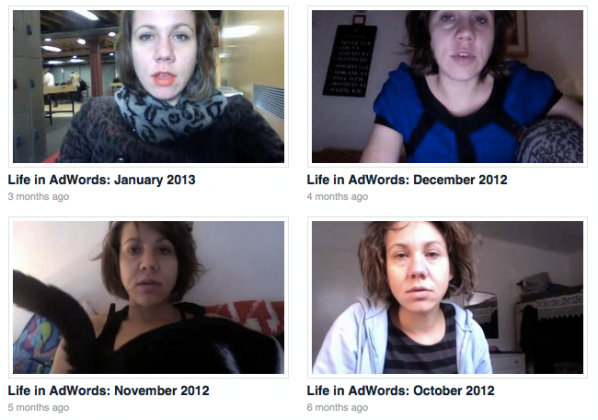
MG: It ran until 20th January 2013, and ended due to system changes in the Gmail ad settings. How many videos did you produce and were you glad when it all had finally ended?
ES: Not sure how many I made – but I was 6 weeks short of the intended year, so definitely over 300. Actually I was infuriated and somewhat depressed when it ended without warning and in a moment of panic I even thought about somehow cheating it out to the end; but working with a system that is beyond your control (i.e. Google) necessarily involves handing over some of your authorial agency. So instead I embraced the unexpected ending and threw a kind of send-off party plus performance in my bedroom/ studio to mark it.
But this question of agency is obviously crucial in the discussion of technology and runs through the project in various ways, beyond its unintended termination. At the level of the overall structure, it involves following a simple instruction (to write and process the diaries every day and do the webcam recording) which could be seen as the enactment of a procedure that echoes the operation of a software program carrying out automated scripts. And on the level of the texts, while all the language used in the project was generated and created by the software, I also was exercising a certain amount of control over which sections of the diary I favoured and editing the resulting lists, a move which seemingly reasserts my own authorial agency.
Thus the texts are more composed and manipulated than they first appear, but of course the viewer has no way of knowing what was edited out and why; they have to take it on faith that the texts they hear are the ‘real’ ones for that diary.
MG: During this period you recorded daily interactions of the ongoing experience onto webcam. As you went through the process of viewing the constant Google algorithms, I am wondering what kind of effect it had on your state of mind as you directly experienced thousands of different brands being promoted whilst handing over the content once again, verbally to the live camera?
ES: I’m not sure what effect it had on my state of mind, though considering the amount of concerned friends that got in touch after viewing the videos, Google certainly thought I was mostly stressed, anxious and depressed. Maybe it’s just easier to market things to a negative mind state.
But also, the recurrence of these terms was no coincidence; early film theorist Tom Gunning has argued that Charlie Chaplin’s bodily movement in Modern Times [5] ‘makes it clear that the modern body is one subject to nervous breakdown when the efficiency demanded of it fails,’ and compares his jerky, mechanical gestures with the machines of his era.
So I was interested in if and how you could do something similar for the contemporary body; how can we envisage it and its efficiency failures in relation to the technology of today when our machines are opaque and unreadable, if we can see them at all. Maybe what they ‘look like’ is code (a type of language), so it would entail some kind of breakdown communicated through language rather than bodily gestures – though the deadpan delivery certainly evokes a machinic ‘computer says no’ type of affectlessness.
Also, Franco Berardi has spoken of the super-speedy fatigued denizen of today’s infoworld, for whom “acceleration is the beginning of panic and panic is the beginning of depression”. In a sense this recurrent theme of stress and anxiety disavows the idea of the efficient, ever-ready, always-on subject of neo-liberalism – and yet the project as a whole kind of sneakily joins the club too, since it obeys the imperative of productivity by turning a diary (personal life, non-work) into a ‘project’ (i.e. work).
As mentioned earlier in terms of the ‘transformation economy’, I’m really interested in this idea of efficiency also as it manifests in rhetorics of self-betterment, and its relation to the neo-liberal promotion of self-responsibility (if you’re poor, it’s your fault….). Diaries and journal writing – as well as meditation, yoga, therapy, self-help etc – are often championed in everything from cognitive fitness to management literature as excellent ways of becoming more ‘efficient’. The underlying belief seems to be that by unloading all the crap that weighs you down, from emotional blockages to unhelpful romantic attachments to an overly-busy mind, you’d get an ‘optimised you’. Why this is necessarily a good thing – apart from the elusive promise of ‘happiness’ of course – is never really discussed.
Tiqquun’s notion of the Young Girl, the model consumer-citizen, is interesting in this regard – taking good care of oneself reframed as a form of subservience which maintains the value and usefulness of our bodies and minds to capital. Their idea that the Young Girl (not actually a gendered concept in their estimation) “advances like a living engine, directed by, and directing herself toward the Spectacle” also points to the irony beneath what appears to be a very humanist/ individualist inflection to these discourses of self-realisation: they could also be read as a latent desire to become somehow more ‘machine-like’, as if we could therapise/ meditate/ journal/ jog away our mind-junk with the swiftness and ease of emptying the computer’s trash, thereby becoming more productive.
And yet I’m clearly complicit in this, as I write diaries, meditate, do yoga and obsess over my bad time management, as Life in AdWords makes clear both in the recurrence of all these activities in the texts and obviously in its structure as a daily journal project.
MG: Robert Jackson in his article Algorithms and Control discusses in his conclusion that even though “use of dominant representations to control and exploit the energies of a population is, of course, nothing new”, when masses of people respond and say yes to this “particular reduced/reductive version of reality”, as an act of investment it “is the first step in a loss of autonomy and an abdication of what I would posit is a human obligation to retain a higher degree of idiosyncratic self-developed world-view.” Alex Galloway also explores this issue in his book Protocol: How Control Exists after Decentralization, where he argues that the Internet is riddled with controls and that what Foucault termed as “political technologies” as well as his concepts around biopower and biopolitics are significant.
Life in AdWords, seems to express the above contexts with a personal approach on the matter. Drawing upon an artistic narrative as the audience views your gradual decline into boredom and feelings of banality. The viewer can relate to these conditions and perhaps ask themselves similar questions as they go through the similar experiences. Thus, through performance and a play on personal sacrifice on a human level, it elucidates the frustrations on the constant, noise and domination of these protocols and algorithms and how they may effect our behaviours.
With this in mind, what have you learnt from your own experience, and how do you see others regaining some form of conscious independence from this state of sublimation?
ES: I found Galloways’ explanation of Foucault’s notions of biopower to be some of the most interesting parts of that book – as he puts it “demographics and user statistics are more important than real names and real identities”, so it’s not ‘you’ according to your Amazon purchase history, but more ‘you’ according to Amazon’s ‘suggestions’ (often scarily accurate in my experience). Which is where the algorithms come in; they do the number-crunching to be able to predict what you might buy, and hence who you are, not because anyone cares about you particularly, but because where you fit in a demographic (a person who is interested in art, technology, etc..) is useful information and creates new possibilities for control.
Regaining conscious independence… hmm. I found it interesting that during the project, the people I explained it to would often report back to me on what keywords their emails had produced, and what adverts came up on Facebook, as they hadn’t really noticed before – so perhaps in these cases it made people more conscious of the exchange taking place in the ‘free’ web economy. Others took up AdBlocker in response, which is one way of gaining distance – by opting out. However, the info each of us generates is still useful, since even if you aren’t seeing the ads, your choices and interactions are still being parsed and thus help delineate a particular user group of citizen-consumers.
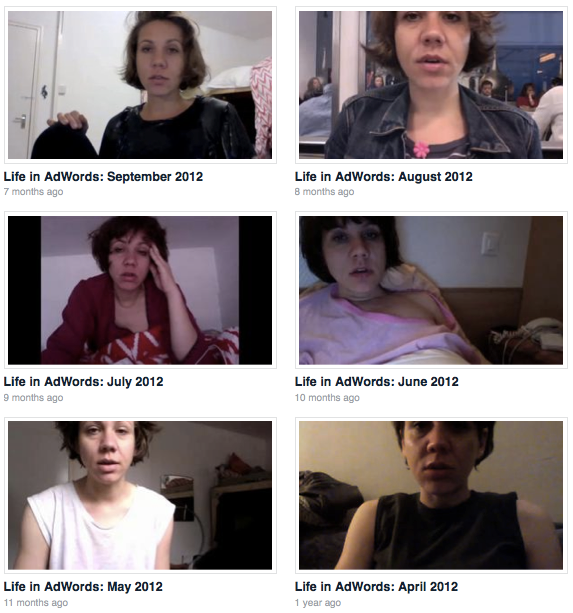
Despite this, my feeling is that opting out – if it’s even possible – can be a way of pretending none of this stuff is happening. I’m generally more interested in finding ways of working with the logic of the system, in this case the use of algorithms to sell things back to us, and making it overly obvious or visible. Geert Lovink asked whether its possible for artists to adopt an “amoral position and see control as an environment one can navigate through instead of merely condemn it as a tool in the hands of authorities” and his suggestion of using Google to do the ‘work’ of dissemination for you, in spreading your meme/ word/ image, is one I’ve thought about, particularly in other works (especially Woman Nature Alone). This approach entails hijacking the process by which Google’s algorithms organise the hierarchy of visibility to one’s own ends – a ‘natural language’ hack, as Lovink puts it.
In contrast, Life in AdWords makes visible the working of the algorithmic system more on the level of the language it produces. It also employs humour, and laughter has been one of the main responses people have had when watching the videos, for a number of reasons. The frequent dumbness of the language and/ or the juxtapositions (‘Where is God?’, ‘Eating Disorder Program’); the flattening out of all difference between objects/ feelings/ places (e.g. work-related stress, cat food, God, Krakow); and the lack of shame the software exhibits in enumerating bodily and mental malfunctions (blood in poop, wet bed, fear of vomiting) are all quite amusing in and of themselves.
That shameless aspect also echoes the over-sharing and ‘too much information’ tendencies the web (especially social media) seems to encourage, which Rob Horning has written about in his excellent blog, Marginal Utility. It also foregrounds that whatever the algorithms can do, what they still can’t do is emulate the codes of behaviour governing human interaction – including knowing when to shut up about your ‘issues’.
The frequent allusions to these bodily and mental blockages also point to the limits of the productivity imperative – a refusal to perform enacted through minor breakdowns – while bringing it back to an embodied subject, who despite her immersion in networked space is still a body with messy, inefficient feelings, needs and urges. And the comically limited portrait the keywords paint maybe suggests that despite the best efforts of Web 2.0 companies, we still are not quite reducible to a list of consumer preferences and lifestyles.
MG: What are you up to at the monment?
ES: Amongst other things I’m doing a residency with Field Broadcast (artists Rebecca Birch and Rob Smith) called Domestic Pursuits, a project which ‘considers the domestic contexts of broadcast reception and the infrastructure that enables its transmission.’
And I’m working on some drawings plus a video involving Skype meditation with members of the Insight Timer meditation app community, for A Small Hiccup, curated by George Vasey and opening 24th May at Grand Union, Birmingham- the video is being shown online tommorrow.
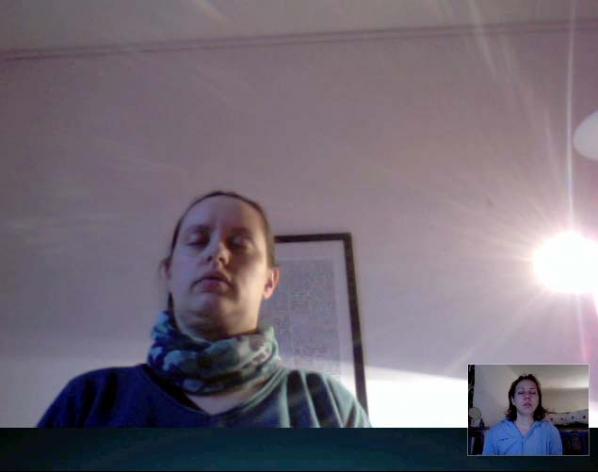
Also I’m attempting and mostly failing at the moment to write my dissertation for the MRes in Moving Image Art I’m doing at Central St Martins and LUX.
Personal Web searching in the age of semantic capitalism: Diagnosing the mechanisms of personalisation. Martin Feuz, Matthew Fuller, and Felix Stalder.
http://firstmonday.org/article/view/3344/2766
Live Performance. KONRAD BECKER (aka Monoton) featuring SELA 3 themes from “OPERATIONS” (15 min.). Published on Jul 9, 2012. YouTube.
http://www.youtube.com/watch?v=HMscYTAF4wY
Erica Scourti was born in Athens, Greece in 1980 and now lives in London. After a year studying Chemistry at UCL, an art and fashion foundation and a year of Fine Art Textiles at Goldsmiths, she completed her BA in Fine Art at Middlesex University in 2003 and is currently enrolled on a Research degree (Masters) in Moving Image Art at Central Saint Martin’s College of Art & Design, run in conjunction with LUX. Her area of research is the figure of the female fool in performative video works.
She works with video, drawing and text, and her work has been screened internationally at museums like the Museo Reine Sofia, Kunstmuseum Bonn and Jeu de Paume Museum, as well as festivals such as the Recontres Internationales, interfilm Berlin, ZEBRA Film Festival, Antimatter, Impakt, MediaArt Friesland, 700IS as well as extensively in the UK, where she won Best Video at Radical Reels Film Competition; recent screenings include Video Salon Art Prize, Exeter Phoenix, Bureau Gallery, Tyneside Cinema and Sheffield Fringe Festival.
Her work has also been published in anthologies of moving image work like Best of Purescreen (vols 1, 2 and 3) and The Centre of Attention Biannual magazine.
more info – http://www.ericascourti.com/art_pages/biography.html
Some have proposed Jennifer Chan to be part of what has been termed as the post-internet era. But, this is an inadequate representation of the spirit, criticality and adventure at play in her work. Chan’s awareness and use of the Internet reflects a way of life, that situates its networks as a primary resource. Chan lives amongst various worlds and engages in different shades of being; a self-described ‘amateur cultural critic’, a net artist, a media artist, and academic. Her work exists both online and in physical realms, it is always present and contemporary. This is because her work lives in a world where the scripting of official art definitions loses its power. People have exploited technology to facilitate new behaviours where the artist or art amateur redefine what art is on their own terms. We are now in a post-art context. It reflects a very real, societal shift. Mainstream art culture no longer owns the consciousness of art, Chan and others like her are pulling it apart.
Marc Garrett: In your video Interpassivity a kind of docu-performance made for the exhibition REALCORE, you’re in a park spraying a brown cardboard box, silver. As you go through the process of walking around the box whilst spraying it, you comment on the object’s formal aspects. But, what you mainly discuss are your own personal views about contemporary art. It then becomes apparent that the box is a prop for the performance, enabling the subject to be explored.
Alongside your interpretations of the work my own thoughts on the subject feel as though they are included in the conversation. I know as a viewer, that the artist is not aware of my thoughts on the matter. However, it feels like there is space for me to be a part of the conversation. Not literally through a feedback system or interaction, but as an individual considering your personal questions. The artwork knows I am experiencing it, it knows that a consciousness out there is somehow engaging with its dialogue.
It is clear you are in tune with the feeling of dysfunction. You say, “I need to spit out some creative truth”. On hearing this, I was not sure whether this was a parady, irony or an expression of despair, or all these. You also say “contemporary art is removed from our everyday feelings”. As you express these words I begin the view the box as a symbol of contemporary art as a centralized, institutional monolith? So, before I unwittingly place my own meanings onto the work could you tell us what it means to you?
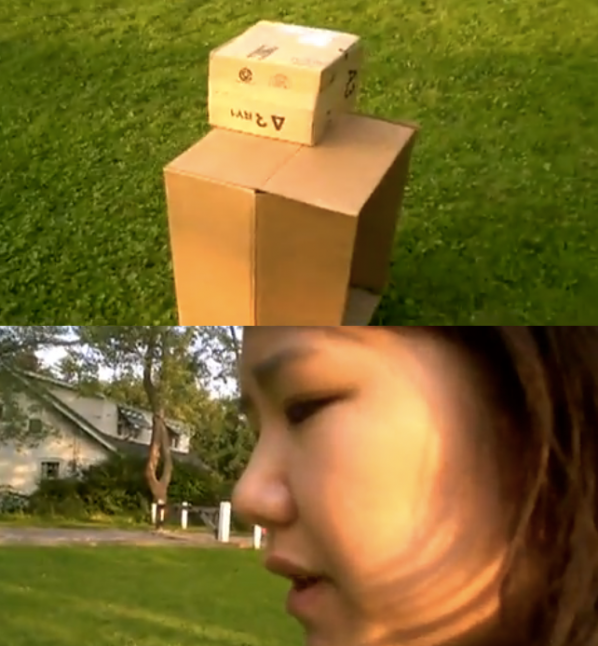
Jennifer Chan: Interpassivity is the instance of something cueing an audience to feel a certain way, such as canned laughter to stand in for humoured social reaction to jokes in a sitcom– even when it’s not funny. I titled it that because I felt like another art student trying to convince herself or the viewer what she made is art. I feel embarrassed about this self-aware but privileged complaining. A few people have found this work online and screened it, but I’m still mortified to watch it with them.
I made that video because I think a lot of contemporary art is sterile, mannered and removed from emotion. I wasn’t thinking of Donald Judd at that point but I could see the box standing in as a poor attempt at work, like his work. What I was working on (or seven years of art education) had little to do with what was happening in my life. (So to answer your question, yes, it is despair) Using my flipcam and talking over it was immediate for recording those ideas. It’s also a big trope of Canadian video art… a breathy voiceover conveys something serious and personal.
re: REALCORE. The title came about as a play on the idea of “real life”, or face-to-face life away from keyboard. Likewise, users would say “irl”(in real life), or “so real~” in Facebook comment threads to joke about the divide between online/offline contexts. The curator David Hanes felt the video was important to contextualize my use of sincerity and clichés, I was not being ironic in my intention. Arielle Gavin and Jaakko Pallasvuo thought it was questionably ironic and an emotive perspective on the Internet as a form of new sincerity.
I later found that someone wrote a paper by someone who coined “realcore” as a kind of amateur user-generated porn, which is a cool double-meaning. The “interpassivity” video was used to promote the show online but I showed my kitschy found footage videos on twisted pizza box plinths for the show. This was my fuck-you to geometric minimalism and boring white plinths, but I suppose it resulted in a different take of it…
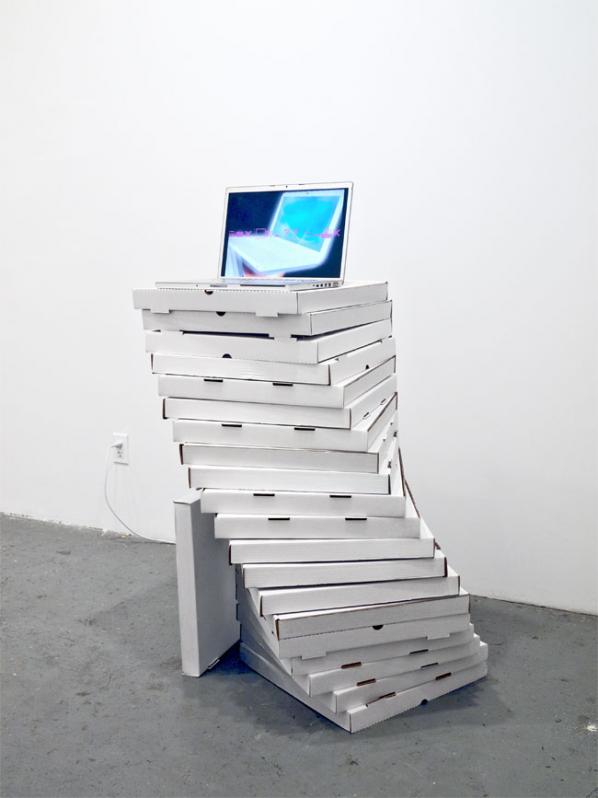
MG: In one of your recent videos “Grey Matter” when watching it felt like I was immediately pulled into a remixed world of teenage celebrity, products and brands, dripping in an orgasmic noise of techno-capitalism. Most of it is found footage, images, video and sound remixed into an edited compilation. Running through the video in between the high octane fuelled cuts and glitches, are messages to the Internet user who chances upon the video. These messages feel like they are from an individual voice but also of a multitude – caught up in a constant state of mediated folk hedonism.
What intentions lie behind this work as an artistic explorer of the entertainment culture you have remixed?
JC: Grey Matter is a first person account on feeling politically inactive online while having access to a wealth of information. I wanted to use remix in a confessional manner, so I combined obscure nostalgic media with embarrassing statements. The video begins with sped up footage of early 3D simulator ride called “Millennium Bug”. Y2K was the first technological “crisis” I recalled with clarity when I was growing up. The rest of the video includes cynical commentary on online spaces I’ve engaged with in the past year. (shopping on aliexpress.com and lurking people on OkCupid) “Little Prince” is compressed 25 times and sped up by 400%. I included old profile pics and some summary text from my OkCupid profile–I thought it was quite telling about how I wanted to be seen online and irl. I think it’s possible to feel mutually exclusive feelings at the same time, or maybe the experience of being active on different social networks produces a kind of schizophrenia. Collaging Internet pop culture is a way to appreciate it-as artifacts-in a complex light, and to be critical of it by acting out within its language.
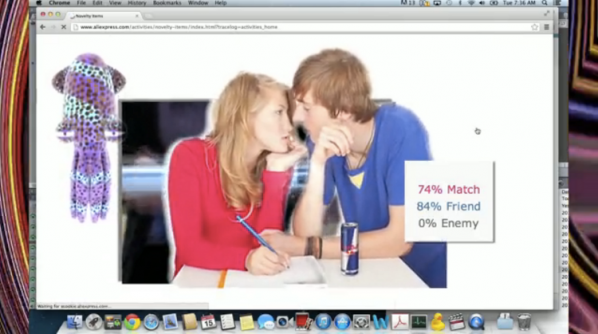
MG: What do you find fascinating about popular culture on the Internet?
JC: Anything minuscule has the potential to be popular amongst disparate users and they form vernaculars to talk about their interest in that. I find that desire relatable. That is what I think of as “community” online. It’s based on human interest and media fandom. Justin Bieber is made into something of a scapegoat for the first world’s shortcomings; people who like his image/music idolize him, and people who hate him are waiting for him to crack. Both are forms of fanaticism (one based on affinity; the other on hate-watching something.) Supercuts of Justin Bieber hairflips, object crushing fetishists, disease forums, long threads debating a detail…etc. I like the solipsism and intensity of all that.
MG: Can you share with us some of your critical insights and personal pleasures on this subject?
JC: Pop culture is paradoxical and audiences selectively enjoy it. (like teens dancing to hip hop with irreverence to its violent or sexist content.) Consuming and sampling pop allows people to indulge into its meanings, and through this there is a reconsideration of what “the masses” find important. Like the use of “users”, “masses” is what cultural studies calls everyone or everyone except-you. But every “user” has a specific relationship with interfaces and platforms, so they aren’t so homogenous.
Pop culture is also political. There was a time when more people voted for American Idol than the US elections, and if 10,000 people showed up to the 2012 cat video festival, entertainment is generally more seductive than current affairs–until there is a gatekeeping emergency (like mainstream media not covering the early days of Occupy). In terms of “internet pop culture”, perhaps traffic with social networking has overtaken porn and gambling online, but social news is also a kind of entertainment.

MG: Olia Lialina and Dragan Espenschied in their book Digital Folklore they celebrate everyday people’s use of personal computers with “glittering star backgrounds, photos of cute kittens and rainbow gradients”. They value the non-professionalism and amateur spirit that has come about from millions of people enjoying the Internet since it started. There is a difference now, the Internet masses have been shifted and prodded into large web 2.0 frameworks such as Facebook, and an abundance of personal web projects have been lost since.
And, like them do you find reassurance or a personal connection with the Internet Amateurs of the world?
JC: In context of new media art, it’s probably more accurate to think of amateurs as people who don’t self-identify as artists or technicians. What non-artists do with software and video appears facile, sincere, and intuitive. I make amateur-looking work to dialogue with that.. I like to say something dumb to say something serious. Something that’s made simplistically and filled with kitschy references can be packaged as critique that also appeals to non-art audiences.
I caught the tail end of the homepage-o-sphere/webring 1.0 period. Non-artists made personal websites out of a genuine interest in something. tumblr and pinterest is used in a same way today–to collect indiscriminately. Like 2.0 frameworks, the early internet also had free webpage hosting that users relied on (Geocities and Lycos). Personal website design isn’t over either; net artists still make them or bind together to create their own sites (like tightartists.com). I think I have an idea of what you mean though; it was less commercial and there weren’t as many distinct “most-visited” places online.
I made a lot of gothy dark art on DeviantArt before I knew about contemporary art, and my sensibility towards Photoshop was more romantic and impulsive without the baggage of art education. Maybe this “revival” cult of amateur-looking digital folklore happened because I/we exoticize that kind of amateur production. Web vernaculars have also become stylized and this aesthetic is shared with seapunks and filmmakers. Artists need to adapt to that.
MG: What do you feel is still alive and open for everyday online expression and play, in respect of what Lialina and Espenschied perceive as Digital Folklore?
JC: I think a lot of emerging artists have a greater awareness of obsolescence and upgrade culture than we give them credit for–while still complacent to the socialization structures on Facebook. Many seem more interested in navigating these networks to question their inner control mechanisms than overthrowing them or innovating new ones. It can be simple things like friending as many users as possible, looping webcam feeds, archiving and re-uploading banned content on different platforms, having an anonymous/alternate personas/using multiple accounts…etc. People like glitchr and Ian Aleksander Adams are always looking for ways to use a system against its intended functions in the same way jodi did all the cheat moves in max payne CHEATS ONLY. I admire glitch practices for that.
There’s also the possibility for re-appropriating anything to rebrand or critique particular communities. I think Angela Washko and Jaakko Pallasvuo are doing this in a compelling way that covers a large territory between art and Internet culture.
MG: So, what are you working on at the moment?
JC: <–for some reason this sounds less perverted than if I were an old guy doing this to teen girls but its really just as perverse–>
I’m observing what young adult/teen boys do on YouTube: bulking up, performing dares, talking about how to pick up a White/Asian girls etc. I’m also making a video about Asian guys (both diasporic, Asian American, and more specifically, Korean and Taiwanese men) and their interpretations of mediated masculinity. There is something disturbingly tantalizing in terms of how they have learned to look at the webcam as if they are boy band stars yet they are not fully grown men. A lot of this is informed by growing up in Hong Kong, and knowing that fashion and romance, is inspired by many “neighbouring” cultural media from Japan, Korea and Taiwan even though American/British influence is also prominent in the club scene.
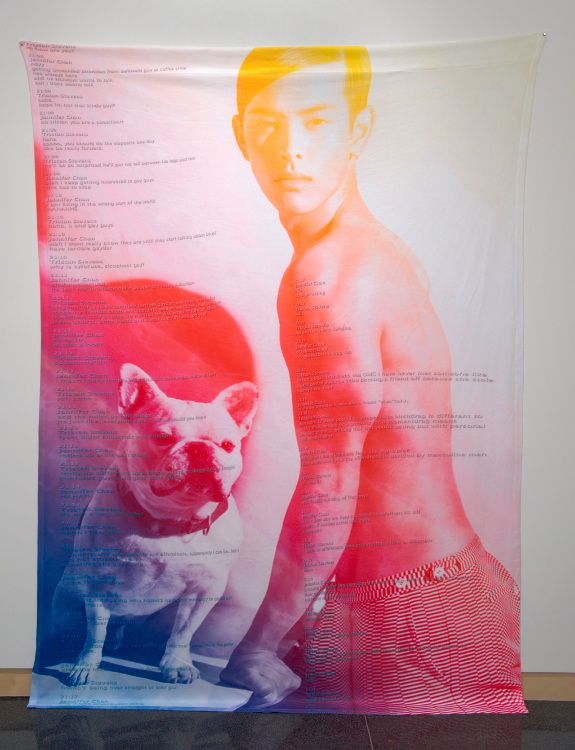
Here are two images from my late installation that will foreshadow this interest. It’s chat text over layered on modified fashion and makeup adverts targeted at Korean and Chinese men, and printed onto micro-fibred bedding. I feel like they’re treated as pleasant freak shows on tumblr but this imagery is a banal, idealized kind of masculinity in Asia. I think western facial features are really common amongst these popular images of Asian-ness, and most would tend to read it as aspiring to western culture, though the hyperfemme “doll” look or metro-masculinity has been a regional style since the 90s.
Chan’s work reflects an emerging condition described by Zizek as “interpassivity” in which our engagement with interactive experience has lost traction and is replaced with “its shadowy and much more uncanny supplement/double “interpassivity””[1], a “Fetish between structure and humanism”[ibid]. We are pulled into a paradox, where ‘interaction and passivity’ are joined together as spectacle of constant mediation. Millions have joined online centralized, megastructures such as Facebook, and this is not a black and white situation. Many are coerced from social and consumer pressures into the state of being seen as interacting. As the futuristic time machine streams onwards at high-speed, agency slouches into a spurious and distant dream. Others and the same are enjoying the flow for the sake of self expression within these scripted frameworks.
Chan’s work critiques, plays with, and exploits this networked, social intervention, as well as her viewers’ desires. Her imaginative palette revivifies questions about agency, passivity, sexuality, privacy, individuality, behaviour, networked consumption and its production. These remixed artworks have much material to work with, as the endless ether of everyday noise is uploaded and distributed through blogs and social networking sites; then returned into the ether as cut-ups where a transforming culture is engaged in its own mutation.
Its noise engages us whether we enjoy it or not, in the medium of “interpassivity”, and we all find ourselves caught within this spectacular enticement driven by the Netopticon. “On a holiday trip, it is quite common to feel a superego compulsion to enjoy, one “must have fun” — one feels guilty if one doesn’t enjoy it.”[ibid]
Jennifer Chan – http://www.jennifer-chan.com/
Heavy MetaVernacular video after the popularization of the internet
http://jennifer-chan.com/index.php?/curatorial/heavy-meta/
SELF-LOVE A non-consensual exhibition of emerging net art
http://jennifer-chan.com/index.php?/curatorial/self-love/
New Insularity Peer backpatting. A screening of works by friends and users whose works I admire.
http://jennifer-chan.com/newinsularity.html
Feeling VideoThe affective appeal of antisocial video
http://jennifer-chan.com/index.php?/curatorial/feeling-video/
Trivial Pursuits Distracting “new media art”
http://jennifer-chan.com/index.php?/curatorial/trivial-pursuits/
About a year ago Eleanor Greenhalgh started her project The Dissolute Image (TDI), a speculative, poetic image hosting technique. By splitting images into individual pixels and distributing them, it enables banned content to be secretly posted on corporate social platforms. TDI enables users to post a single pixel on their own social media page. All the entries are tracked by TDI and each pixel will re-appear on a dedicated website, eventually re-forming the image. I asked Eleanor about her motivation and interest in censorship and hosting issues.
Annet Dekker (AD): Could you tell me a little bit about your background?
Eleanor Greenhalgh (EG): I did a fine art BA at Oxford Brookes in the UK where I started working on participatory projects. I consider myself somewhere between a curator and a facilitator, but it is a role that I haven’t quite worked out. From being involved in environmental activism, I became really fascinated by the way that these kinds of groups organized themselves. These were non-hierarchical groups that tried to avoid replicating the types of hierarchies which they’re opposing. It is a really fascinating process because it doesn’t always go so well.
AD: Could you give an example of such conflict?
EG: Facebook for example hides its ideological biases behind fluffy language of wanting to make it a community space that’s safe for everybody, so you’re not going to come across offensive material. Whereas you talk to an anarchist hosting collective, they will be honest and tell that they’re not hosting stuff that they disagree with, because they consider it part of their activism and they’re not going to give resources to a cause that they disagree with. So how does that relate to the demand for solidarity? It’s a recurring problem. If you believe in building some kind of alternatives, solidarity is essential. But where does your desire to show solidarity conflict with your own values, your own autonomy?
I think this is a source of deep ambivalence. On the one hand being autonomous, while at the same time being deeply vulnerable to the collective – whether relying on others to host your data, to back you up on a demonstration, or just look after each other on a very physical level. I want to expose this vulnerability, this ambivalence, which you find between the two extremes of total autonomy or total solidarity. Rather than choosing one of them, I’m interested in looking in the middle and asking, why is it that being in the middle is so uncomfortable, and why is there this temptation to flee to one of these two extremes?
AD: Why is being in the middle uncomfortable? Isn’t that the place that most people choose to be in?
EG: I think social life puts us in the middle, whether we choose it or not. To give an example from a campaign I’m involved with, for abortion rights: we use the rhetoric of ‘bodily autonomy’. Yet, this ‘autonomy’ relies upon medical care given by others. It can only exist because of other people. What’s uncomfortable about this fact is that it confronts us with our own vulnerability. The fantasy of an asocial autonomy is seductive (and dangerous); the idea that we could be self-sustaining, without the need to do politics.
AD: During your time at Piet Zwart Institute in Rotterdam you focused a lot on the issues of censorship and hosting, both in The Dissolute Image (TDI) and in Volunteer Hosts, where you asked people to physically host files which they didn’t know the contents of. What is your interest in hosting?
EG: I became interested in hosting from two angles. Firstly from a social angle, and the power dynamics of who hosts what and why. Secondly from a physical angle, the fact that data needs to live somewhere and our reliance on hardware and services that we don’t own and have little control over. I’m interested in how that relates to people who are trying to articulate an alternative. Also asking the question of whether hosting something is the same as endorsing it.
I have been watching for example the work that Freedom Box has been doing, developing a small server that you can carry with you. The emphasis is that this is on your body and it is in your house, which makes it harder to seize data because different laws apply when something is in your house. I am exploring or even arguing for the beauty of this kind of approach – the beauty of the continued need for physical space. Hakim Bey (who is good at rhetoric if not politics) said that ‘the question of land refuses to go away’. Meaning, if we want to build an alternative then it has to live somewhere – somewhere physical. And yes, that includes ‘the cloud’ – another rhetorical device which obscures this fact. I don’t think this need for embodiment is a weakness or an inconvenience, as feminists have long argued (Karen A. Franck’s early critique of virtual reality comes to mind). The fantasy of disembodiment – whether geographical, sexual, technological – usually serves those who want to avoid discussions of how these spaces and bodies are governed.
AD: What were the reactions of people on TDI?
EG: People found it really fun, which I didn’t expect. Although, the project is still in a very early stage so not many pixels have been adopted, and it’s not possible to see what the image is. If and when the image ever is completed I wonder how those people will feel, if they will retract their ‘vote’, or whether it will just be like so many other things online where you click OK and then you forget about it. But in the early stages people seem to be very engaged by it and they like this rhetoric of showing solidarity and being part of it.
AD: How did you select the image(s)?
EG: The question of motivation is what interested me in choosing an image, because its very easy to stand up and say, ‘I disagree with censorship’, for example, but I don’t think it is as simple as to censor or not to censor. By asking people to adopt part of an image I’m trying to ask them the question of where they draw their own limits. If they will host something purely in the name of solidarity, or if they need to know a little bit more about it before they are willing to give their resources or their endorsements to it. Without giving away too much, I have tried to choose images in such a way that they would challenge the audience, so that people who are likely to say ‘yeah that’s great, I’m against censorship’, would stop and think a little bit about what they are willing to give a platform to.
AD: What is the role of people who participate in your projects?
EG: The question I came up against with Volunteer Hosts was figuring out what the investment would be for the people participating in it, and also how to keep track of the files. Also would this count as an archive, if there is no way of tracking the files that have been put in it? I think that could be quite nice as a gesture: that you create an archive which then is scattered and you have no way of knowing whether these USB keys have just been immediately wiped and had put more interesting things on there, or whether people really have faithfully held on to them, and maybe that is where gathering feedback becomes really important. It seems quite important to know, although there is also a beauty maybe in not knowing and somehow just surrendering your files.
I’m trying to experiment with how much you can remove something from its context, where it still has enough meaning to be engaging. There is something for me really beautiful about single pixels of which you’ve really have no idea what it could be. TDI has over 95,000 pixels, so it is highly unlikely that this image will ever be completed and that’s obviously built into the design of the project itself. The fact that it would take so long, and take so many people, for me is a source of beauty. I think it can be fine to use a type of game-like mentality to engage people, if you get them to think about it. I think if you agree to participate in something without really knowing what it is, you are probably going to be quite interested in finding out what it is, as that thing is gradually emerging. It’s the inherent excitement of thinking you have a stake in something, and therefore perhaps it will affect you. It is fascinating to take a whole and break it into lots of tiny pieces, or take tiny pieces and bring them together.
AD: So your main interest is in the conversation or a discussion?
EG: Yes, I think it is important to have some form in which that conversation happens. I try to capture the reactions of people who participate in the things that I make. That is maybe part of my background in facilitation, and my interest in counselling. The truth of something is in the feelings that it provokes. It is in trying to find out what the subject position is, or feels like, of somebody who is called upon to transmit the content of other people. What are the investments in there, why would you do it? What are the dilemmas that they face? At what point will you stop doing it, or under what conditions? Would you either withdraw your agreement, or put more conditions on it?
I’d like to argue for the value of simply reflecting, but also acknowledging my stake in it as an individual. I feel I have to try and resist a pragmatic attempt to somehow merely utilize the information, or to identify it as an activist act; there doesn’t necessarily need to be an outcome. It can be quite uncomfortable to admit that maybe you don’t have all the answers, or maybe there are contradictions in your approach. I’m trying to get to that point where those anxieties and uncomfortable feelings sit.
AD: How do you relate that back to yourself, what is your role?
EG: I am heavily influenced by my training as a facilitator, using an anarchist model where the facilitator is not the boss or the chair of the meeting but they are really in service to the group. In this model there are two qualities needed by a facilitator: being assertive and being neutral. It is an immensely powerful way of thinking, that you could be really assertive in, for example, designing a project and setting boundaries (kicking out spammers, people who are dominating the group), but at the same time being completely neutral in a sort of psychoanalytic way, while looking at the content. Anything that comes in, you hold in that space. On the other hand it is a complete contradiction; how can you be assertive and yet also neutral? You are always making decisions about what counts as spam versus what counts as a valid input. Perhaps it is a parallel dilemma to the one I mentioned, between solidarity and autonomy. These are the difficult and interesting questions of doing radical politics. Or doing any kind of democracy. So, while it is contradictory in many ways, I have seen this technique of neutral facilitation being used to incredible effect, and it’s one that I adopt. I think not having the answers, not determining the outcome, and being vulnerable to other people are beautiful ethical positions.
—-
+ For more information about Eleanor Greenhalgh: http://eleanorg.org/
Featured image: Journey to Ard al Amal (The Land of Hope). Screenshot box & video installation. Impakt festival & exhibition. Image Pieter Kers
Foundland, Ghalia Elsrakbi (SY) and Lauren Alexander (SA), is a multi-disciplinary art and design practice based in Amsterdam. With backgrounds in graphic design, art and writing Foundland’s approach focuses on research based, critical responses to current issues. While moving around in advertising, printed matter, the Internet, and off line art spaces they dig up interesting stories about Disney, SpongeBob and defected soldiers.
Annet Dekker: Where does the name Foundland come from, or what does it mean?
Lauren Alexander: We started working together in 2009 and at the time we had worked on a project about being stateless, so Foundland seemed fitting. It is quite literally a way of thinking about how to found a land and to create a space that we could use as a platform for thinking about ideas with some kind of visual output. For us, space is related to political scenarios, and also to something virtual, online, all these different places that we inhabit.
Ghalia Elsrakbi: Foundland relates also to finding and discovering something new, looking behind something. We are very interested in speculation, we speculate about images and their meaning, in order to find something unexpected.
AD: What is your focus, what are you trying to find and tell?
LA: We want to tell stories in new ways, because by telling a story in a different way, especially related to subjects which are often seen in the media, you are offering an alternative perspective.
GE: The exhibition we just did for Impakt festival is a good example. With the installation Journey to Ard al Amal (The Land of Hope) we speculated how popular characters and animations, dubbed from Japanese to Arabic, or adapted from Walt Disney, play a valuable role in imagining heroes and villains. We were looking at a history of cartoons. This isn’t obviously political, but when seeing how cartoons are used in Syria and other places, interesting issues came up and we constructed a story that reflected on the current situation. We looked for connections between the way people see cartoon characters now and how they are embedded in childhood memories. In the end what we present is a kind of imagined picture of how things could be, maybe as an alternative to watching the news.
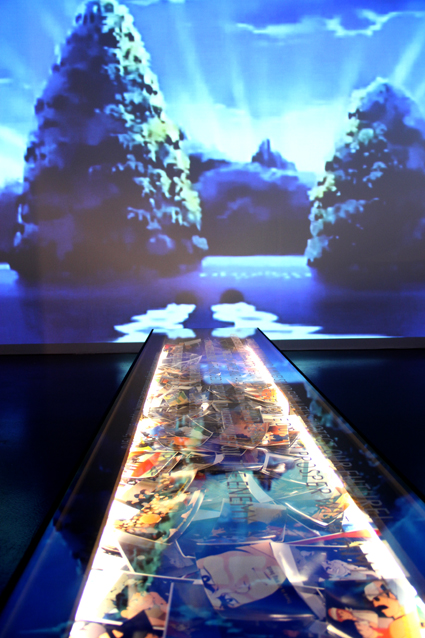
AD: Can you elaborate a bit, what images did you see and how did you (re)use them?
LA: In the installation we focused on this specific case study of the apocalypse scenario which is sketched in a cartoon series called Adnan and Leena in Arabic. In an earlier research essay Simba, the last Prince of Ba’ath country, we extracted images and characters from Arabic websites and speculate on appropriation by showing original images, before they were photoshopped. In a talk we did, we were also drawing connections to the way that Western cartoon characters are suddenly popping up in news footage, and how activists use cartoon identities on the Internet.
GE: Currently there is a full swing of the way Western stories are adapted. For example images of Mickey Mouse or SpongeBob are painted on walls in Syria. In the talk we question whether it is still Mickey Mouse that we see, the one that we remember from our children books, or if it means something else? We compared and related these images to the way such iconography is appropriated and used by both activists and ruling parties. The reuse of symbols and images and how sometimes historical moments are turned into something completely different is very interesting. Such findings are what we are really focusing on.
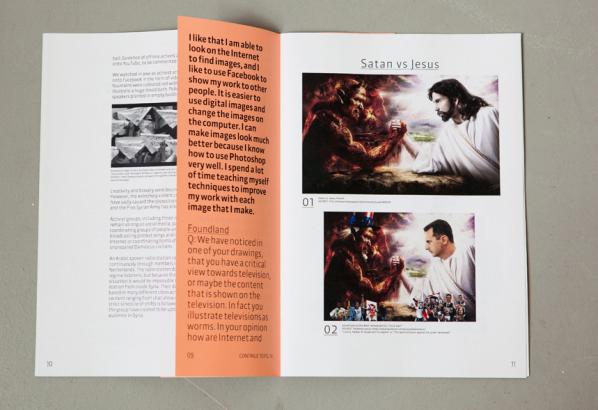
AD: There is also a long and popular tradition of autonomous animation in middle east, how does that relate to what you’ve been researching?
LA: Cartoons are very differently perceived in Syria, and also in South Africa, unlike in the Netherlands, they pose a huge threat to those in charge. For example the government is continuously suing political cartoonists like Ali Farzat in Syria and Zapiro in South Africa because their cartoons undermine existing power structures.
GE: There are indeed many artists who create political cartoons or satirical statements but with these Disney cartoons it was about finding the hidden story of an image. We recognise the cartoons from a Western perspective and the local one. By making connections and telling a different story we want to give a different perspective and a better understanding of what is really happening. Actually I grew up with Japanese Manga, but today Disney is everywhere. This is also political because in the time that Hafez Al-Assad was running Syria there was no American culture at all, when he died his son opened the country a bit for the Western market and you started to see American programmes. Nevertheless, everything is dubbed to Arabic so children don’t necessarily view it as an American production because it speaks their own language and sometimes stories and words are changed in order to better relate to Arabic countries.
LA: The connection to America is not obvious, what we found is that characters like SpongeBob and Mickey Mouse are simply friendly characters. They are your buddy, they help and like you.
GE: That is why they are used in this process of freedom fighting. ‘Your friends’ carrying the freedom flag and are used to create a kind of identification with the message that they want you to see. I mean, it is difficult to hate or not to trust these images because they are icons of friendliness. Whereas the image of a politician or some other hero who is telling a personal story can easily be damaged, a cartoon image is unbreakable. It appeals to children involved in the revolution. So, these images consist of many layers and bring up interesting questions. We aren’t looking for the true answer, because in the end we create our own story.
AD: Could you speak of a sort of universal populism or at least a continuing iconography?
GE: There are many different images, from the Lion and the Father and the Son, to things you see in public space, or images that people grew up with. These are all reused in a digital form and become part of the revolution. People tend to think of them as new images, but when you compare them to older ones, the original, it reflects very much the ideology of the regime. By putting them in a different context we try to force people to question the images and the stories.
LA: I remember that I was in South Africa when we were working on the fiction interview with a propaganda makers text and I had asked my mother to read it. She commented that ‘This is what the government used to say during apartheid, I recognize this’. I guess this shows quite a universal context. We are so used to advertisement and iconography that we don’t question it and tend to ignore the meaning.
GE: Yes, it’s not so different at all, propaganda still uses the same techniques, they have not changed and people fall for it. I think it’s very good to expose propaganda makers.
AD: What new context are you giving it?
LA: Up till now our work has been presented in a western context within the framework of festivals or art spaces.
GE: We wanted to show it to a Western audience, but now we also want to see how it will work when we go to Syria or the Middle East. This will be a challenge because we need to find a way to make that translation back again. We tried already a few times to publish texts for example, but the expectation is very different, stories are more direct and literal, you say exactly what you mean, not the way that we do it here which is reading between the lines.
AD: Is that also why you work in so many ways, from installations, to print, to presentation, to video?
LA: Yes, a lot of this is about experimentation with how things work. We often start from something that we have found online. We find a lot of information, which can be confusing, and then it is about finding the right moment, time and place to present it. Giving it all your attention to dig into an issue, know more and tell more.
GE: Each time we try to define the best way to present what we want to say. It is interesting to open and use the whole research process, it is not just about an end result that is presented. For example, now we are collecting a lot of defection movies from soldiers who are leaving the official army Syrian and joining the free army. What we notice is that the visibility of this free army is that it is only online, on YouTube. We are interested in how an identity of an army that exists on the ground and performs all kinds of operations, primarily takes place on YouTube. The videos of the defectors are almost like a physical performance of defection. We want to collect the story of it, to help people appreciate this image, why it was made, and think about what this means for us.
AD: Digging up memories and confronting people?
GE: When we started the cartoon project we noticed that people were hiding their identity online behind popular cartoon masks. It was really about how people used the Internet.
LA: We discovered that using the Internet is not always about the technical functions of connectivity, distribution, uploading and liking.
GE: If you look for example at how Syrians use the Internet, it’s really for emotional support. A few months ago there was no Internet in the whole of Syria, which was emotionally a big thing because people abroad couldn’t connect to people online and read their contributions. The revolution is nothing without these contacts. All of a sudden a Facebook campaign started called ‘Here is Damascus’. At first I didn’t understand it, but it turned out to be a reference to an event that happened in the 60’s in Cairo, while at war with Israel, the radios were cut off and there was no communication in the city. At that point the city of Damascus changed the name of their radio to ‘Cairo radio’. A political statement, like a re-enactment, happened now on Facebook. The Internet has all these different kinds of layers, of reflecting on history and bringing events to life.
See more Foundland work and updates at www.foundland.info
James Lowne won the Animate Digitalis Prize in 2011, with his computer animation Someone Behind the Door Knocks at Regular Intervals. His latest animation, Our Relationships Will Become Radiant (2012) was recently screened at the BFI and Tate Modern, and is now available on DVD.
Sarah Thompson: First let’s talk about Someone Behind the Door Knocks at Irregular Intervals. How did you go about creating this piece?
James Lowne: Something that interested me was the idea of contemplation and distraction, how we relate to these contrasts in a space where images are in circulation. The production of gestures and poses that are prepared, cropped and then framed for output as media content. So for this film I tried to convey these themes, within a cinematic sense, by way of a narrative. A friend gave me a piece of music and I thought I would set down some pictures to this. I began to source pictures from different places, personal photographs, movie stills, magazine ads, and consider new arrangements of these, treating them as objects. For me this appropriation is an important part of the process.
ST: Appropriation of data objects?
JL: Images could be seen as condensed information perhaps, but what I find interesting is the effect of accumulation, like interchangeable tiles. A grand narrative of the exchange, and this is what becomes more important than the singular image. But conversely, and what I find incredible, is that always within the homogeneous there is this latent singular moment, where one image, an instance of infinite copies, presents itself as unique in a particular situation to a particular viewer. The image selects the viewer, not the other way around.
ST: It has the particular quality of exploring psychic space, which I think is a key quality of Computer Animation. Do you think this is why the medium suits you so well?
JL: Well, I think we should elaborate on the term psychic space. And also think about what we mean by computer animation. What is the working process? What is the form of presentation? Still it is being used within the parameters of filmmaking. Mainstream cinema CGI relies heavily on anthropomorphism, a long line of tradition from early cell animations. To move an object suggests giving it life of some kind, but the process of making the image move is different now, it’s much quicker for one. What the computer brings to the animator is the illusion of a 3 dimensional environment as a working space, the monitor resembling the camera frame. What interests me is the ability to very quickly explore what effects a camera can have over a subject and how the subject has been posed. Capturing gestures from different angles and rendering them into images brings the meaning of this body language into question. The computer can allow you to make these decisions at incredible speeds, whizzing the camera around the subject with your mouse and keyboard. You couldn’t do this so quickly with actual cameras and so a new selection process comes into play, and this for me suggests the relationship of space and surface, and you can work like a machine, running through infinite choices.
ST: So the relationship is perhaps more of a spatial one?
JL: Yes, but a simulated space. The computer allows us to enter into this space and this is with the use of an interface, and this is the fundamental difference from, say, drawing on paper, or painting.
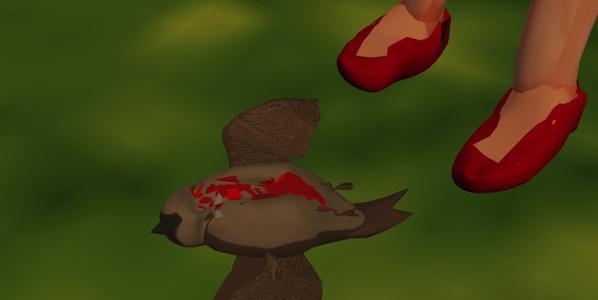
ST: The characters in both films are ‘roughly drawn’ as though you were ‘feeling the way’ as you were making it. Is that so?
JL: Drawing and writing form a starting point for my work, and I am more interested in ideas. I didn’t have a camera or any actors, but I did have a computer. I had learnt how to use all these graphic software programmes from the commercial work I had done. It struck me that the software packages end up monopolising aesthetics somewhat, with a focus on simulating cinematic styles, animating figures in a certain way, and so on. To me this seemed rather pointless and I wanted to try and get a different connection with the machine, to see if I could apply drawing through the interface. I found it very tricky, really.
ST: But through this process you make acutely emotive characters. What sort of commercial work did you make?
JL: The commercial work I had done would involve applying motion graphics onto things, or manipulating footage in post-production. I would go through frame by frame watching the actors or models in corporate adverts and film trailers. Their stylised expressions and poses I really liked, you get to think about them differently when watching them over again, and freezing on a frame of your choice.
ST: Maybe this is why these works are both funny as well as saddening. There is also a strong filmic influence like Psycho, and Blood of a Poet…
JL: For me cinema is a greater influence than animation. I like the way film can generate mood as well as story, and often the techniques of production can overwhelm the overall form. This is what is great about the old, Italian horror films of Fulci or Argento, which have relatively low production values and often, dubious narrative coherence. But this is what is so empty and distancing about them, this form makes them incredible. And the fact that I would watch them on VHS copies of variable quality only amped up the level of horror. I think these old horror films straddle that feeling of humour and terror.
ST: Like Antonioni except horror?
JL: I am not familiar with the work of Antonioni. I know Blowup, and I want to see Red Desert. But I wouldn’t make a connection with him and someone like Fulci though, that’s a whole different ball game. Fulci’s lack of filmmaking skills is the wonderful aesthetic I think, rather than the other way around.
ST: It also has qualities of traditional animation, like leaves quivering in the breeze…
JL: Yes, I like that scene as a cut away. I like the fact that in films you can uses images and sounds of nature to set certain romantic moods. I was interested in the affect that the computer generation of this style would achieve. Is it the same? The leaves look like they are kind of flashing.
ST: The narrative is all implied; do you think this puts the emphasis on the psyche of the central character?
JL: Well, I was learning about cinematic techniques as I was making the film, trying things out. Editing a sequence is very interesting to me, the way subjectivity can be manufactured by putting things next to each other. I think we tend to think about films, web and TV in a natural way when looking at media content – that this is the correct way to order a sequence of images together to tell a story – but for me this is a problem and it lends itself to playing on emotions, and this is also how we are marketed to. Is narrative implied in the dialogue between the object of advertising and the subject of consumer? In the capitalist society we are put into a space to engage with the object of choice, we shift through many surfaces of appearances quickly to construct a reality. Maybe we should edit more films like this, reflect back the illusion and test out new durations. I love the way Warhol’s films have impossible durations, making us consider ourselves rather than the work.
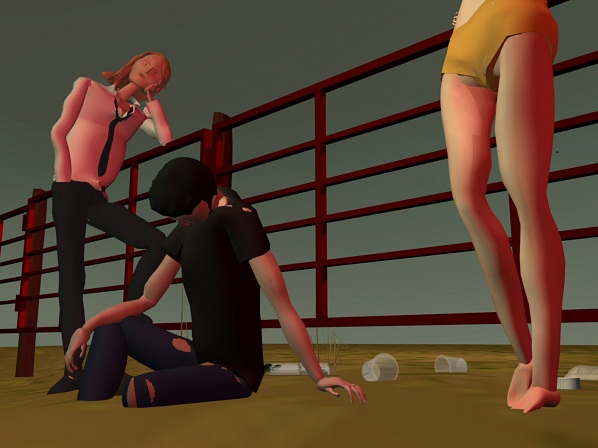
ST: We are very used to, if not inculcated in commercial object relations?
JL: I think Baudrillard uses the term absolute advertising, the form itself of advertising as an operational mode. He also speaks of the demand for advertising. I find it interesting in that we may try to determine our positions in the social sphere within this backdrop, even as we disregard it as meaningless, it has a role in mapping the coordinates in which media moves about.
ST: Do you think we see computer animation in a prejudicial way, and expect certain things from it?
JL: I think people expect certain styles and genres from their cinematic entertainment. I think we look for authenticity in things. We see computer animation everyday and don’t question it, for example on TV commercials, idents for the web, branding and corporate logos. Computer games are having an effect on cinema too. I think only if the context is changed people may question it.
ST: I mean that it’s possible to do things and say things with animation which wouldn’t be so realisable with film, animation is maybe more iconic?
JL: I think film and computing are very much as one now. Anything can be achieved in a post-production suite, and is quite often expected of film today. I think the aesthetics should cross even more rather than CGI trying to emulate film. The opening scene to David Lynchs’ Mulholland Drive for me is a perfect way of using computer graphics and film, and this achieves an amazing effect for the cinema.
ST: In Our Relationships Will Become Radiant there is a similar exploration of the psychic space between individuals to Someone Behind the Door but it is drawn out further and even more oblique. The characters have a special relationship with images in a frame? Like i-Pads almost. They find the ‘photographs’ lying on the ground.
JL: Well, I was trying to use narrative to look at subjects, to look at relationships within a network of some kind. I wanted to let the film generate some of its own relationships. In the narrative there is this kind of defined physical space that these people find themselves in, although they try to make this space limitless. I was interested in the idea that they lose their physicality somewhat, maybe disregarding their bodies, or appropriating themselves as images.
ST: Perhaps the specifics of the narrative ‘don’t matter’, it is as though you are finding the essence of manners of relating which can be more subtle in CG because you can manipulate the models more quickly?
JL: Certain narrative forms we take for granted as real, news reports or some big corporate event, the way these things are mediated to us we accept as a truth, the way that it actually is or actually happened, which is obviously not true. I think narrative forms should be explored to allow us to think about what we take for granted as truth, and even further, how do we act in the space of choice between different truths when the mediation of these subjects is the same?
ST: Is it that a narrative can be suggested, but it doesn’t actually have to be a narrative to have a narrational effect? And then it is sort of how we find meaning symbolically in pictures, and that helps us to make sense of life?
JL: Well, exactly. Questioning things is very important, especially if we are to live in a network of images. In conventional narrative forms emotion and passion can be exploited very easily, and maybe this helps keep those accepted forms of mediation in operation. Cinematic narratives can be reframed in new stylistic approaches to adapt to the present ideology, but are we breaking away from the conventional structures?
The DVD is available from the BFI shop, published by Filmarmalade, and it also includes a second new film, Corporate Glossy Warhol Burger, co directed with Gordon Shrigley
We live in a world riddled with contradictions and confusing signals. Our histories are assessed, judged and introduced as fact yet there are so many bits missing. We accept what is given through soundbite forms of mediation and end up using the easy bits as our defaults, and build up these assumptions as our ‘imagined’ guidelines. This article examines how these accepted defaults are being challenged by contemporary artists. Each have expressed their own particular (unofficial and official) form of interventions at the Tate Gallery. Featuring art works produced by artists’ and art groups, such as Graham Harwood, Platform, IOCOSE and Tamiko Thiel, we explore their connected enactments and critiques of the existing conditions. Whether it is based on economic, ecological, historical, political or hierarchical situations, they are making others aware of their creative arguments in different ways.
You will not see them accepting an award at the Turner Prize. But, their work has become as equally significant (perhaps even more) than, the mainstream art establishment’s franchised celebrities. There is now wider art audience out there, connected to the Internet and they are aware of the issues of the day. Yet, this context is not reflected back by traditional art venues and art press. Instead, we receive more of the same. The mainstream version of contemporary art has found its allies within a global and corporate culture, where business dictate’s art value. Critical and imaginative contexts contrary to neoliberal demands, are left aside. We cannot trust the ‘official’ art world to produce a realistic vision of what contemporary art really is. It is up those who are not reliant on or diverted by these powerful frameworks and elusive economies, to bring about a different set of examples of an existing parallel world which is thriving, and so much more interesting and relevant.
“Art is subject to a double protection. In the market, it is shielded from unwarranted treatment through controlled ownership. In the museum world, experts decide what should be seen, alongside what, with what interpretation and in what circumstances. A wide public is courted but allowed no power over what it sees. The very ethos of this culture—of exclusivity, elitism and control—is now at odds with the culture people make themselves.” [1] (Stallabrass 2011)
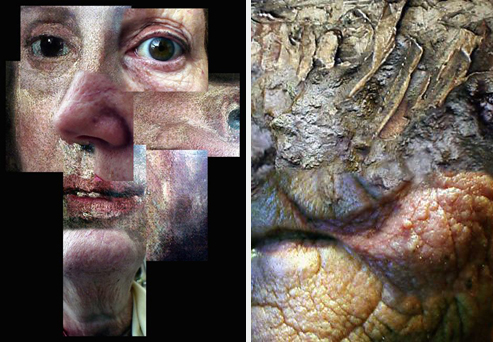
“From adolescence I had visited the Tate, read the Art books and generally pulled a forelock in the direction of the cult of genius, on cue relegating my own creativity to the Victorian image of the rabid dog. We know well enough that this was how it was supposed to be. The historical literature on ‘rational recreations’ states that, in reforming opinion, museums were envisaged as a means of exposing the working classes to the improving mental influence of middle class culture. I was being inoculated for the cultural health of the nation.”[2] (Harwood)
In 2000, Graham Harwood[3] received the first Net Art online commission from the Tate Gallery London for the creation of his art work ‘Uncomfortable Proximity'[4]. Viewing the visual images/collages created by Harwood; reminds one of the moment when Dorian Gray in Oscar Wilde’s ‘The Picture of Dorian Gray'[5] views his disfigured self portrait. Considered a work of classic gothic fiction with a strong Faustian theme. The facade of his own idealised beauty is revealed as something less attractive and deeply disturbing. Harwood’s approach in offering the viewer to click on the image to see what lies behind shows the people he represents, to be seen as lurking secrets, as ghosts, mutants, lepers and outsiders.
![Dorian in front of his portrait in the 1945 film The Picture of Dorian Gray.[6]](http://www.furtherfield.org/wp-content/uploads/2012/12/dorian-gray.jpg)
“Tate Britain stands on the site of Millbank penitentiary incorporating part of the prison within its own structure. The bodies of many of the inmates remain concreted into the foundations of the building. The drains that run from the building to the Thames, a stones through away, bleed this decay into the silt of the Thames.”[7] (Harwood 2006).
Harwood brings to the fore the forgotten people. The lives of others, whose stories are now just distant markers of a past, dominated by a colonial history. These are the losers, the then ridiculed and exploited chavs of their day.
“‘Chav’ is an insulting word exclusively directed at people who are working class.”[8] (Jones 2012).
The first section of ‘Uncomfortable Proximity’ maps high society rituals of tastefulness and its inherent hypocrisy. The second, representations and histories of different people such as friends, family and others, who are unseen in terms of the institution’s remit of tastefulness. To do this he used the historically respected paintings (on-line images) on the Tate web site by artists such as Turner, Hogarth, Hamilton, Gainsborough, Constable and others.
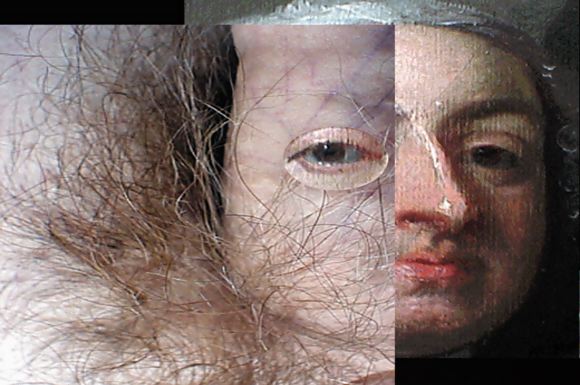
“This work forced me into an uncomfortable proximity with the economic and social elite’s use of aesthetics in their ascendancy to power and what this means in my own work on the internet.”[9] (Harwood 2006)
London’s Tate Britain area, before it was reconstructed into an art gallery, in the early 19th century was a national prison. The Millbank Penetentiary, was hailed as the greatest prison in Europe, at a cost of £500,000 it was finally built in 1821. It was Jeremy Bentham, the British philosopher and philanthropist who designed it using his pionering ideas creating the prison as a ‘panopticon’.
“At its centre was the Governor’s House, which allowed prison guards to keep watch over 1,500 transportation prisoners housed in separate cells in the surrounding pentagonal blocks. There were three miles of cold, gloomy passages: the turnkeys invented a code of chalked directions to stop getting lost in the maze!”[10]
Sentenced prisoners were processed in the prison each year and up to 4,000 would then be sent off to distant lands, such as Australia. Within the panopticon, prisoners would not know whether they were being watched or not.
“The panopticon Panoptic power built into the architecture of Benthams’ prison Prefigured what some refer to as the “electronic panopticon” or “surveillance society” which includes: the mass surveillance & collection of data by government on populations; the surveillance & collection of data on consumers for marketing purposes; the management surveillance & control of the workforce by industry.”[11] (Ballantyne)

Somehow Harwood manages to bite at the hand that feeds him, “the artist very deliberately used the work to question the role of digital media in promotion and collection. His Web site copied the Tate publicity site, with his own content inserted, causing substantial institutional disruption around the marketing department because the Tate’s Web site, in common with those of many art museums, was seen primarily as a marketing tool, then perhaps as interpretation, but never before then as a venue for digital art.[12] (Cook, 2001).
At his point it’s worth considering how some artists have experimented with the behaviour of parasites in order to explore their artistic autonomy at the edge of things. The rise of hacking and ‘art and hacktivism’ has brought about artists reimagining their creative intentions not in terms of existing within the frameworks of galleries and museums (although many do show their work in these types of venues as well). Many have chosen not to comply to the ‘official’ script of marketing demands and values imposed by mainstream art world hegemony, or concede to centralised web 2.0 structures dominating Internet culture and our mobile networks.
“The word ‘parasite’ comes from ‘para sitos’, meaning ‘beside the grain’, and refers to those animals that take advantage of grain stores to feed. […] they are not part of the restricted economy of exchange, profit, and return that is at the heart of capitalism, and to which everything else ends up being subordinated and subsumed. Thus they find an enclave away from total subsumption not outside of the market, but at its technical core.”[13] (Gere 2012)
![Haw under arrest before the State Opening of Parliament in 2010. Photo: Jeff Moore. Telegraph.[14]](http://www.furtherfield.org/wp-content/uploads/2012/12/haw-police_1924712b.jpg)
In June 2001, activist Brian Haw began his protest against the economic sanction on Iraq, opposite the Palace of Westminster in central London, until his death of lung cancer in June 2011. He earned himself a place in the history books for what he devoted ten years of his life doing, camping in a tent outside the Palace with numerous placards. First it started with only a few banners and then through the years the number of banners accumulated, with its content pointing out to the public and politicians, the huge suffering and killing of people in Iraq supported by the UK government. “Even as fresh attempts were begun to oust him, he won an award for being that year’s ‘most inspiring political figure’.”[15] (Stevenson 2011)
In 2006-7 British artist Mark Wallinger created an installation called State Britain, replicating all of the tents and banners at Parliament Square. Featuring it as his main entry for the Turner Prize at Tate Britain. “Faithful in every detail, each section of Brian Haw’s peace camp from the makeshift tarpaulin shelter and tea-making area to the profusion of hand-painted placards and teddy bears wearing peace-slogan t-shirts has been painstakingly sourced and replicated for the display.”[16] It also included copies of other people’s contributions, consisting of messages and banners amassed by Haw over the years, as a constant and dedicated daily protester, winning Wallinger the Turner Prize.
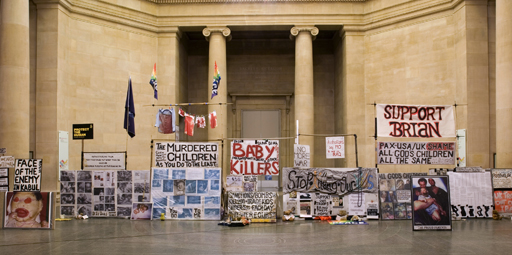
“…the larger hand-painted signs are defanged by their new context. “Beep for Brian,” once an irreverent call-to-arms taken up by many motorists plowing through the Westminster traffic, has become an absurdity, un-honkably sealed within the echoing marble box of the Tate. Never has the notion of the “lost original,” that timeworn legacy of Duchamp’s ready-mades, carried such a melancholic charge.” [17] (Street)
In contrast to his peers who also came out of the YBA (BritArt) movement in the late 80s and early 90s, which includes individuals such as Damien Hirst, Rachel Whiteread and Tracey Emin, Wallinger is a committed socialist. Damien Hirst was “the leading light in the YBA movement, is a famously good businessman and is now one of the richest men in England.”[18] (Shaw 2011)
“I did feel removed from the YBA thing. But it almost immediately raised people’s game. There was money and there was an audience. Or, to be strictly accurate, there was money – it really was a very targeted strategy to begin with – and the audience came along a bit later.”[19] (Wallinger 2011)
Wallinger’s comments about the audience coming along later rings true. The power of money and marketing created an audience that before,was not there, specifically for the YBA’s. Emerging artists at the time, who were not part of this elite where left out of the picture, not because of their art but because of their lack of connections with YBA circles. Many artists casted their creative intentions and values aside and re-invented their art in accordance to YBA themes, with a hope they would be accepted by this (then) new, mainstream art establishment. From the early 80s, and well into the 90s, UK art culture was dominated by the marketing strategies of Saatchi and Saatchi, a formidable force in the advertising world. The same company had been responsible for the successful promotion of the Conservative party (and conservative culture) that had led to the election of the Thatcher government in 1979. Saatchi and Saatchi Applied their marketing techniques and corporate power, with an accomplished parallel coup within the British art scene, creating an elite of artists who embraced the commodification of their personalities alongside depoliticized artworks.
Stewart Home proposes that the YBA movement’s evolving presence in art culture fits within the discourse of totalitarian art “the critics who theorise the yBa understand that by transforming art into a secular religion, rather than a mere adjunct of the state, liberalism imposes its domination over the ‘masses’ far more effectively than National Socialism. The focus, especially in the mass media, must be on the artists rather than the artwork.”[20] (Home 1996)
“To be an artist is to contend with the present, and there are not many other careers that afford the freedom to radically examine life and society. To put it bluntly, if artists are studying and writing more about politics, culture, and education, it’s probably a reflection of the unprecedented dysfunctionality of the societies in which they live.”[21] (Deck 2005)
Every now and then something slips through the highly taught institutional web of marketed ideologies and it causes a state of ‘healthy’ unease. One such intervention is the recent collaborative project Tate à Tate.[22] It is a public intervention consisting of an audio guide that people can download onto their MP3 players or mobile phones. The material is accessible from http://tateatate.org – you download a selection of audio files and then take a physical tour to Tate Britain. It is best experienced if you take the Tate Boat to Tate Modern, or you can listen at home. The artists selected to make the sound works are Ansuman Biswas, Phil England, Jim Welton, Isa Suarez, Mark McGowan and Mae Martin.
Mark McGowan, through his daily and weekly online video broadcasts on Youtube and Vimeo, has gained a large Internet-based audience. His videos have appeared on the BBC and the Russia Today news channel. He is a performance artist and constant ‘angry’ critic of the UK government. He has never voted and, is equally critical towards whatever party happens to be in power at the time. Mcgowan’s antics have received interest because of the directness of his arguments. He speaks for and to those who do not have a voice. He reflects upon unjust situations happening in real life. He has become an alterantive force to a ‘politically’ corporate media, who offer no way in for those are not already connected with the elites of institutionalized power.

McGowan, has caused various controversies. In 2007, during Celebrity Big Brother when Jade Goody made what seemed to be racists remarks to her house-mate Shilpa Shetty; he publicised an event in support of Goody, which was a protest to burn an effigy of shetty. In the end did not take place.
His position, was that working class people were being used by the media as product to feed a machine, exploiting everyday people’s vulnerabilities. It is also an attack on the media invention of ‘Chavs’, a deliberate attempt to demonise the working classes of Britain. In retrospect, many viewed incident on Celebrity Big Brother as a clash of classes, and not necessarily a rascist issue. But, it was all too late, the media took control of what it saw as a chance to create a larger spectacle out of an already bleak situation.
“The media despised her. […] ‘Vote the pig out!’ demanded the Sun, which also referred to her as an ‘oinker’. Others taunted her as a vile ‘fishwife’ and ‘The Elephant woman’. As the campaign became a hysterical witch-hunt (indeed, one fo the headlines was: ‘Ditch the Witch!’), members of the public stood outside of the studios with placards reading: ‘Burn the Pig!’.” [23] (Jones 2012)
Dominant ideologies are cultivated hegemonically as part of the mainstream consciousness. And even though, the messages communicated through these channels do not accurately reflect real life, they do reflect stereotypes and easy packages of soundbite items on a cruder (lack of) understanding of what human values are, indivudally and collectively. These ‘mediated’ structures, socially re-construct according to ‘commercialised’ trends rather than looking at deeper resonances. Which should also include a necessary critique of their own roles and responsibilities, aksing what does it do to the psyche of a culture when you creating a spectacle out of the everyday; from fantasy into a permanant state of hyper-reality for profit?
“The poverty of the accepted culture and its monopoly on the means of cultural production lead to a corresponding impoverishment of the theory and manifestations of the avant-garde. But it is only within this avant-garde that a new revolutionary conception of culture is imperceptibly taking shape. Now that the dominant culture and the beginnings of oppositional culture are arriving at the extreme point of their separation and impotence, this new conception should assert itself.” [24] (Debord 1957)
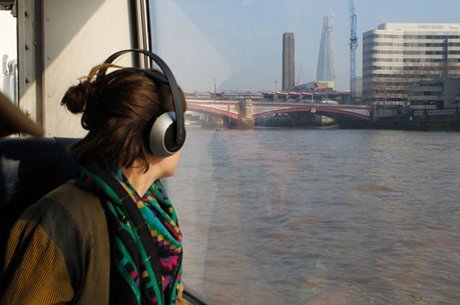
In art, in politics, and in all avenues of power in our culture, the working classes have no voice. It seems that the only way to claim personal power is by submitting to the embarrassing scenario of applying as a contestant on what is ironically termed as reality TV. and, this involves singing someone else’s already ‘bland’, tedious songs, usually written by corporate music media. The divide of class is ever present as colonial systems prevail in exploiting not only foreign resources and the destruction of indigenous peoples’ histories and their ways of living; but also in the very states and countries where these corporate ‘friendly’ neoliberalist cults reside. In respect of oil and funding of the arts, Tate à Tate pulls these issues out from being hidden into a mainstream dialogue through their own interventions.
As the markets have gained an increasingly tighter hold on global economics and everyday people’s lives, a rise of international protests has also gained impetus. We have the Occupy protests which have spread from Wall Street to London to Bogota, in over 950 cities in 82 countries. We also have the UK Uncut protest movement challenging the government’s austerity cuts. The Internet has been a valuable medium, allowing people to connect and organise together. This has enhanced crossovers where artists have become activists and activists artists. New forms of ‘networked’ and ‘activist’ expression, exploiting the imaginative skills of artists (and others) has brought brought about a mix of ideas once used by the Situationists. If you are a typical gallery attendee or a purchaser of mainstream art magazines, awareness of current political and ecological issues through these cultural interfaces are rare. Interventionist art challenges this standard. Causing a social anomaly, fracturing the facade of what we are usually informed of as ‘national’ value.
Tate a Tate is a collaboration between the groups Platform, Liberate Tate and Art Not Oil. The work was a response to when BP was promoting its sponsorship activities in the run-up to the 2012 Olympics. Against the British Museum, the National Portrait Gallery, the Royal Opera House and Tate Britain, aligning themselves with BP (British Petroleum). By receiving sponsorship from BP they say these institutions are “legitimising the devastation of indigenous communities in Canada through tar sands extraction, the expansion of dangerous oil drilling in the Arctic, and the reckless business practices that lead to the deaths of eleven oil workers on the Deepwater Horizon. BP’s involvement with these institutions represents a serious stain on the UK’s cultural patrimony.”[25]
Mel Evans, Platform: “Tate à Tate began from a creative impulse to install something somehow immovable in Tate. Platform and Liberate Tate were collaborating on the publication ‘Not if but when: Culture Beyond Oil’, which features international artists work in response to the BP Gulf of Mexico catastrohpe, and sets out the key debates on oil sponsorship of the arts. We had noticed our critics were often alluding to a kind of inevitability of BP sponsorship.”
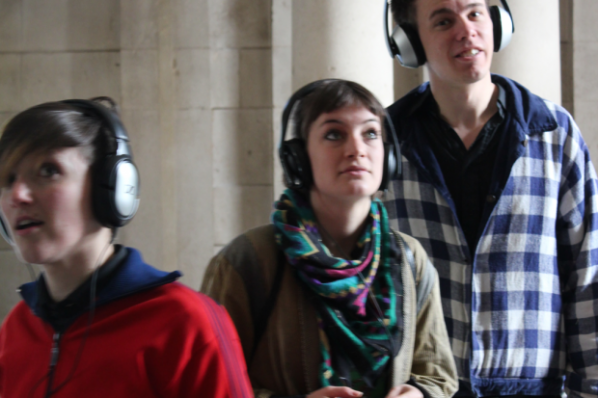
“Liberate Tate’s spectacular performances, although headline grabbing, had all been swiftly cleaned up by Tate staff. Although we knew tough questions were being asked by the Board of Trustees, and 8,000 members and gallery-goers had petitioned Director Nicholas Serota to drop the sponsorship, we also wondered to what extent Tate could absorb our efforts into its own politically savvy artistic persona. So the idea of an audio tour seemed the perfect way for us to create a permanent installation in Tate, challenging BP’s continued presence in the gallery, and recreated by every participant that takes the free download and goes ‘undercover’ in Tate.”
“The process began with a call out for proposals which received a terrific response. From this we came down to three proposals that we thought were equally fantastic and sufficiently different to all warrant exploration – which is where the three chapter journey was born, from Tate Britain to Modern via Tate Boat. From the launch in March 2012 onwards we quickly learned that participants were keen to pick a favourite of the three, their choices were hard to predict.”
“For some, the water related narratives in ‘This is Not An Oil Tanker’, created by Isa Suarez featuring Mae Martin, Mark McGowan and Jasmine Thomas, make the piece the most emotive experience. Others prefer the structure and highly informative content of ‘Drilling the Dirt (A Temporary Difficulty)’ by Phil England and Jim Welton, and likewise other tastes feel most comfortable in the more meandering and evocative ‘Panaudicon’ created by Ansuman Biswas. Panaudicon by Ansuman Biswas at the Tate Britain is by far the most successful… its interaction with and interpretation of its environment is a lot more complex. As initiators of a project with which we want to reach diverse audiences, we’re glad there’s something in there for everyone.”
![Winner of the recent Greenpeace Rebrand BP Competition. Designed by Laurent Hunziker [26]](http://www.furtherfield.org/wp-content/uploads/2012/12/rebranded.jpg)
You can understand why questions around the Tate’s association with BP is of utmost importance. Especially, when considering the oil company has had as many as 8,000 oil spills in the USA alone. There is a long list of disasters and much information linking BP’s troubling courtships with oppressive regimes. Shell, BP, Exxon, Gazprom, Rosneft and other companies, as I write this, are engaged in a frenzied rush in the Arctic risking yet another oil spill and threatening us with even more climate change. And all this effort is for only three years worth of oil.
‘”For over 800,000 years, ice has been a permanent feature of the Arctic ocean. It’s melting because of our use of dirty fossil fuel energy, and in the near future it could be ice free for the first time since humans walked the Earth. This would be not only devastating for the people, polar bears, narwhals, walruses and other species that live there – but for the rest of us too.” [27] (Greenpeace 2012)
Recently in 2012, BP agreed to pay the largest criminal fine in US history for its corporate negligence, in causing the catastrophic Deepwater Horizon oil spill in the Gulf of Mexico. “This was a disaster for the record books: The offshore exploratory well was the deepest drilling ever, plunging more than 30,000 feet through ocean and seabed strata, and the spill was the largest in U.S. history, spewing 206 million gallons of oil — nearly 20 times what the Exxon Valdez had dumped into Prince William Sound in Alaska a decade earlier.” [28] (Schiffman 2012).
In 2011, the New Orleans, LA. Attendees of the ‘Gulf Coast Leadership Summit’ witnessed a positive statement from a representative of the US Department of Health and Human Services (HHS) as he announced to everyone’s surprise a ban on toxic dispersants, and a new free health care plan for spill and cleanup victims. Not just that, there was also another progressive announcement by the BP co-presenter that day who publicly expressed regret for his company’s past actions, he said the oil giant would also pay the bill for the new health care plan.
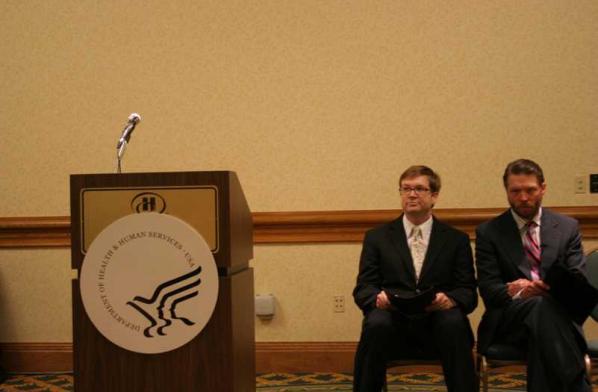
Of course, it was all to good to be true. it was a hoax by the Yes Men [29].
“…except for the audience, everyone was a fake. The impostors Dr. Dean Winkeldom and Steve Wistwil, both Gulf Coast residents, collaborated with the Louisiana Bucket Brigade[30], an organization whose goal is to create sustainable communities free from industrial pollution. The organization decided to create a hoax to publicize what should be happening in response to the emerging health crisis.” [31] (Flaherty 2011)
“The Louisiana Bucket Brigade action was supported by the Yes Lab, a project of The Yes Men that helps activist groups carry out media-getting creative actions on their own. Four years ago in New Orleans, The Yes Men impersonated an official from the Department of Housing and Urban Development to announce, among other things, that HUD would re-open public housing and make oil companies pay up for wetlands destruction.”[32] (ibid)
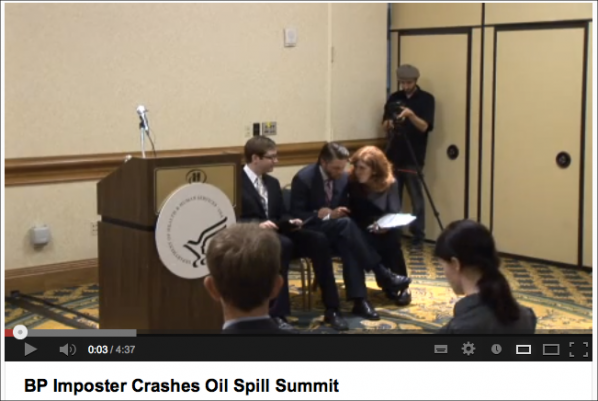
Morgan Quaintance reviewed it for Art Monthly and found that “the Tate Britain and Tate Boat works suffer from a confused sense of purpose… on the other hand, England and Welton’s Tate Modern piece is a note-perfect subversion of the standard form.
Meanwhile Kate Kelsall reviewing for Don’t Panic online reported “There is something irresistibly subversive about slinking around an establishment with your headphones in, taking orders from a voice that resembles a TomTom or sleep aid recording…
Jonathan Jones, after the Tate had renewed its deal with BP wrote in an article in the Guardian “Oh, give me a break. The campaign to stop Tate, the National Portrait Gallery and other museums from accepting money from Britain’s controversial petroleum outfit is the stupidest and most misplaced of supposedly radical campaigns. Why not do something useful like join Occupy? While protests around the world this year, from Wall Street to Tahrir Square, have picked the right causes and enemies, the BP art campaign is mistargeted, misconceived and massively self-indulgent.”
‘About 50% of global trade is channelled through tax havens and 83 of the 100 largest multinationals are based in the Netherlands for fiscal reasons. The flow of money seeks the path of least resistance – but where exactly do those paths lie today?’
This is how graphic designer Femke Herregraven began a presentation about her new online game Taxodus. Herregraven designed the prototype of Taxodus, a game about offshore tax avoidance, during a master class at Sandberg-Mediafonds. The offshore system offers companies advantages in countries where legislation relating to non-nationals guarantees certain privileges, for example, when it comes to corporate structures, in certain areas of business confidentiality, or low taxation. Taxodus is an accessible way to discover how you can avoid paying taxes, and if you can’t get away with it completely, how you can make sure you pay the lowest possible amount.
Annet Dekker: Taxodus is a game about offshore business practices. How does it work?
Femke Herregraven: As a player you choose an existing multinational company or bank with a specific profile and then you look for the most favourable countries to set up a subsidiary and accumulate income by paying as little tax as possible. Each country has a specific transaction profile. For example, companies involved with Intellectual Property Rights find the Netherlands most appealing, while oil companies are drawn to other countries. The game offers a random number of options and calculates what these yield for you. You can compare the results with other countries to achieve the game’s goal of reaching the end with as little expenditure as possible. The game is based on actual information on withholding tax in global tax treaties.
AD: This isn’t a topic you usually encounter in art. Where does your interest in this subject originate?
FH: In 2010 I was asked by the Virtueel Museum in Amsterdam to research the identity of the Zuidas during a residency. The Zuidas, which literally translates as ‘South Axis’, also known as the ‘Financial Mile’, is a large, rapidly developing business district in Amsterdam. Much like Richard Florida, they wanted to ‘cheer up’ the neighbourhood. My questions about the companies located there received only vague responses; there weren’t any lists, or names, or post boxes, and with the exception of known names like Google and Facebook, the other companies that are based there was a mystery. To trace what type of businesses might be located there I spent weeks indexing the entire Zuidas from the Chamber of Commerce’s trade register. I indexed the occupants by street and house number and then compiled three telephone books from the data. All sorts of unusual data and patterns became evident – some addresses only have one occupant, while others have more than a thousand of the so-called mailbox companies that only exist on paper. This is also apparent from the names: some only consist of Roman numerals.
All this information piqued my curiosity and I wondered why these companies were situated there and what they were up to. The next step was delving into Dutch tax law and it became clear that there are enormous financial benefits to setting up a company in the Netherlands. This is a major selling point when Holland is promoted abroad. The entire offshore system has operated below the radar for a long time – sometimes we catch a glimpse of it – but quite how it works in its entirety almost no one knows. The first step to understanding this is visualising it to gain insights, and then you can ask specific questions. Taxodus classifies this information by visualising it: from mining in the Congo to oil companies in Italy and Libya.
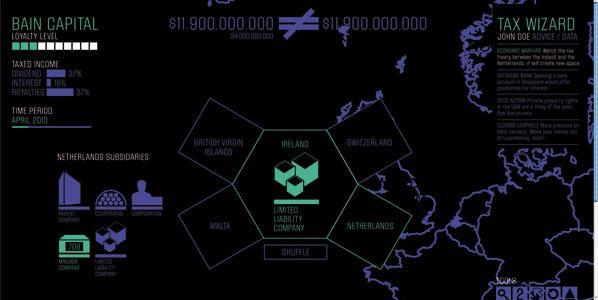
AD: It all sounds very murky!
FH: It’s all completely legal, but shady at the same time. If a foreign company doesn’t want to open a physical office in the Netherlands, it hires a trust office that takes care of the bookkeeping, drafts the annual reports and appoints a CEO. There are countless small trust offices that manage huge numbers of foreign companies on paper. Everything is done according to Dutch law and the tax benefits in Holland are hugely beneficial for foreign companies. For example, small businesses in the Netherlands pay more than thirty per cent tax, while foreign companies avoid a large part of that taxation due to tax planning. The presumption that foreign companies basing themselves in Holland is beneficial for national employment is also misleading because most of these companies only exist on paper and don’t employ anyone. The trust offices advise against opening a physical office and taking on any staff because Holland attaches great value to its employment policy, which makes dismissing personnel difficult. A ‘mailbox’ company avoids all these complications.
AD: But the way in which you visualise this is also subjective because you manipulate the data.
FH: Yes, I selected companies that people will know or which appeal to the imagination. Unfamiliar names won’t really be noticed, but once you realise that almost everyone participates in this system, from Mitt Romney’s Bain Capital, Walmart, Google and Facebook to Chanel, then it takes on a different immediacy or value for many people. If you look at this on a wider scale – globally – you will see, for example, that 60 per cent of large companies in Portugal, Italy, Greece and Spain use the Netherlands to take advantage of these types of constructions. This is legal and it’s also beneficial to the Netherlands, but when Dutch politicians insist on more transparency from Greece and lecture the country from up on high it smacks of hypocrisy. You see the same thing with a lot of development aid to countries in Africa: most of that money is diverted to the bank accounts of African leaders in offshore tax havens. Someone has done the maths: the debt of the entire African continent is less than the monies African leaders hold in offshore tax havens. A ‘mailbox’ company by itself is not that suspicious, but with everything else it creates the holes through which (public) money can disappear. My primary intention is to make these flows of money visible and question them, because once it’s out in the open people can decide for themselves if this is our idea of a sustainable economy.
AD: Of course, your game can also be interesting for existing companies who can use it to see where and how they can best invest? Is Taxodus the new Monopoly?
FH: Yes, in a way it is, but in reality companies have been doing this for ages. General Electric supposedly has a department employing about a thousand people who are busy with this on a full-time basis. I don’t think my game will suddenly improve things. Yet, the point is that the knowledge about international tax planning is now only in the hands of experts like fiscal lawyers and accountancy firms, and isn’t accessible to the rest of us. That’s also what Taxodus is about, making a tool so that we can track what they’re up to.
Monopoly is an interesting comparison because it originated as a critique of capitalism and private monopolies. The games are comparable, but Taxodus goes further. If you make a move in the game that correlates to reality then you are informed about this and receive a reality-bonus. It’s at this point in the game that investigative journalism comes into play.
AD: How do you relate to investigative journalism?
FH: My projects frequently begin from a journalistic position and for this one I meet with journalists, fiscal lawyers and researchers quite often. Yet, I’m a designer and I don’t want to write articles but use other methods to provide insights into topics. For me design is not an end in itself but a way to research, express and contribute to debates in society. This means also collaborating with other disciplines and experts: a group of fiscal experts is currently helping to remove errors and provide feedback. Obviously, it’s impossible to create a 1:1 translation, there will always be things that aren’t entirely accurate or that have to be left out, but it is important that the broad outlines are clear and correspond with reality.
AD: Why a game?
FH: Avoiding and evading tax is complex but you can learn the psychology of this system by playing the game. Taxodus is actually a kind of chess game. The rules aren’t simple and your eventual benefits depend on all sorts of interrelated factors. You have to continually take strategic decisions to advance in the game. All this information is incorporated into the game and the various tax treaties between different countries gradually become clearer. You are aided in this by advisors. At the start of the game you chose a particular advisor. Different advisors offer different advice, some will try to find legal alternatives while others try to convince you to bend the rules. Players can ask for a second opinion at any point in the game and manipulate regulations and treaties. This enables players to steer the game in the direction they choose. As in reality, a player has to have the possibility to have complete control. Ideally the game should be a do-it-yourself kit that you can add things to, an open game of strategy.
AD: What do you mean exactly? Can you name an example?
FH: The simplest way is to play it alone; the more complicated version is played with others in real time. At a certain point you can earn loyalty points by, for instance, evading high taxation for your parent company. Once you’ve arrived at the loyalty level, you can change roles, perhaps becoming a government employee who modifies regulations ever so slightly to make it more beneficial for yourself. You can also block other players in this way. This is an obvious reference to the increasing merging and blurring of the interests of large corporations and political leaders.
AD: How do you keep up with actual changes in the real world?
FH: It isn’t as if new information is constantly being made available – a lot of countries are reluctant or refuse to release ‘sensitive’ information. Tax treaties and regulation doesn’t change too often, but when they do, these changes will also be incorporated in the game. The English researcher Nicolas Shaxson, who is very active in charting the offshore system, says that people have to first become aware of what’s happening before they can think about how to deal with it. I hope my game and visualisations can contribute to this awareness raising.
AD: When or how does the game end?
FH: You have a certain amount of time before you have to submit an annual report for your company, then your trajectory is incorporated into the database and you can see what your score is. You can also compare it to other players and download their fiscal structure, which adds an element of competition and makes it a crowd-sourced investigation. By playing you contribute to the research and help expose the layers.
AD: Will Taxodus be a commercial success?
FH: My main concern is to make a tool that makes this small yet incredibly significant part of our opaque financial world more transparent, and especially more public. I think artists have a responsibility to broach topics like this. People find it all quite shocking when I tell them about Taxodus, but for those who are directly involved in the actual system it’s mere child’s play. This type of project can stimulate discussion and determine what is and what isn’t desirable.
This approach was shown to be successful with another project, the Art Reserve Bank. We set up a bank with a small group of artists and designers and introduced a new currency in the heart of the Zuidas as a way to encourage discussions about the financial sector. Our bank – a vault, an exchange counter and a glass house with a minting press: a bank brought back to basics – is located across from the ABN AMRO headquarters, and each day some of the employees and other people come by to see what we’re doing and have a chat. People also buy our coins, which are designed by a different artist each month. It doesn’t always go smoothly, but there is certainly enough curiosity. One problem is that people are personally interested but refuse to make any statements in a professional capacity. De Nederlandsche Bank (the Dutch central bank) recently sent us a letter stating that we cannot use the word ‘Bank’, threatened us with a fine of up to 2 million euros and invited us for a talk. These types of discussions are what we aim to achieve. Our goal isn’t necessarily to introduce a new currency; instead we want to underscore that fact that the bankers and financial experts of this world do not have exclusive rights to debate and decide what happens on financial markets.
———
A Dutch version of this interview appeared in Tubelight, September 2012.
Femke Herregraven: http://www.bitcaves.net
I met Eugenio Tisselli in Edinburgh at the Remediating the Social conference in November 2012. Eugenio gave a presentation on the project Sauti ya wakulima, “The voice of the farmers”: A collaborative knowledge base created by farmers from the Chambezi region of the Bagamoyo District in Tanzania, and “by gathering audiovisual evidence of their practices they use smartphones to publish images and voice recordings on the Internet”, documenting and sharing their daily practices.
I was struck by his sensitivity to the social contexts and political questions around this type of project engagement. This interview explores the challenges we all face in connecting to a deeper understanding of what technology can succeed in doing beyond the usual hype of the ‘New’ and its entwined consumerist diversions. Not only does the conversation highlight how communities can work together in collaborating with technology on their own terms. But, it also discusses the artists’ role in the age of climate change and the economic crisis, locally and globally.
Marc Garrett: Can you explain how and why the Sauti ya wakulima, “The voice of the farmers” project came about?
Eugenio Tisselli: Sauti ya wakulima is the fruit of my collaboration in the megafone project, started in 2004 by Catalan artist Antoni Abad. During six years, we worked with different groups at risk of social exclusion, such as disabled people, immigrants or refugees. The idea was to provide these groups with the tools to make their voices heard: smartphones with a special application that made it easy to capture images, sound recordings or short videos, and a web page where these contents could be directly uploaded. Using these tools, the participants of each project were able to create a collaborative, online “community memory”, in which they could include whatever they considered to be relevant. Although megafone was relatively successful and, in some cases, made a positive impact on the people who participated, I was worried that the project was becoming too dispersive. We worked in six countries, with extremely different groups. So, in 2011, I decided to follow my own path and apply a similar methodology into more focused projects, related with sustainable agriculture and environmental issues. I realized that the projects which sought to increase the empowerment of a community could become too complex for a single artist to handle. That’s why, in Sauti ya wakulima, I’m not “the artist”, but a member of a transdisciplinary team which includes biologists, agricultural scientists and technicians. Such a team came together after my PhD advisor Angelika Hilbeck, my colleague Juanita Sclaepfer-Miller and myself came across the possibility of working with farmers in Tanzania. The network formed by local researchers, farmers and ourselves was quickly formed, so we started the project on March, 2011.
MG: I find it interesting that you made the decision to put the role of artist aside. This reminds me of a discussion in Suzi Gablik’s book published in 1995 ‘Conversations before the end of time’; where James Hillman in an interview talks about learning to refocus our attention from ourselves and onto the world. Further into the conversation Gablik says “In our culture, the notion of art being a service to anything is an anathema. Service has been totally deleted from our view point. Aesthetics doesn’t serve anything but itself and its own ends”.[2]
So, I have two questions here. The first is how important was it for you to put aside your status as an ‘artist’, and what difference did it make?
And, where do you think you and others may fit when considering the discussion between Gablik and Hillman?
ET: It is important for me to make it clear that I didn’t abandon my role as an artist. Instead, I fully assumed my status, but only as a member of a transdisciplinary team. I believe that this may be a point of departure from the classical view of the artist as a “lone genius”, which is closely related to the discussion about service in art. So I’ll try to interweave both questions together. In a recent publication, Pablo Helguera aimed to set a curriculum for socially engaged art. He identified the new set of skills to be acquired by the artists, and the issues they must address when dealing with social interaction. But, as Helguera suggests, perhaps what’s most important is to overcome the “prevailing cult of the individual artist”, which becomes problematic for those whose goal is “to work with others, generally in collaborative projects with democratic ideals.” [3] To me, this implies that the artist must give up control of the work to a certain degree. I find myself in this scenario, and I think of my role in Sauti ya wakulima as that of an instigator and coordinator. Furthermore, all of us involved in Sauti ya wakulima aim to effect actual changes in the lives of the participating farmers, rather than obtaining purely symbolic results. Our project is a socially engaged artwork that wants to be useful, to deliver a service.
We are living in urgent times, beyond any doubt. Looming global challenges, such as climate change, radically cancel the luxury of being useless, of not doing anything. This includes the artist who, as any other citizen, is called to use his or her abilities to help in preventing a catastrophe. I especially like Franco “Bifo” Berardi’s proposal about the new task that the artist might assume: that of reconstructing the conditions for social solidarity. This work of reconstruction would oppose competition, a value often found in the markets that deal with self-referential, self-serving artworks. Solidarity, writes Berardi, is neither an ethical nor a political program, but a pure aesthetic pleasure [4]. In my opinion, the artists who still embrace the idea that art should only serve its own ends will become those who play the lyre while our world burns.

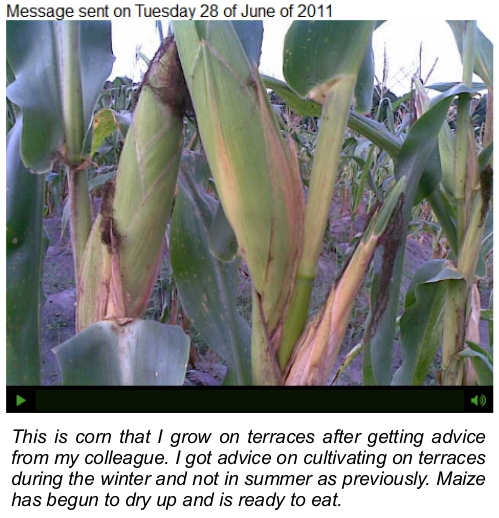
MG: What kind of behaviours began to emerge once the farmers took control of the smartphones supplied?
ET: It was quite interesting to see that the farmers started to use the phones for purposes which were different from those that we had originally proposed. This happened very soon after the project started. Only one month had passed, and the farmers had already started to go beyond merely documenting the effects of climate change. They interviewed other farmers, and asked them all sorts of questions about their crops and agricultural techniques, their opinions and views. In short, they slowly laid out a web of mutual learning. This was a real eye-opener for us. As we began to observe this, the environmental researchers in the team became worried that the farmers were deviating from the goals that we had set. I wanted to leave room for this deviation, as I was particularly interested in studying the process of technological appropriation. So I had to convince the researchers that we should leave enough room for the farmers to freely explore the potentials of the smartphones. It was not easy but, in the end, negotiating the tensions between a goal-oriented and an open-ended research turned out to be quite fruitful.
On one hand, the farmers found that they could shape the project to fit their interests which, as they said, were to “learn about what other farmers in remote areas were doing.” On the other, the researchers finally realized that the images and voice narrations posted by the farmers were an invaluable source of information about what was actually going on in the farms and within the communities. Sometimes, agricultural initiatives may be designed with an insufficient understanding of the social context in which they are applied. By allowing the farmers to publish a wide range of topics, Sauti ya wakulima became a “community memory” that reveals rich details about farming and the social life of rural communities in Bagamoyo.

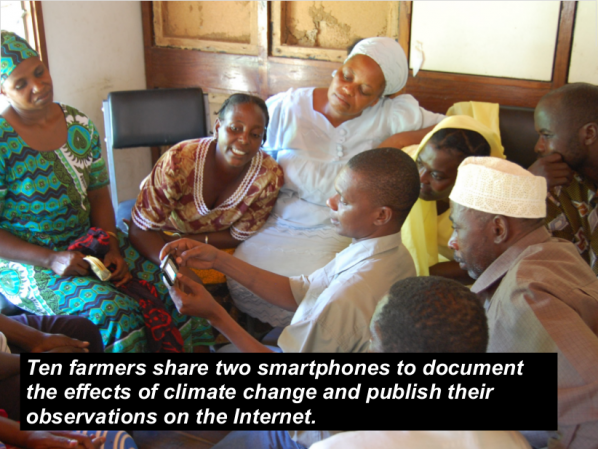
MG: In your presentation at Remediating the Social, I remember a quote from one of the farmers saying “The project helped me learn that phones can be used for other things besides calling people, and that computers can also be used to solve problems: they are not just a fancy thing for the rich people in towns.” What’s interesting here is, these words could be said any where. And that our consumer orientated culture could still learn a few things regarding uses of technology.
What lessons can the farmers teach ‘us’ in a culture where computers are part of the everyday life?
ET: I have interpreted this particular quote in two different ways. The first, most obvious one, is that the farmers discovered that the smartphones and the web can be useful tools, which may be shaped and adapted to meet their needs. For many of them, Sauti ya wakulima was their first chance at trying out these technologies. And, happily, the project showed us all that they can become an important ingredient in making farmers’ lives a little better.
However, my second interpretation is not as optimistic: in the quote, there is an explicit comparison between the (poor) farmers living in remote areas and “the rich people in towns.” Moreover, the fact that smartphones are explicitly considered as fancy devices points towards issues which need to be handled very carefully. In every part of the world, technological gadgets are quickly becoming symbols of social status. Currently, I am working in a rural zone in southern Mexico where cellphone coverage was nonexistent only two years ago. But as soon as the first antennas were installed, young people in those communities started buying smartphones, and now there is an open competition to see who has the fanciest one. A similar thing happens in Bagamoyo.
So, of course, smartphones can be useful tools, but they can also bring more consumerism into poor communities. This is very dangerous. I’d like to stress that, in our project, the smartphones are used as shared tools. This means that there is a limited number of devices available, and everyone must have a chance to use them at least once. I believe that this is a small but significant contribution towards diluting the extreme individualism and consumerism that are closely linked to these technologies.
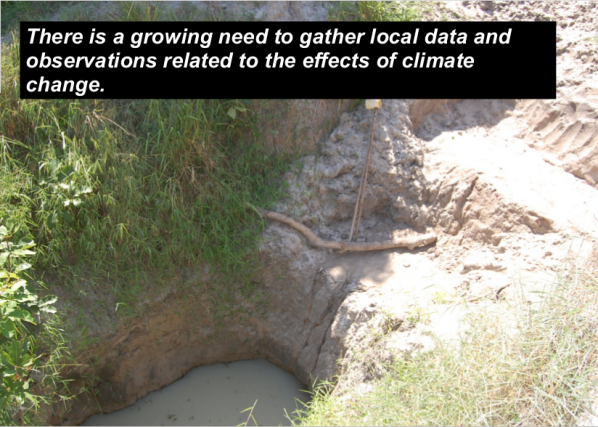
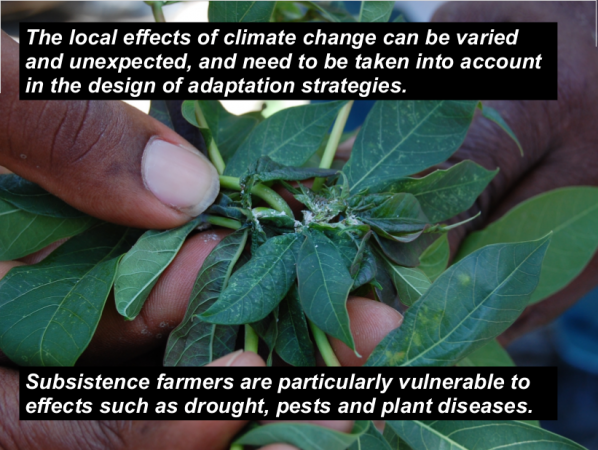
The farmers I have met in Bagamoyo have a very strong sense of community. Although their farms can be very far apart, sometimes with no roads between them, they still get together very often. They work together, learn together, have fun together. That’s the biggest lesson I’ve learned: we need each other’s presence. Quoting “Bifo” again, we are living in a time of precarization of the encounter of bodies in physical space. I agree with him that the most important poetic revolution has to be the re-activation of bodies. The farmers, with the great efforts they make to get together, and the great joy they find in doing so, have taught me a great deal: I need to get out of Facebook and step in to the “here and now”, together with others.
MG: What has this experience taught you. And how will it impact your future practice as an artist?
ET: I have partially replied to the first part of this question. But besides learning how to re-dimension the importance of computers in my life, I have also learnt a lot about agriculture. This is not a minor thing for me: after all these years of living in big cities, and realizing that I lack a basic connection to the earth, I believe I have found the best possible teachers. Of course, I’ve also learnt a lot about how to work with non-expert users of technology. This has made me better as a teacher. And, as you can imagine, many of the things we take for granted at home won’t necessarily work in Bagamoyo. So, doing projects in difficult environments has taught me to adapt, and to transform things that escape my control into opportunities. All of this changes me, not only as an artist but as a human being. My artistic practice is already quite different from what it was before Sauti ya wakulima. I have adopted a very critical position towards technology. Now, this is also a major shift: I started programming creatively when I was ten years old, and have been a media artist almost since then. But I feel I can’t go on with those artistic explorations, knowing what I know now. Consequently, last year I wrote and published a small note explaining why I stopped creating works of e-Literature, a field in which I was involved for more than ten years [5]. That was both a closure and a point of departure. Let’s see what the future brings.
Excerpt from ‘Why I have stopped creating e-Lit’ by Tisselli (November 25th, 2011)
Dear friends: this morning I went for a walk along the Naviglio Grande in Milan, and I entered a shop selling second-hand books. There I found a small book, “The Computer in Art”, by Jasia Reichardt, published in London in 1971. The book described the works of pioneers of Computer Art, such as Charles Csuri or Michael Noll, who were active at that time. A real gem. But the biggest surprise came when I turned to the last page, on which the previous owner had written: “I married on 23, November. I would like to be a man, not artist, not engineer, a man.”
I took the book with me.
Those involved in the Sauti ya wakulima / The voice of the farmers project.
The farmers: Abdallah Jumanne, Mwinyimvua Mohamedi, Fatuma Ngomero, Rehema Maganga, Haeshi Shabani, Renada Msaki, Hamisi Rajabu, Ali Isha Salum, Imani Mlooka, Sina
Rafael.
Group coordinator / extension officer: Mr. Hamza S. Suleyman
Scientific advisors: Dr. Angelika Hilbeck (ETHZ), Dr. Flora Ismail (UDSM)
Programming: Eugenio Tisselli, Lluís Gómez
Translation: Cecilia Leweri
Graphic design: Joana Moll, Eugenio Tisselli
Project by: Eugenio Tisselli, Angelika Hilbeck, Juanita Schläpfer-Miller
Sponsored by: The North-South Center, Swiss Federal Institute of Technology – Zürich
With the support of: The Department of Botany, University of Dar es Salaam (UDSM)
The activist initiatives of this art group from Vienna seem fascinating due to its art-tech philosophy, and it puts a smile on my face due to its pop attitude. In May 2011, Günther Friesinger, one of the creators of monochrom, gave a lecture to Media Art Histories students of the Donau Universität, which inspired me to arrange an interview with him. The first question I asked was about establishing monochrom. Günther explained that “monochrom came into being in 1993 as a fanzine for cyberculture, science, theory, cultural studies and the archaeology of pop culture in everyday life. Its collage format is reminiscent of both the early DIY fanzines of the punk and new wave underground and the art books of figures such as Dieter Roth, Martin Kippenberger and others. For a while now, monochrom has been venturing further than publishing alone and has been responsibly influencing people’s minds via film production, performances and festivals. If you are in Vienna in autumn by chance, look at the paraflows festival – one of the main projects run by monochrom.
Natascha Fuchs: How much has monochrom’s aims changed since 1993?
Günther Friesinger: We didn’t really develop a concept back then; monochrom has evolved. In the beginning, there was only the idea of publishing a fanzine – lots of other things resulted from that. At some point, we started doing performances. In the Internet’s primordial age, we developed a robot that could be controlled via the web, and so we began entering the art scene. Our first exhibition was in 1998 in the Secession, Vienna. Unfortunately, they didn’t have Internet access back then, so our little robot stood in a corner, immobile. The people visiting the exhibition back then still considered it interesting enough to some extent, but many things back then didn’t work the way we’d have liked them to work.
NF: Art, technology and philosophy – are they equal for monochrom? What is the starting point for monochrom’s particular initiatives?
GF: We are a political group that gives statements through different means, those of art in all its varieties. I think it is important for us to find a fitting medium for the right story. This is something that specifically characterises us as a group. There are many different actions implicated by that, such as writing plays, making a movie, producing a music CD or writing a book. Normally, people try to achieve excellence in one medium. With us, it’s the other way round. That’s why we’re active in so many different areas.
NF: Which historical background concerning the relationship of philosophy, art and technology is especially meaningful for you?
GF: A difficult question. I think that Guy Debord and the Situationists are those one could consider most fitting. Certainly also some parts of Fluxus are of relevance.
NF: To which media theoreticians do you refer in your practice?
GF: I think that as a theorist, artist and curator in media art, net art, digital art and culture, it is important to confront oneself with theorists like Kittler, Luhmann, Flusser, McLuhan, Rheingold and many more. However, it is not the case that we refer to one theorist or another in all our works. I think that this system of self-affirmation through referral is quite interesting – but I think that for myself, monochrom and for our audience, there is a value added by self-generated theories for our projects and the discourses they cause.
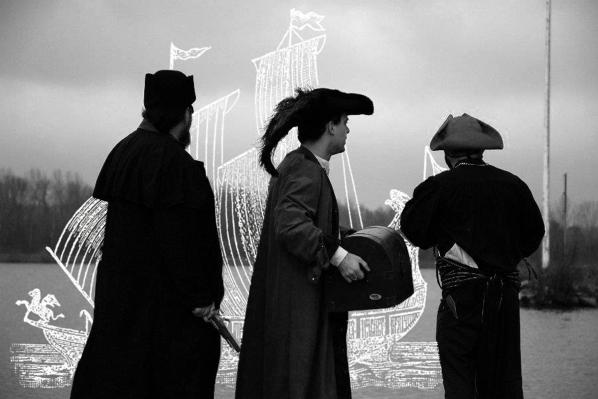
NF: What are international projects of monochrom? And what is the difference between monochrom audiences in Vienna and abroad?
GF: There are too many of those to be listed here. Since our big USA tour of 2005 we produce most of our projects bilingually in German and English, or only in English, in order to be able to have an international impact. Of course, many members of monchrom live and work in Vienna, and we also produce projects in Vienna, but our main focus is on our international presence. One of the big international projects, running since 2007 in San Francisco, is the Arse Elektronika: a conference on pornography, sci-fi, games and the development of technology. I would say that with the San Franciscans we’ve found the ideal community for such a conference.
NF: You call yourself “edu-hacker”. Why that and how is it connected with your studying and teaching experience?
GF: I have always loved reading, learning and continuing to further myself intellectually. I really enjoyed my studies and I enjoy sharing my knowledge and skills with my students. Universities are, in my book, places where it is possible to acquire knowledge, to reflect upon it, places of discussion and freedom. Because of the process of universities becoming more like schools, among other things caused by the Bologna Accords, those in my opinion are important areas that enable students to become self-reliant, critical people are struck from the curriculum. I’m trying to counteract this in my classes, trying to cause rifts in the school-like system, by using other methods of transmitting knowledge, using a great deal of humorous elements, and by always meeting the students eye to eye as equals.
NF: What is philosophical society in contemporary Austria now?
GF: Alive and kicking as always, I’d say 😉 One of the exciting things is that exactly now there are a lot of young, fascinating philosophers out there. The topics that I mostly concern myself with are, however, copyright, intellectual property, culture, art, media and technology.
NF: Is paraflows one of your biggest current projects? What’s the concept of this festival? Is it independent from monochrom activities?
GF: paraflows is surely one of the biggest projects that I am working on at the moment, apart from monochrom. monochrom helped to start and grow the festival in the first two years, as monochrom has done with many other projects worldwide. „paraflows – festival for digital art and culture“ has been established in the last seven years as a new annual festival situated between the Ars Elektronika and the Steirischer Herbst. It serves as both a platform for the young, local scene of digital art and culture and as an interface to international and renowned media art.
NF: How is monochrom activity is financed?
GF: We do get occasional subsidies for some projects, we get money from performances, the sale of our publications and sometimes the sale of a work of art, and recently we have also acquired crowdfunding. I’d say, however, that around 80% of the projects we do are not financed in any way and are purely done because we have fun doing them.
NF: Do your own curatorial projects serve in some way as a research method for you?
GF: I take the liberty that I only curate projects that I am very interested in myself. That is to say, projects where I have a very strong urge to explore the topic, to read, write and of course also to do research. That is probably the reason why I try to achieve a publication for each project that I curate, in order to give those who are interested in it some sort of preliminary report, a possibility to expand upon.
NF: Is activism capable to envision the future or does it just reflect, react on what is and has happened?
GF: It is getting increasingly difficult to be subversive. monochrom is fundamentally critical of the bourgeois world view. We examine it from a distance, dissociating ourselves from it. The question is: How do we get out? Our current late-capitalist aims for transgressions. That is to say that capitalism requires transgressions as a principle. Viennese Actionism, the most relevant cultural statement in Austria for the last hundred years, was doomed to fail at a certain point, because in the 60ies Austria still had a society based on discipline. One of the central strong points of monochrom: Finding the right story for the right medium could be a opportunity to deal with this situaltion.

NF: Which publications about monochrom you would recommend to read?
monochrom’s ISS. In space no one can hear you complain about your job. (2012)
monochrom’s Zeigerpointer. The wonderful world of absence (2011)
Urban Hacking. Cultural Jamming Strategies in the Risky Spaces of Modernity (2011)
monochrom #26-34: Ye Olde Self-Referentiality (2010)
Do Androids Sleep with Electric Sheep? (2009)
Pr0nnovation?: Pornography and Technological Innovation (2008)
monochrom: www.monochrom.at
paraflows festival: www.paraflows.at
(c) Natascha Fuchs is an independent expert in cultural projects management and international public relations, graduate of the University of Manchester (Cultural Management) in 2008. She has been living in Vienna, Austria, studying History of Media Arts at the Donau-Universität and collaborating with sound:frame Festival for audio:visual expressions, since her move from Moscow, Russia in 2011. In Russia she was related to MediaArtLab and Media Forum — the special program of the Moscow International Film festival dedicated to media arts, experimental films and digital context with more than 10 years history. As a researcher and practitioner, she works in a variety of topics and participates in different international projects focused on media arts, cinema and sound. Columnist and writer for several online magazines.
In September 2012, Italian tactical media artist Salvatore Iaconesi got the diagnosis. He had a glioma (glial cell brain cancer) of approximately 2×3 cm on the surface of his right hemisphere. Upon asking to see all the data relating to his condition, he found that all of the documents, MRI scans, and so on were in obscure not readily used formats. This meant that if one wanted to view the data, you needed specific or corporate software.
What he did then was remarkable. Iaconesi then hacked the formats of the documents and converted them into open-source ones that anyone could read could read with FLOSS (Free Libre Open Source) software. He then created the site, La Cura, where he presented his records as an “open source cure”. People around the world could access his records and then add their recommendations and findings about his condition, cancer, and so on. I begin this interview with Salvatore on September 15, 2012, and the La Cura website already has a rapidly expanding database of information at http://www.artisopensource.net/cure/.
Patrick Lichty: Salvatore, thank you for having this conversation. I remember that it was only a year and a half ago when we were shop-giving copies of the REFF tactical media book from your project, Fake Press in Rome. So, it was a shock when I learned of the glioma the day you launched the site. Could you talk a little about what is on the La Cura site?
Salvatore Iaconesi: Hi Patrick! Yes I do remember, too. And that is also a great explanation on what can be found at La Cura site: it is like one of our “fakes”, except that it is not a fake.
La Cura is about an alternative reality which I want to materialize on this planet, now. In this alternative reality, when someone has a serious disease, life does not end. One can be social, creative, and friendly. Work, art, design, fun and entertainment are possible for diseased people in this alternative reality, just as it is possible to reach out to find cures in any philosophy, time, strategy, culture or way one wishes. And consider that even technologies in this alternative reality are designed to enable and facilitate all this, actively promoting the freedom and autonomy of people.But, sadly, life is not like this alternative reality.
I wanted it to be my alternative reality, so I just did everything it took to bring that reality into the world. It’s like when you make an Augmented Reality application: you do a series of things to “materialize” some other things into ordinary reality. And then you have them, right there. So, La Cura is my personal Augmented Reality, in which, if I want to, I have all the tools and information I need to find a “cure” for my disease in one of multiple ways and strategies, which are medical, cultural, technological, emotional, artistic, political etc.
To achieve this, I have had to go through a series of obstacles:
The first is connected to language and information, as the first thing you notice at the hospital is that they are not really talking to you. Medical language is difficult and complex, and they rarely take action to make things more understandable to you. One of the testimonies I received in La Cura was that of a lady who has found herself in front of a doctor shouting at her: “You really think that I will explain to you why your thyroid has to be removed? It has to be removed! That’s it!”
This is really not “open”, in any sense. And, in more than one way, it is an explicit evidence of the approach which medicine has towards patients: they cease to be “humans” and become sets of parameters on a medical record subject to certain protocols and standards. When you are in the hospital, it’s often as if you’re not there. The only thing that matters is your data: blood pressure, heartbeat, magnetic resonance etc.
And the way in which information reflects this if handled in this context. Data formats may be, technically “open”, meaning that they are described somewhere but they’re really an explicit reflection that when you’re sick you “step out of society”. That data is usable and accessible only to “professionals” and to those people who have tools and skills to handle them.

I, as someone with considerable expertise with computers, have had some difficulties in opening them. Imagine someone else with less skill! Most people would not have been able to benefit from all the types of “cure” which I am currently accessing from a variety of sources and modalities. They would not have access to a “cure” that doesn’t end at a list of medicines and dosages, but spreads out into society.
To do that, I have had to hack into the information and convert it into really “open” data, using multiple formats that could be used by many kinds of people to do multiple things. In the format that the data was originally in, even if it was “technically open”, that data would have been seen only by “professional doctors” and, instead of being a “human being”, I would only have been a “patient”, or worse yet, a “case”.
PL: What do you want people to do with the information?
SI: Whatever they wish! Obviously! What is important in this case is that we must agree on what the “information” is… What I am publishing is my autonomous will to disclose my state of disease, including all data and medical information. I have my own purposes for this, but it does not necessarily mean that this purpose must/should be shared by others.
My personal purpose for this disclosure is to autonomously shape my own human condition. I have a disease but I am not a “diseased person”. I am a person. And, as such, I wish to create my personal “cure”, which has to do with my life, not with my disease. For what people know, I might even consider cancer as not being a “disease” at all! I might, for example, consider it an expression of the “cure”, such as if I adhered to Hamer’s theories. Which I don’t, or, at least, not in the sense that “I believe” in Hamer’s theories; I take them into consideration, but I don’t believe in them, just as I don’t believe in chemotherapy, in Aloe Vera, in Caisse Formula, in surgery, in shamanism, in healers, oncology or in any of these things. I take all of them into serious consideration, just as I seriously consider certain philosophies that say that we are made of energy, energy creates matter, and cancer is “matter” and so on. Therefore, cancer must be created by energy in some form. And so it could possibly be that I created cancer myself in a way or another.

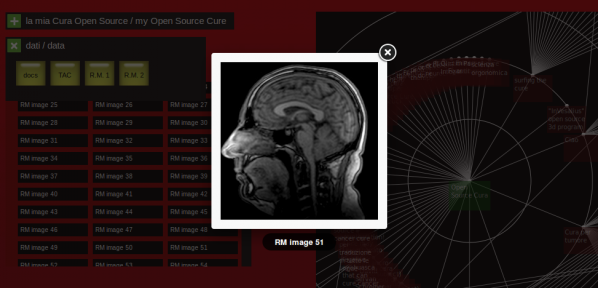
So in this sense, I think it is very important to be able to easily look at the images of my cancer and to say “hello” to them. It is important to turn them upside down, to edit them with GIMP, to make mosaics out of them, to speak to them, asking “hello?” What are you doing in there? Did I do something to cause you? Can I change something to make you/myself feel better?”
Both scientific and traditional evidence shows that art, positive emotions, laughter, reduced stress, and a good social life have great practical benefits to the human body, I want to seriously consider that part of my cure could be formed by receiving an image of my brain with a smiley face drawn across it over the tumor, or a picture of a friend of mine, or a video of a projection mapping done with Processing in which the images of my cancer cover a whole facade of a building.
And since I don’t want to believe, but I want to take all of these things into serious consideration, I cannot focus only on the “medical” approach (and the related information, and its formats). I need to access all of my information in multiple ways, and I wish that everyone could do the same (as, from my point of view, it’s part of my Cure). And, even if “technically open”, the format in which my medical records have been disclosed is not enough, because it is “open for professionals” and so the only thing I could do with it would be “show it to professionals”, missing out on all the other wonderful parts of the “cure” which are available in the world.
This for me, is an interesting starting point to think about what things such as “OpenData” could mean. This is far beyond the idea that some government can some data according to ways in which some “professionals” could grab it and, do something like make a visualization or an App out of them. Who knows? In this sense, instead, we would not be talking about “technology”, we would be talking about “humanity”.
In the end, this is exactly what I’d like people to do with the “information”. I want the world to take the fact that I decided to disclose the fact that I have a disease and that I want to actively search for a cure for from all of these perspectives. In the meantime, I want to reconsider what it means to be “diseased” in current times and what new conceptions of the word “cure”, “medicine” associated with my condition could mean.

PL: What has happened since you launched the La Cura site?
SI: Lots of things. People are contributing and participating in multiple ways. There are testimonies, art, poetry, suggestions, videos, performances. Many doctors have called in to propose their methodologies and technologies. I have had very interesting and profound discussions with people who are prepared to deal with very complex things every day of their lives. I’ve communicated with doctors who are perfectly open to the possibility of such a paradigm change for the word “cure”. Artists, designers, activists, are giving me wonderful parts of “cure”. Many “patients”, “ex-patients”, “relatives” and “friends” of “diseased people” are sharing their experiences, are opening discussions, are sharing the information I found on possible medical cures. And so many people want to talk to someone in new and different ways, becoming again, simply, humans. Journalists from all kinds of media have started to ask for interviews, texts and videos. We stopped that after a while, as we don’t wish to turn this into merely a “spectacle”. We only keep on working on this with journalists which we know we can trust and which we know will not transform what we say to produce their news.
PL: For your information, I had an MRI in 2009 here in the States, due to my doctors’ concerns of something similar (nothing was found), but when I asked for the data, I got a CD full of JPEG images. Were you surprised when you found out your records were in particular formats?
SI: They were not really in a proprietary format. Let’s call them “exotic formats for professionals”. And yes, I would have expected something which I could have shared easily (such as your JPEG images, and maybe some meta-data in some easy to use format such as XML, or even a spreadsheet). But this was a sort of paradox: an “open” format which is really hard to open and to use for something else other than putting the CD in an envelope and (snail)mailing to the next doctor.
PL: What do you think the line is between privacy and data oppression? Would that be when the patient is denied access to their rights to access the information and distribute it as they wish?
SI: We should all know this by now. Privacy is not a problem unless the “system” is made by lousy people. We have tools to protect ourselves and to promote ourselves, and these tools are dangerous only when who runs them is a lousy person. Privacy protection arises through education (understanding what is privacy and when/where/how/why would I want to protect it) and through the acquisition of decent ethics from the people and organizations which run the entire infrastructure through which all our digital data goes through. And obviously, and most importantly, our ethics is created by helping each other out in a P2P way, teaching each other what we know, what we discover and how we decided to handle it when we found out.
There is no single line between privacy and data oppression. Not one which everyone would agree on. We have the tools for each one of us to tune this line to our own wishes, according to what we want to do, what are our desires, what are our objectives etc. We “just” need more places (physical, digital, virtual, institutional, occasional…) in which to discuss and share our points of view, as every time this happens, many things are learned on all sides.
PL: Do you consider your site a form of radical tactical media intervention?
SI: I can now say “I have a radical tactical media intervention in my head”. Cancer is the new Black. The Cancer is the Message. And we could go on. I don’t know. I guess I could call it that. I also guess I could call it a performance. I guess I could call it life. I guess I could call it hacking or whatever. I will just call it La Cura.
PL: What has been the most inspirational information, art, or otherwise that has resulted from the launching of the La Cura site?
SI: The most enlightening thing that happened is the experience of talking about the same exact thing using dozens of different languages. I have spoken with neurosurgeons, shamans, nutritionists, pranotherapists, doctors, activists, macrobiotics, hippies, cyberpunks, punks, friends, relatives. Most of the time, I received incredibly good advice. When you look at that advice from different points of view, you start to understand that you are really talking about the same thing, but in different languages.
For example, two of the most important things which you deal with when you talk about cancer are the idea of creating alkaline environments in your body (because cancer cells cannot stand them) and the facts that anti-oxidants are a great tool in support of any type of therapy (because of the molecular reactions which are at the base of cancer).
Well, speaking of just these two, it occurred to me that multiple theories deal exactly with these two concepts. I have had an esoteric master describe my cancer as an invisible living being, and he suggested to drive it away using sulfur and Rosa Rubiginosa oil, in ways which turn them into two incredible anti-oxidants and creators of alkaline environments as well as powerful stimulants of the immune system. I have also spoken with nutritionists and macrobiotics communities and learned about their instructions on choosing food, cooking and eating, many of which are directed exactly to that: anti-oxidants and creating alkaline environments, but through food.
And when an oncologist explained us his therapy, that’s exactly what it was about: powerful anti-oxidants and alkaline environments. And on, and on and on. Aloe Vera, Caisse formula, fungus theory, chemiotherapy, Di Bella method, potassium ascorbate, ketogenic diets, etc: all highlight cancer cells in some way; create an environment around them which is as alkaline as possible; anti-oxidate them; activate the immune system as powerfully as possible so that the highlighted weakened, cancer cells can be more easily “convinced” at mutating back to a decent form or to commit suicide with the help of the immune system. Realizing this is an enlightening experience: it spans across thousands of years and also helps you make some choices (things stand out when they speak about different things!).
Everything else that is going on in La Cura is wonderful, but having realized this fact is just incredible and fascinating. You start imagining about all the other things we discuss about in our daily lives using multiple languages (energy, politics, emotions…) and start to wonder what would happen if you turned on this shared, P2P modality in those cases as well.
PL: How do you hope that others will benefit from the conversation that you are starting through La Cura?
SI: I don’t “hope” anything. I did this because I felt I needed to. When one talks about “revolution” dialogues start arriving at the point when one says, “Let’s burn everything down!” “Let’s destroy everything!” and so on.
We know we can’t do it. We can’t “destroy everything”. It’s not possible. What we can do is to create a reality as if everything already happened – as if the “revolution” already happened, as if the world had been burned down already, and rebuilt, just the way you like it. We can live life like this. It is a bit more than “seeing things”. But you do Augmented Reality, Patrick. You know what I mean. It’s a bit more than “writing”, it’s about creating worlds.
PL: As of this interview, what is the prognosis of your condition?
SI: Depends on what perspective you look at it from. From the medical point of view I have a low-grade glioma at intensity which is still undecided, between 1 and 2 (we will have to wait an histologic exam to know for sure). From the human point of view: I am fine! I have no apparent symptoms. I just need to be careful because if I find myself in stressful situations I could react by having an epileptic shock. So it is not advised that I drive or things like that. It’s the perfect excuse! 🙂
PL: Don’t you think it’s funny that the abbreviation for your name is “si”?
SI: Sì! Obviously 🙂
“Tweets in Space beams Twitter discussions from participants worldwide towards GJ667Cc – an exoplanet 22 light years away that might support extraterrestrial life. By engaging the millions of voices in the Twitterverse and dispatching them into the larger Universe, Tweets in Space activates a potent conversation about communication and life that traverses beyond our borders or understanding.”
Marc Garrett: Could you explain to our readers what ‘Tweets In Space’ is?
Scott Kildall and Nathaniel Stern: Tweets in Space is an art project — a networked performance event — which beams your Twitter messages to a nearby exoplanet that might support human-like, biological life. Anyone with an Internet connection can Tweet with the hashtag #tweetsinspace during the performance time, and their messages will be included in our shotgun blast to the stars. The performance is on September 21st, 20:30 – 21:00 Mountain Time (3:30 AM BST / London time).
MG: What was the motivation behind your current collaboration?
SK and NS: We found inspiration from various sources. First, in NASA’s Kepler mission, whose purpose is to discover planets in the “habitable” or “Goldilocks” zone. The project has found over 2000 exoplanets thus far, all of which are “not too hot, not too cold, but just right” for life as we know it. Scientists now estimate that there are at least 500 million planets like this in the Milky Way alone. Our conclusion: extraterrestrial life is almost certainly out there.
![The newly discovered planet is depicted in this artist's conception, showing the host star as part of a triple-star system. Image credit: Carnegie Institution / UCSC. [1]](http://www.furtherfield.org/wp-content/uploads/2012/09/planet_gj667cc.jpg)
“The latest discovery is at least 4.5 times bigger in size than Earth. Reportedly, the planet exists 22 lightyears away from Earth and it orbits its star every 28 days. The planet is known to lie, in what is being referred to as the star’s habitable zone. A habitable zone is a place where the existing conditions are just perfect for life sustenance. Astronomers, according to this report also suspect that the GJ667Cc may have been made out of earth-like rock, instead of gas.” [ibid]
Another source of great inspiration is how we use social media here on Earth. This is our second, large-scale, Internet-initiated collaboration. In 2009, we amplified the power structures and personalities on Wikipedia, and questioned how knowledge is formed on the world’s most-often used encyclopedia – and thus the web and world at large. Now, we are turning to the zeitgeist of information and ideas, feelings and facts, news and tidbits, on Twitter. The project focuses on and magnifies the supposed shallowness of 140-character messages, alongside the potential depth of all of them – what we say in online conversation, as a people.
We are directing our gaze, or rather tweets, via a high-powered radio telescope, towards GJ667Cc – one of the top candidates for alien life. It is part of a triple-star system, has a mass that is about 4 times that of Earth, and orbits a dwarf star at close range. GJ667Cc most certainly has liquid water, an essential component for the kind of life found on our own planet.
MG: Right from its early years when Jagadish Chandra Bose [2], pioneered the investigation of radio and microwave optics – science, technology and art have had strong crossovers. And it might be worth mentioning here that Bose was not only well versed as a physicist, biologist, botanist and archaeologist, he was also an early writer of science fiction. [3] Which, brings us back to ‘Tweets In Space’, wherein lies themes relating to science fiction, radio broadcasting (commercial, independent and pirate), wireless technology of the everyday via our computers, and ‘of course’ the Internet.
![J.C. Bose at the Royal Institution, London, 1897.[3]](http://www.furtherfield.org/wp-content/uploads/2012/09/JC-Bose-at-the-Royal-Institution-London-with-his-radio-equipment-The-date-is-1897.png)
But, what I want to pin down here is, where do you feel you fit in historically and artistically with other past and contemporary artists, whose creative art works also involved explorations through electromagnetic waves?
Scot Kildall: The work of JC Bose is incredible and what strikes me is that he eschewed the single-inventor capitalist lifestyle in favor of his own experiments. Isn’t this the narrative that artists (often) take and linked back in many ways to the open-source/sharing movement, rather than the litigious patent-based corporation? And it mirrors in many ways the reception of electromagnetic radiation as well. You can’t really “own” the airwaves. Anyone who is listening can pick up the signal. This comes back, as you point out, to the internet. Twitter is now, one of the vehicles, and, ironically entirely owned by a benevolent* corporation.
Nathaniel Stern: (Agreeing with Scott) and we can’t forget of course Nam June Paik, who played with naturally occurring and non-signal based electromagnetic fields to interfere with analogical signals (as well as the actual hardware) of tube televisions, and more. And of course, there have been other transmission artists, explored in depth by free103point9, among others. I think, like them and others, we are messing with the media, amplifying (figuratively and metaphorically) and intervening, pushing the boundaries of DIY and cultural ethico-aesthetic questions…
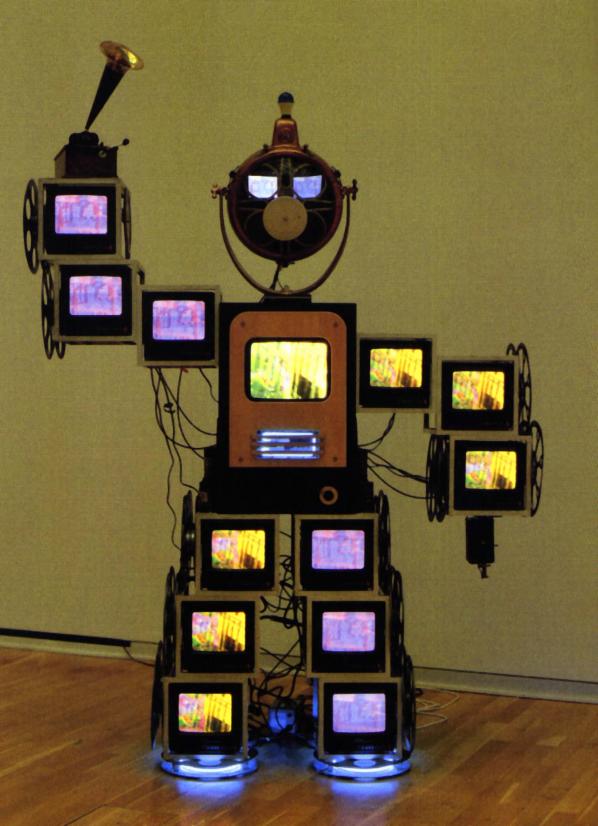
MG: What is especially interesting is that all the tweets submitted by the public are unfiltered. How important is it to you that people’s own messages are not censored when going into space?
SK and NS: Absolutely. Tweets in Space is by no means the first project to transmit cosmic messages with METI technologies (Messaging to Extraterrestrial Intelligence). Our fellow earthlings have sent songs by the Beatles, photos of ourselves shopping at supermarkets, images of national flags, and even a gold record inscribed with human forms – controversially, where the man has genitals and the woman doesn’t. These slices of hand-picked content exhibit what a select few believe to be important, but ignore, or willfully exclude, our varied and collective modes of thinking and being.
Tweets in Space is “one small step” with alien communications, in that it is open to anyone with an Internet connection. It thus represents millions of voices rather than a self-selected few. More than that, our project is a dialog. There have been, very recently, a small number of projects that similarly “democratize the universe” but none are like ours: uncurated, unmediated thoughts and responses from a cooperative public. We can speak, rebut, and conclude, and nothing is left out. Our transmission will contain the good, the bad, and the provocative, the proclamations, the responses, and the commentary, together, a “giant leap” for all of humankind – as well as our soon-to-be friends.
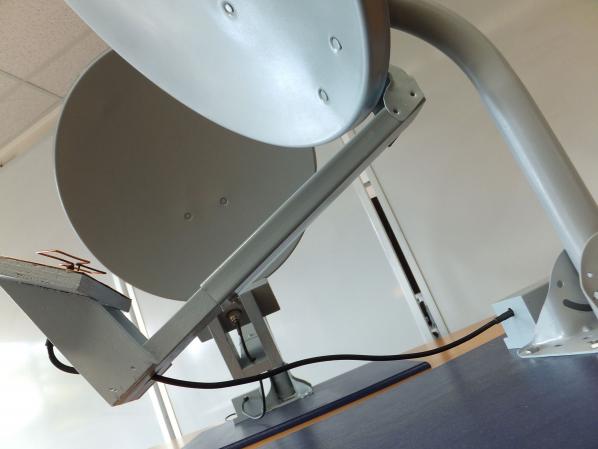
Furthermore, by limiting the event to a small window of only 30 minutes, we are encouraging all our participants to speak then respond, conversing with one another in real-time, through networked space. We are not just sending lone tweets, but beaming a part of the entire dialogical Twitterverse, as it creates and amplifies meaning. Tweets in Space is more than a “public performance” – it “performs a public.”
MG: Now, you will be transmitting real-time tweets toward the exoplanet GJ667Cc, which is 22 light-years away. How long will it all take to get there?
SK and NS: Well, first off, we’re collecting all of the tweets in real time, but only sending them out later in October. The main reason for this is that we have to wait for the planets to align – literally. We want line of sight with GJ667Cc from where our dish is. The added bonus of time, however, is that this will allow us to really flesh out how we send the messages in a bundle. We want to include a kind of Rosetta Stone, where we will not only send binary ASCII codes of text in our signal, but also analog images of the text itself. We additionally intend to choose the most frequently used nouns in all the tweets from our database, then give a kind of “key” for each. If “dog” is common, for example, we can transmit: 1. an analog image of a dog, like a composite signal from a VCR; 2. a text image of the word “dog” in the same format; and 3. the binary ASCII code for the word dog.
In terms of time/distance, when speaking in light years, these are the same thing. A light year is the distance light can travel in one year of Earth time (about 9.4605284 × 10 to the 15 meters). Since radio travels at the speed of light, a big dish on GJ667Cc will pick up the signal in 22 years. We should start listening for a response in 44 – though it may take them a while to get back to us…
MG: Will the code used for the project be open source, and if so, when and where can people expect to use it?
SK and NS: Yes it is! The most useful part of our code is the #collector, which saves real-time tweets to a database, that can then be used for live projections or web sites, or accessed and sorted later via all kinds of info. The problem is that it’s not really user friendly or out of the box – folks need a suped up server (VPN), and to plug into a few other open source wares. The main portion of the backend we used is actually already available at 140dev.com, and then we plugged that into Drupal, among other things. For now, we’re telling interested parties to contact our coder, Chris Butzen, if they want to use our implementation. And we hope to do public distribution on tweetsinspace.org if we are able to package it in a more usable format in the next 6 months.
MG: Are there any messages collected so far, grabbing your attention?
We’ve had thousands of tweets so far – even while just testing the ware in preparation for the performance. We’re anticipating a lot of participation! The tweets we’ve seen have ranged from variations on “hello [other] world” and “don’t eat us,” to political activism and negative commentary, to a whole surreal narrative of about 30 tweets per day over the last 3 months.
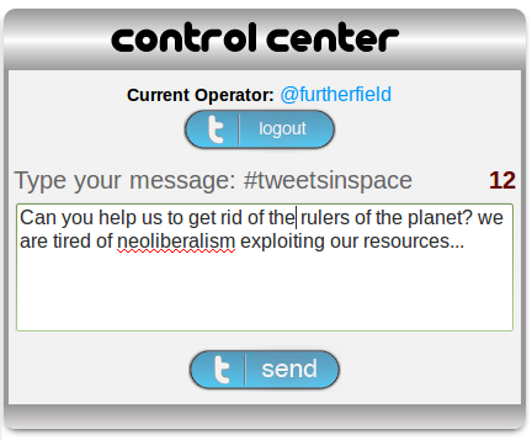
go to tweet aliens to add your own words…
Some of our favorite tweets have been those that question how to make our own world better. These speak to both the hope of space age-ike technology, as well as the hope in collective dialog – both of which our project tries to amplify. Such tweeters ask about the alien planet’s renewable energy sources, tax structures, education, art, and more.
We imagine the 30-minute performance will see a much more potent discussion about such things, and hope your readers will participate. The final transmission will be archived permanently on our site once we’ve prepared it for launch.
As part of the International Symposium on Electronic Art in New Mexico (ISEA2012). We will collect your tweets and transmit them into deep space via a high-powered radio messaging system. Our soon-to-be alien friends might receive unmediated thoughts and responses about politics, philosophy, pop culture, dinner, dancing cats and everything in between. By engaging the millions of voices in the Twitterverse and dispatching them into the larger Universe, Tweets in Space activates a potent conversation about communication and life that traverses beyond our borders or understanding. http://tweetsinspace.org/
AND THEY WILL BE SENT INTO DEEP SPACE!!!
Watch the stream LIVE here – http://tweetaliens.org/tweets/tweets.php
Charlie Gere is a Media Theory and History professor in the Lancaster Institute for Contemporary Arts, Lancaster University. Co-curator of FutureEverybody, the 2012 FutureEverything exhibition in Manchester. In 2007 he co-curated Feedback, a major exhibition on art responsive to instructions, input, or its environment, in Gijon, Northern Spain. He has given talks at many major arts institutions, including the Centre de Cultura Contemporània de Barcelona, the Architectural League in New York, Tate Britain, and Tate Modern. Gere’s new book, Community without Community in Digital Culture (Palgrave MacMillan, 2012), is out now.
Previous titles include: Digital Culture (Reaktion Books, 2002), Art, Time and Technology (Berg, 2006), Non-relational Aesthetics, with Michael Corris (Artwords, 2009). Gere was co-editor of White Heat Cold Logic (MIT Press, 2009), and Art Practice in a Digital Culture (Ashgate, 2010), as well as writing many papers on questions of technology, media and art. He is also co-editing with Robin Boast an anthology entitled Allegories of the Information Age (forthcoming).
Marc Garrett: Digital Culture was originally published in 2002, which happens to be the version I’ve had all these years. In 2008 it was republished, revised and expanded. Now the book has an extra chapter ‘Digital Culture in the Twenty-first Century’. Of course, we already know that digital technology and society has changed dramatically since 2002. So, what themes and historical contexts did you choose, as necessary to include in this new and last chapter?
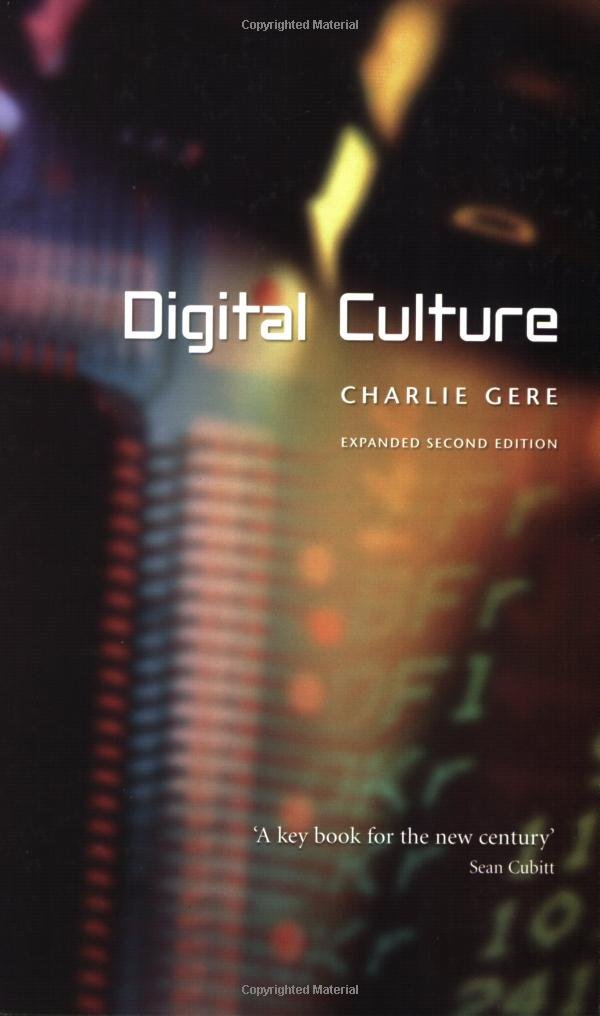
Charlie Gere: What happened after the first edition’s publication was of course, the rise of so-called Web 2:0, which was simply the greater exploitation of the reciprocal possibilities of the Web. I tried to reflect on how this reciprocity was visible beyond the Web itself and was becoming part of a more general culture of engagement and exchange, not that I share some of the more utopian visions of this phenomenon. Indeed, in my new book Community without Community in Digital Culture, I try to counter the, for me, more naive visions of community in relation to digital technology. I advocate a more ‘non-relational’ approach that does not deny the transformative effects of new media in terms of community but thinks of it more in terms of hospitality to the other.
MG: Many of the artists we have worked with are using new media to explore and critique the utopian assumptions you discuss: YOHA, IOCOSE, Liz Sterry, M.I.G (Men In Grey, Julian Oliver and Danja Vasiliev), Heath Bunting, Face to facebook (Paolo Cirio and Alessandro Ludovico), Annie Abrahams and more. Each of them work in a deeply relational way to intervene in the mythologies projected about digital technology; and, with a knowingly crtical eye of the technical limitations and the social controls at work when using networked technology. At different levels, all are producing work that ‘consciously’ incoporate relational contexts, in some way or another, this includes ideas and approaches with autonomy as part of their art, but not necessarily advocating technology as a singular, saving grace.
How do you view the role of this practice in the context of the wider corporate and state impact on the way technical cultures are evolving. How do you see the notion of hospitality working between the arts and these other more mainstream cultures?
CG: I greatly admire and like the work of the artists you mention and others doing similar things. For me they exemplify the complexity of the idea of hospitality. In general the Web is about exchange, whether that of money for goods, social links and relational exchanges in social networks, or the exchange of speech and dialogue in on-line fora. The work of these artists refuses this demand for exchange and profit within a restricted economy. Thus they are in a sense parasitical on the Web. The word ‘parasite’ comes from ‘para sitos’, meaning ‘beside the grain’, and refers to those animals that take advantage of grain stores to feed. They are the creatures to who must be offered hospitality, as a gift, without expectation of return, which means that while they are bound up with the technological systems that comprise the Web, they are not part of the restricted economy of exchange, profit, and return that is at the heart of capitalism, and to which everything else ends up being subordinated and subsumed. Thus they find an enclave away from total subsumption not outside of the market, but at its technical core.
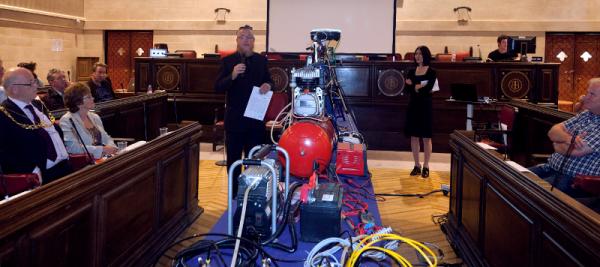

MG: Many are aware that technology and digital culture have changed the world we live in and appreciate their immediate effects on our everyday behaviours and situations. But there is a bigger story to tell, and history can offer us insightful glimpses, important clues and ways into this story about our relationship with technology and digital culture. One of the arguments outlined in your book ‘Digital Culture’ is that digital culture is neither radical, new nor technologically driven. With this in mind, which past developments do we need to acknowledge and be reminded of and why?
CG: For me the emergence of digital technology is part of a much longer story of abstraction, codification, quantification and mathematisation that can be traced back to numerous points in the history of the West, from Ancient Greece, to early Modernity to the rise of industrial capitalism. Here one might think of Heidegger’s use of ‘cybernetics’, a word we normally associate with post-war computing culture, to describe the technology and calculative enframing of modern society which he traces back to the Ancient Greeks and especially to Plato. I am not a particular advocate of digital technology, and while I appreciate its uses, I also think we must try to be aware of how it determines the way in which we think, and in which we conceive of the world. Above all we should not regard it as merely a conduit to an uncomplicated world simply out there, but rather the means by which a particular world comes to be for us. That said, this is very hard, given that in my view, and to adapt a well-known phrase from Derrida, il n’y a pas de hors-media, there’s no Archimedean point outside of our medial condition, from which we can understand it as from a god’s eye view. ‘Media determine our situation’ as Friedrich Kittler put it.
MG: In Digital Culture, you write about the composer John Cage and how he “has had the most profound influence on our digital culture”, and how his influence has opened up various different avenues of creative engagement. And, many of his ideas on interactivity and multi-media not only “have repercussions in the art world”, but also a strong influence on how computers are used as a medium. Which art movements in particular did he influence and what kind of legacy did he leave for others in relation to computers?
CG: Actually Cage’s influence on those using computers in the arts is probably less to do with what he himself did with such technology and more to do with his use of aleatory methods in many his different projects across many artforms. Also there is something about Cage’s own refusal of a normative Western subjectivity that is also consonant with aspects of our hyper-technologised existence with its emphasis on decentering the individual. Both the refusal of such subjectivity and the aleatory work together to produce a new model of the artist as conduit of contingent social forces rather than protean demi-urge or genius.
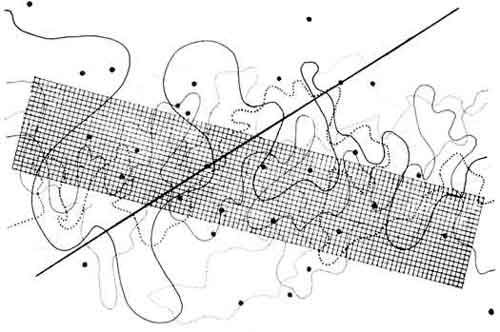
MG: Your new book ‘Community without Community in Digital Culture’, has come out at the same time as Geert Lovink’s ‘Networks Without A Cause: A critique of Social Media’. Lovink asks “How do we overcome this paradoxical era of hyped-up individualization that results precisely in the algorithmic outsourcing of the self? How do we determine significance outside of the celebrity paradigm and instead use intelligence to identify what’s at stake?” [1]
Where are your thoughts in regard to Lovink’s question, and does it relate to what you propose in terms of “hospitality to the other?”
CG: I haven’t read Geert’s book, yet at least… But I am highly sympathetic to what I take to be his position. My view is that the Web is part of a broader set of developments that apparently concern relationally, but actually emphasize the sovereign individual and autonomous subject of modernity, as well as promoting spectacular and image-bound forms of presentation and relation. The problem is that one alternative to this individualization is a kind of fascistic identification with the mass, in the form of fusion that negates the individual. A solution maybe to engage with the idea of the other in terms of difference, as both relational and separate, and yet also that which we depend on for our identity in a process of differentiation; thus the idea of hospitality as a reception of the other in difference.
MG: Community without Community in Digital Culture, is a curious title. It proposes contradictory meanings and these contradictions are clearly explained in the introduction. Although, the last sentence says “In this such technologies are part of the history of the death of God, the loss of an overarching metaphysical framework which would bind us together in some form of relation or communion. This can be understood in terms of contingency, which has the same root as contact.”
Could you unpack this last sentence for us, I’m especially interested in what contingency means to you?
CG: I owe my understanding of contingency to the work of philosopher Quentin Meillassoux, whose book After Finitude is causing a stir. Meillassoux is one of a small number of young philosophers sometimes grouped together under the name ‘speculative realism’, mostly because of their shared hostility to what they call ‘Kantian correlationism’, the idea that there can be no subject-independent knowledge of objects. Meillassoux follows the work of David Hume, who questioned the whole notion of causation; how one can demonstrate that, all things being equal, one thing will also cause another. For Hume causation is a question of inductive reasoning, in that we can posit causation on the grounds of previous experience. Meillassoux pushes the implications of Hume’s critique of causation to a point beyond Hume’s own solution, to propose the only necessity is that of contingency, and that everything could be otherwise, or what Meillassoux calls ‘hyperchaos’.
![Community without Community in Digital Culture [Hardcover]. Dr Charlie Gere. Palgrave Macmillan (2012) http://www.barnesandnoble.com/w/community-without-community-in-digital-culture-charlie-gere/1110025572 See on Amazon.](http://www.furtherfield.org/wp-content/uploads/2012/09/179510500.jpg)
I use his ideas to think through the implications of the ‘digital’. According to the Oxford English Dictionary ‘digital’ has a number of meanings, including ‘[O]f, pertaining to, using or being a digit’, meaning one of the ‘ten Arabic numerals from 0 to 9, especially when part of a number’, and also ‘designating a computer which operates on date in the form of digits or similar discrete data… Designating or pertaining to a recording in which the original signal is represented by the spacing between pulses rather than by a wave, to make it less susceptible to degradation’ (the word for data in the form of a wave being ‘analog’).
As well as referring to discrete data the dictionary also defines ‘digital’ as ‘[O]f or pertaining to a finger or fingers’ and [R]esembling a finger or the hollow impression made by one’, thus by extension the hand, grasping, touching and so on. Much of the book concerns deconstructing the ‘haptocentric’ implications of contact, and communication, especially in relation to the claims made for social networks, and to engage with what I understand as the relation between ‘contact’ and contingency’. ‘Contingency’ is derived from the Latin con + tangere, to touch. ‘Contingency’ enables us think through the implications of the term digital, by acknowledging both its relation to the hand and touch and also to the openness and blindness to the future that is a concomitant part of our digital culture after the death of God.
MG: What other subjects can we expect to read about in the publication?
CG: Touch in Aristotle and medieval theology, cave painting, mail art, Darwin and Dawkins, Luther Blissett, On Kawara, Frank Stella, Bartleby the Scrivener, Christianity – among other things… oh, and a lot of Derrida.
MG: If there is a message you’d like to send to the world, as it carries on regardless with its “permanent exposure of life, of all lives, to ‘all-out’ control […] thanks to computer technology” [2] (Virilio 2000), and it was printed on a banner, or on a billboard in the streets, what would it be?
I am reading Blanchot at the moment, so perhaps something like ‘the disaster has already happened’ (it’s suitably enigmatic to annoy people).
<———————————- The End (for now) ——————————>
This conversation follows in a series of interviews with women who work at the intersection of art and technology. Amy Alexander’s work as an artist, performer, musician, and professorapproaches art and technology from a performing arts perspective, often examining intersections of art and popular culture.
Amy Alexander is an artist and researcher working in audiovisual performance and digital media art. She has worked under a number of pseudonyms including VJ Übergeek and Cue P. Doll. Coming from a background in film and music, she learned programming and began making time and process-based art on the Internet in the mid-1990’s with the Multi-Cultural Recycler and plagiarist.org. Amy has performed and exhibited on the Internet, in clubs and on the street as well as in festivals and museums. Her work has appeared at venues ranging from the Whitney Museum and Ars Electronica to Minneapolis‚ First Avenue nightclub. She has written and lectured on software art and audiovisual performance, and she has served as a reviewer for festivals and commissions for new media art and computer music. She is an Associate Professor of Visual Arts at the University of California, San Diego. During summer/fall of 2012, Amy is Artist-in-residence at iotaCenter in Los Angeles.
Rachel Beth Egenhoefer: You’ve taken on many roles as an artist, musician, performer, coder, organizer, professor. How would you explain what you do to the “average Joe” who has not idea what a code artist is?
Amy Alexander: I usually don’t try to explain to people what a code artist is. I generally just tell them about the types of projects I or my students do, (“museum installation,” “club performance,” etc.) and what some of them are about. Then I explain that it’s done by writing software, building electronics, making videos, etc. But the point is more about the projects, not about how specifically they are made.
I also think talking about code-as-art is both less necessary and less difficult than it was five or ten years ago. What motivated me and a lot of other code artists back then was a concern that algorithms had a cultural impact that wasn’t well-recognized. Nowadays, people are familiar with the idea that Google sorts your search results in a particular way, websites you visit develop demographic profiles of you, etc. – they’re already concerned about algorithms. So I think it frees up both artists and audiences to focus on other aspects of the work. Of course, there are definitely some situations in which focusing on algorithms-as-art is important. Just like photographers sometimes focus on the nature of photographs, video artists on video, etc.
RBE: You’ve worked as yourself, as well as other performers such as Cue P. Doll and Übergeek. Can you describe the differences between some of your characters, and how do you see identity as a key element in your body of work?
AA: Some of the online characters just evolved. I tend to anthropomorphize things, and I like to break into characters; I’ve just always done those things. So in some cases when I’m developing a project from a particular perspective, a character emerges who personifies that perspective. For example, The Original Plagiarist.org (1998) website was a collection of projects in which grandiose attempts to opportunistically plagiarize from the Internet always turned out to be transparent. So the character of Plagiarist emerged as the proud proprietor of this site and creator of all its projects – and the only person who couldn’t see the futility of the plagiarisms.
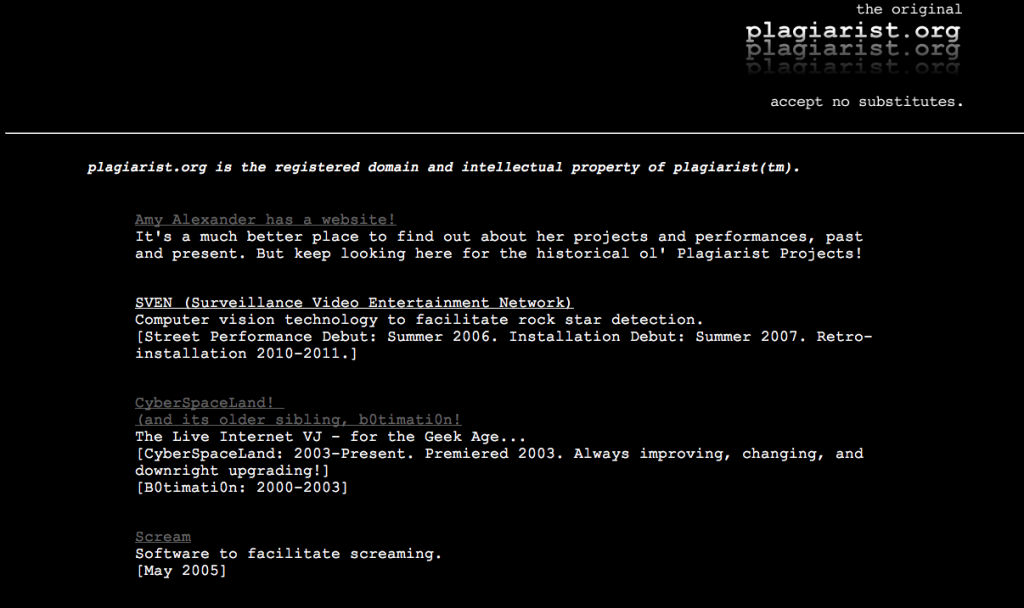
Übergeek is different, since I physically go out and perform as her. She’s both a theatrical character and actual club performer – in varying proportions depending on the context of the show. The theatrical character is a geeky rockstar wannabe. That opens up space for Übergeek to exaggeratedly escape the physical restrictions of performing on a computer – by waving around an “air mouse,” dancing on a DDR pad, etc. The club performer comes from my growing up performing music. I’d never thought about it, but the zone musicians go into to perform is really like playing a character. You have to become someone else. A few years ago I heard Steve Schick explain that when he has to perform a difficult piece of music, he imagines he’s someone else – and that other guy can play the piece. Eventually I realized that any performance of any kind I’d done that I’d been remotely satisfied with, whether music, VJ show, or performance art – I’d mentally become some other person. Going into character is really important, even if the character is just, “the performer.” It can be easy to forget the crossovers between performing arts and visual arts, but there’s a lot we can learn from one another.
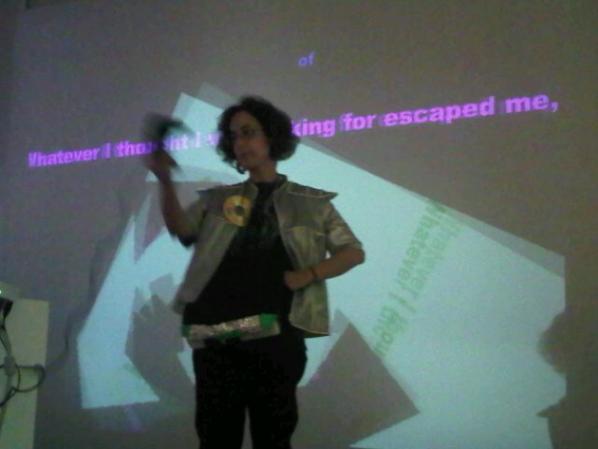
RBE: Do you think this happens to us when we interact online, that we become performers? (Some people believe for instance that Facebook is really a performance of ourselves, not our real selves) Do you see any intersections of performance in “online” vs “physical/ in person” interactions? (I realize this gets into an entirely different question, the idea of intentional performance and unintentional, but perhaps you see an overlap?)
AA: I think there’s an overlap, but there’s also an overlap between the kind of “performances” we do online and those we do in “real life.” I don’t buy the dichotomy that the physical world is real/true and the online world is fake. We perform different sides of ourselves in different real life situations – work, friends, family, large group, small group, etc. Sometimes we perform more consciously than others. On the other hand, sometimes we feel less inhibited in online interactions, so we behave more naturally.
That’s not to say there’s no difference between online and offline interactions – but then again, these differences didn’t just suddenly emerge when the Internet came along. Think back to when people sometimes had pen pals by snail mail, for example. The relationships could be friendly, intimate, or performative. When things like immediacy and nonverbal communication disappear, that invites a different kind of behavior – be it more natural, more performative, or a combination.
RBE: What connections do you see between identity, code, and performance?
AA: I guess I’ve responded to identity & performance in the question above. As for code & performance: people have pointed out that code parallels musical notation, in that both are executable languages. If you think about scores by people like John Cage, where scores could actually be diagrams or verbal instructions to the performers, the connection between performance and instruction set becomes even clearer. This is interesting historically and theoretically, but for many of us who use code in performance, the connection becomes self-evident in practice. Code launches processes and actions, and performance *is* processes and actions, and there’s a back and forth between the performer and software. It’s not that much different for me performing software than performing a musical instrument; if I play violin, I finger, bow, pluck in various ways to get various sounds. You can think of the violin as interface, the notes and gestures as parameters, or whatever. But to be honest, trying to create precise analogies is a recipe for disaster. The point is, you perform both of them, and you have to learn how to do it. The difference with software is, you build your own instrument; that’s both a blessing and a curse. So you try to balance playability with flexibility, and so on. Because of my experience playing music, I keep trying to build ones that will accommodate clumsy performers like me!
RBE: Do you see all code as being “performed”? (Or perhaps is saying code is executable the same as saying code is performed?)
AA: It depends on which sense of the word “performed” you’re using. In the sense that means to do some sort of process – like to perform your job duties – yes. You can think of data as nouns and algorithms as action verbs. You “run” code, and though the physical metaphor might be an exaggeration, in general, some sort of an action happens. So in that sense, the processor is performing the code.
But in the other sense of the word – intentional performance, performing arts, performance art, etc. – running code is innately no more of a performance than breathing. People like John Cage have made interesting performances out of breathing, and people like Alex McLean have made interesting performances out of running code. But it’s not that way on its own, except in the Cagean sense of it being performance if you think of it that way. I think that’s interesting, but I’m personally more interested in code’s cultural, rather than formal, implications. In other words, I’m not so excited that processes are dynamic and self-repeating for their own sake. I’m more interested if, for example, that means we have increasing difficulty finding unpopular or obscure information online, because the popular perspectives have formed an algorithmic echo chamber.

RBE: Your newest work is using audiovisuals, performance, solar energy, and the history of dance in cinema. How did you arrive at this combination of ideas?
AA: The project is Discotrope: The Secret Nightlife of Solar Cells. It’s an audiovisual performance – a collaboration with Annina Rüst, with algorithmic sound design by Cristyn Magnus. There’s really two parts to the project: the projection system, and the content and performances that we develop for it. The system is a disco ball where some of the mirrors have been replaced by solar cells. The cells power the motor that turns the ball. We project video onto the ball instead of colored light. The result is, reflected, fragmented video images move around the room. Since the video projections “solar”-power the ball, the speed at which the images move around the room varies with the brightness of the images.
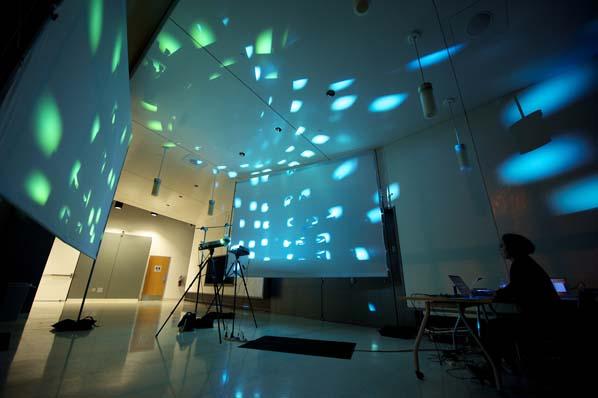
The way this all came about was I’d been interested in the philosophy behind hybrid cars and various other things – that when we “waste” energy, we might actually be creating it. I kept wondering if this idea could be applied to media somehow, and I kept trying various experiments with video: could the talking heads on cable news power an LED? etc. Never quite found the right outlet for this idea, though. At some point, Annina and I came across a disco ball, and we noticed the similarity between its mirrors and small solar cells. Then the idea of projecting videos onto it hit us, and it all came together as a “media-powered” system. Of course, that was just the general idea. After Annina built the initial prototype of ball, it took many hours working with it the studio for the “instrument” to reveal itself – i.e. how exactly does a video-powered disco ball become useful visually and performatively? Figuring that part out was just elbow grease – but getting from rough idea to what-is-this-really always is for me; I have to get my hands on things and play with them.
The content framework we’re working with for at least our initial round of performances is “the history of dancing ‘at’ cameras.” Since it’s a disco ball, we envisioned performing it at community dance parties, etc., and so people dancing seemed like the obvious thing to project. We started from the idea of projecting the people at the party onto it live – but we realized we also wanted to expand beyond that. Again, the elbow grease process: I’d try different clips of people dancing on YouTube, old movies, TV shows. Eventually a connection emerged between early cinema clips and contemporary YouTube clips. In both cases, people dance pretty much like vaudeville performers, directly for the audience – as opposed to cinematic narrative style, in which the viewer is a fly on the wall. In the dancing “at” cameras style, there’s a more direct, intimate connection between dancer and audience. We’ve written some things about this on the Discotrope blog – and I’ll probably write more there soon. Another thing we became interested in is how representation (gender, physical, etc.) does and doesn’t change from early movie camera demos and Hollywood films to YouTube, where people are generally self-cast and self-directed. And I’m really interested in the relationship between all of this and the muddy space between exhibitionism, voyeurism, and surveillance. That’s a theme that’s run through a number of my projects, and dancing at cameras certainly exemplifies that murkiness.
Of course, a lot of the dancing at cameras perspective relates to film history in general – cinema’s origins in theatre and vaudeville, the development of montage, etc. So it’s interesting to see it return with YouTube. Teresa Rizzo has written a really interesting article related to this called, YouTube: The New Cinema of Attractions.
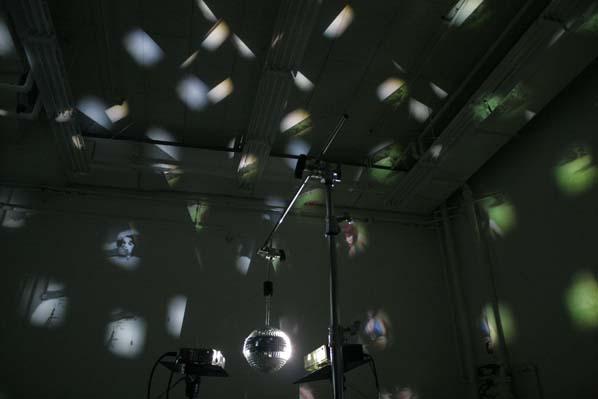
RBE: When you say “people dancing at cameras” I immediately thought of surveillance cameras. Is your disco ball a type of surveillance camera?
AA: I’m really interested in the blurring between surveillance, exhibitionism, and voyeurism. The Multi-Cultural Recycler, SVEN, and CyberSpaceLand all hit on that theme in one way or another; this time it’s cinematic dancers. The cinema/YouTube performers who appear in Discotrope all knew they were on camera, so overtly it’s more about exhibitionism and voyeurism. Glamorous 1950’s female burlesque dancers did their strip tease acts for the camera; sixty years later, not-so-glamorous scantily-clad men proudly stomped through the Single Ladies dance on YouTube. One group does work-for-hire within the Hollywood studio system; the other does what they want. Does that make one voyeurism and the other exhibitionism, or is it more complicated than that? in some cases, we see the performers much differently than they probably saw themselves. Does that make it surveillance? I think it’s all very muddy, and that’s what I find interesting.
The flip side is that there are people in some of Discotrope’s YouTube videos doing things like dancing in Walmart, which gives the video a surveillance camera look even though it’s obviously not surveillance (in the traditional sense, at least.) People turn the tables on surveillance video and make their own production numbers in surveilled/controlled areas – for fun and as a type of resistance. That’s one of my favorite parts of Discotrope. Then we get to recreate those Walmart spaces in the big Discotrope projection. It makes it even more like an old Hollywood production number, and it makes it weirdly immersive. This is fun for us, because Walmarts are not the kind of thing normal people like to recreate immersively. 🙂
RBE: For this piece you are creating something for other people to perform with. Are there any differences for you in creating work that you will perform vs. others performing?
AA: Ah, those pesky multiple senses of “performance” again!. 🙂 I do the visual performances for Discotrope, so for now I’m primarily building the software system for myself to perform. So far Annina is the only other person who performs with the software. Like anything, it’d require some tweaking to be distributed for more general use, though I’ve tried to make it not too terrible in that regard. 🙂 More challenging/interesting might be for performers to get the feel for moving the ball – like anything, it takes practice to get proficient.
But perhaps you’re talking about performers in terms of the audience who can dance to Discotrope, or the parts of the show where audience members can dance on camera interactively. In this case, they’re both performer and audience at the same time. That’s an interesting challenge, because in designing the show, we have to think about them in both ways.
RBE: You are starting a residency at the iotaCenter in Los Angeles, what will you be working on there?
AA: It’ll be mainly exploratory/preliminary research; things will likely be changing/developing as I go along. But my general plan is to explore two threads: gestural and spatial cinematic performance. In performing CyberSpaceLand over the years, I found myself unconsciously developing certain gestural/structural performance techniques that were much different than what I’d consciously designed for the piece. That spawned some ideas about gesture, time and space that I’m going to try to take further. The spatial thread grew out of some things we’ve played with in Discotrope in terms of deconstructing cinematic narrative in a 360 degree space. I’ll be exploring these spatial cinema ideas both in regards to Discotrope and as broader research.
iotaCenter’s a great place for doing research in abstract / formal and experimental cinema, visual performance history, etc. They’ve got a terrific collection of films and texts. I’m hoping to also use the opportunity to get together with other experimental cinema and visual performance folks in LA. It’d be great to organize some fun/intellectually-stimulating/breathtakingly-earthshattering screening/performance events.
RBE: This interview is going to be part of a series of interviews with women working in art and technology. What do you consider to be important today about being a woman working in art & technology? Do you think it is still useful to discuss the female voice as a separate voice in the field?
AA: It’s a tricky subject, because we both need to hear women’s voices and avoid tokenizing or homogenizing them. Women artists working with technology do tend to have different perspectives than men, and there are far fewer of us. So often when the dominant themes emerge, they tend to be the “masculine” themes by virtue of sheer numbers. A corollary is that often women artists feel pressured to focus on gender issues or certain types of social issues. Again, it’s a problem of critical mass and self-perpetuating themes. Since a fair number of women are already involved with those topics and many women’s interests overlap there, they have momentum. But this ends up discouraging women from discussing or doing work on other topics they’re interested in, So, while we need to talk about shared experiences among women in art and technology, we also need to recognize that they have a diverse range of work and perspectives.
RBE: How have you seen perceptions of gender change through the years either in teaching, performing, or working as an artist?
AA: It’s interesting to think that the first programmers were women, and that at the time it was considered clerical work. (See Researcher reveals how “Computer Geeks” replaced “Computer Girls” by Brenda Frink.)
As men started to fill programming jobs, the perception of programming shifted. It became something “technical” that was somehow inherently “man’s work,” even though it had been clerical “women’s work” only a few decades earlier. I’ve seen something similar happen as a female computing artist. I think there are more of us now – at least we don’t seem to be the novelty we were ten or fifteen years ago. And I’ve seen a shift in attitudes and perception among undergraduate computing arts students: by now both the men and women have grown up playing video games and doing a variety of Internet activities that might have seemed like “boys-with-toys” pastimes a decade ago. So their perceptions of what they’re learning to do as computer artists is a little more open and less gendered. But unfortunately, there are still circular perceptions in all age groups that whatever technical work women are doing can’t be too serious by virtue of the fact that a woman did it. It would seem to parallel the current political debate in the US about the pay gap between women and men. There are always arguments that women’s jobs aren’t as demanding, and they usually end up with someone saying, “I can’t believe we’re still talking about this in 2012!” So on one hand, the more things change, the more they stay the same. On the other hand, as more women computing artists emerge, we’ll hopefully soon achieve sufficient critical mass for world domination. Don’t say I didn’t warn you.
Andreas Broeckmann writes on art, machine aesthetics, and digital culture. He is director of Leuphana Arts Program at the university in Lüneburg, and has played key roles at transmediale – festival for art and digital culture, ISEA2010 RUHR, TESLA-Laboratory for Arts and Media, Berlin, and V2_Organisation Rotterdam, Institute for the Unstable Media. Lawrence Bird interviewed him on our current experience of media and civil society. Image: A. Broeckmann, transmediale 2007 (© Jonathan Gröger)
Lawrence Bird: It’s often said that we inhabit the city differently today because of our engagement with media and media technologies. This has been one of your main concerns, and it makes for a very interesting intersection of media theory and public realm theory. Where does this preoccupation come from on your part?
Andreas Broeckmann: I have arrived at these questions not so much from a theoretical or academic perspective, but in response to specific artistic practices that I was interested in. For my own thinking about this area, the works that the artist group Knowbotic Research were working on in the 1990s were seminal. The participative public installation “Anonymous Muttering” (1996), for instance, initiated a radical clash of the physical urban space with the virtual ‘space’ of the internet, interlacing the activities of the participants in a way that created a strange intermediate zone – maybe we could say that it allowed people to place themselves _in_ the medium. In the series of projects that followed under the title “IO-dencies” (1997-99), Knowbotic Research further explored the possibilities of becoming active, of acting in a virtual environment in a manner that was connected to activities and events in the physical space.
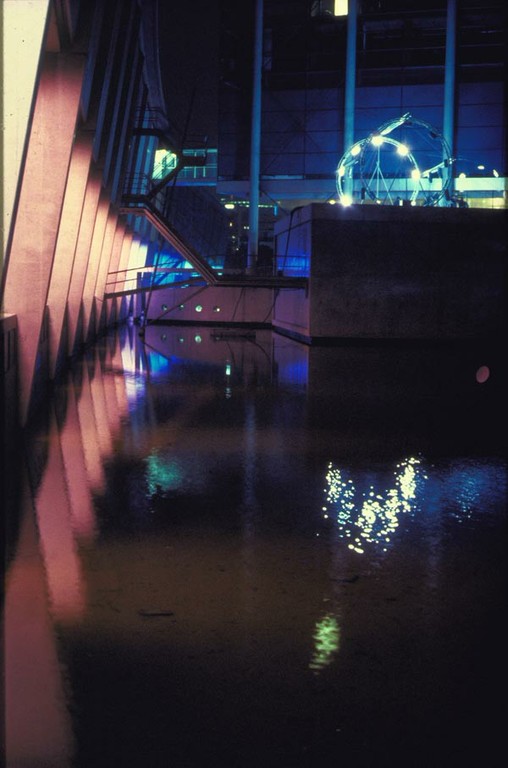
I was working quite closely with the group at the time, presenting some of the projects in Rotterdam where I was a curator at the V2_Organisation, co-authoring texts, organising workshops, etc.. This was a great opportunity to think through the issues of the new, hybrid public sphere that was opening up because of the Internet. In order to understand the works, it was necessary to develop a differentiated conception of what it meant to “be public” or to “become public”. The topic returned, for instance in projects I was involved in by Rafael Lozano-Hemmer in Rotterdam, or a publication on Polish video art by the WRO agency, or a major curatorial on a media facade in Berlin, or, for that matter, more recent projects by Knowbotic Research, like “Be Prepared Tiger”, or “MacGhillie”. Personally, I believe that privacy in all its guises – from camouflage and the absence of surveillance to “a room of one’s own” – is one of the great privileges of a modern individual. Contemporary media and communication technologies have transformed the possibilities of being private dramatically, just as the notion of what it means to be public is subject to drastic changes. And artists are articulating these changes which we are all part of, giving us opportunities to reflect on what is going on, and to imagine how things might also develop otherwise. I think that my interest in the relationship between publicness and intimacy is fed both by a personal sense of urgency and and concern, and by the inspiration I get from artists, not to fall into despair.
Lawrence Bird: Fascinating. So would you say that in the direction media are now evolving, there’s actually an increased scope for private “being” — not just in terms of a potential for increased anonymity and independence, but in terms of a richer and more developed individuality? To a greater degree — or perhaps qualitatively different — than was possible in earlier stages of modernity?
Andreas Broeckmann: Unfortunately not… I say that privacy is a privilege exactly because it is becoming such a rare condition these days. The developments that we speak about are, of course, not unidirectional and homogeneous, but very diffused and heterogeneous, and open to quite different interpretations. For many people, a platform like Facebook or Google-Plus is a way of discovering a new form of sociality in which they try out different ways of being public and being private.As for myself, having been brought up with the Critical Theory analyses of the Frankfurt School, I find it difficult not to see these optimistic readings as dangerously naive – it would be a bit like exploring your inner self in the highly regulated and commercial spaces of a shopping mall… I would not go so far as to say that privacy has completely disappered — as though we were now living in a global village of Big Brother containers, or in a vastly extensive version of the Truman Show. But I do think that today we lack a more widespread critical sense of resistance to the regimes of commodification that have taken the place of what were once “privacy” and “social relations”.
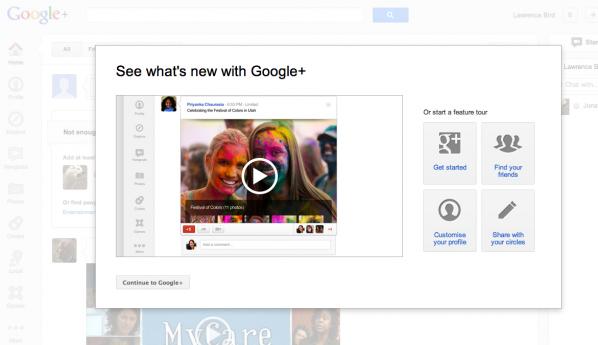
Lawrence Bird: You spoke about the concern of “falling into despair”. How general would you say that motivation is? I don’t know if you’ve thought about it this way, but I’m thinking in terms of Occupy, and the other social movements, many of them enabled by media and engaged by artists, which seem to generate new, and some evidence suggests quite lasting, relationships of trust and hope. Many of these seem to come in response to a recent loss of faith in corporations, governments, financial institutions — older social groups that had an important role in old definitions of “public”. I wonder if your comment connects with a widespread yearning for hope, in response to conditions that might well produce despair?
Andreas Broeckmann: I dare not speculate about the longevity of the relationships that have been built by the different branches of the Occupy movement, but I am skeptical about the longevity of anything that is built on specific internet-based media platforms. Facebook, for instance, was launched in 2004, that’s eight years ago, and the German and many other non-English Facebook services are no older than four years. That’s a very short time, and we might want to remember that platforms like Google (*1998), Facebook, Flickr (*2004) or Twitter (*2006) are not part of the natural environment, but recent services offered by profit-oriented companies which, just as well as they may rule the internet world throughout the 21st century, might also get drowned in the swamps of global capitalism (whose regime includes “customer confidence”).
I would refute the assumption, implicit in your question, that many of the people who protested on the squares in Madrid, Cairo, Washington or Athens last year were people who previously had faith in their governments, or the institutions of capitalism. Of course they didn’t, and quite rightly so. What was special about last year was that there is a new, articulate generation of people who would not put up with the situation of stasis, hopelessness and frustration that has paralysed major parts of global societies since 2003 when, in February of that year, millions who took to the streets around the world in protest, were not able to stop the US government and their allies from starting the war on Saddam Hussein’s Iraq. The inflection of this event is different in different parts of the world, but I believe that we share that moment. And this is where the protests in the Arab countries, and those in Spain and Greece, hit the squares on a parallel trajectory: In the same year of 2003, the German government started the implementation of what was called the “Agenda 2010”, a project based on the EU’s 2000 Lisbon agreement of economic restructuring, with the aim of making Europe more competitive on the global market. Since then, in Germany we have seen an erosion of the welfare state, drops in income for lower and middle classes and a huge increase in precarious jobs. But some economists also say that the reason for Germany’s relatively healthy economic situation today, compared with, for instance, Greece or Spain, is that these countries failed to reform their debt-pampered economies. Which is why there is a certain reluctance today in Germany to protect privileges for the Greek middle class, privileges which German citizens already had to give up years ago.
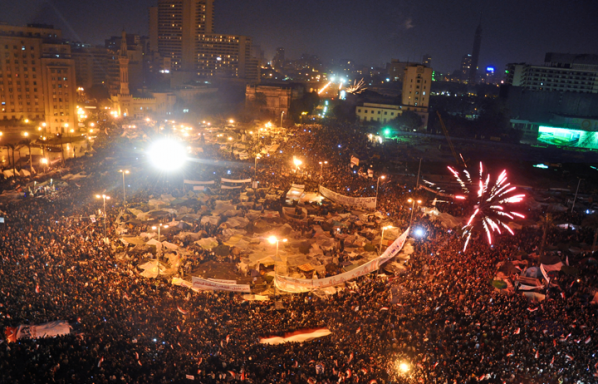
above: Tahrir Square on February 11, by Jonathan Rashad (CC-BY-2.0, 2011).
My point is that if we take things into a more extended historical perspective, and if we count our lives not in short Twitter months, we can see how the struggles, the hopes and the despairs of today are part of a broader set of transformations. And we can see that in these transformations there are forces at work which have a huge inertia and which need to be worked on and battled with both patience and long-term strategies. Like any other revolution, and like in the theatres of the Occupy movement, the one in Egypt may have started on Tahrir Square and the mobilisation of people through media-based social networks, but to complete that revolution, a difficult and drawn-out political struggle needs to be fought. Maybe that is the necessary realisation that hit “the movement” this past winter.
Lawrence Bird: And what form might those long-term strategies take? It’s a huge question perhaps, but do you have any ideas about the shape this restructured public sphere might have to take, what forms of governance and participatory democracy for example, to sustain a more permanent change?
Andreas Broeckmann: Personally, I believe that for the foreseeable future many political struggles will continue to happen in the ‘arenas’ of political institutions like governments, parliaments and other election-based structures, in political parties, public administrations, in transnational and inter-governmental decision-making bodies, in trade unions and NGOs. It is a realm that will only partly be affected or influenced by the online world, and even if the emerging public sphere of the Internet and its social media forums implies a huge expansion and diversification of the mass media dominated public sphere of the 20th century, this expanded public sphere will not necessarily have a bigger impact on political processes than the ‘old’ public sphere did. The experience of the ‘movement’ in Egypt today might be analoguous to that of the APO (the extra-parliamentarian opposition of the students movement) in 1960s and 70s West Germany, i.e. realising the necessity of getting involved in existing state institutions (“the long march through the institutions”), which brought members of that generation to power some 25 years later in universities, in parliaments, in national governments. The relevance and standing of the new Egyptian parties is not proven or disproven in the first elections; it is decided when in ten or twenty years from now they may or may not have been able to change the social consensus about democracy, rights, and freedom.
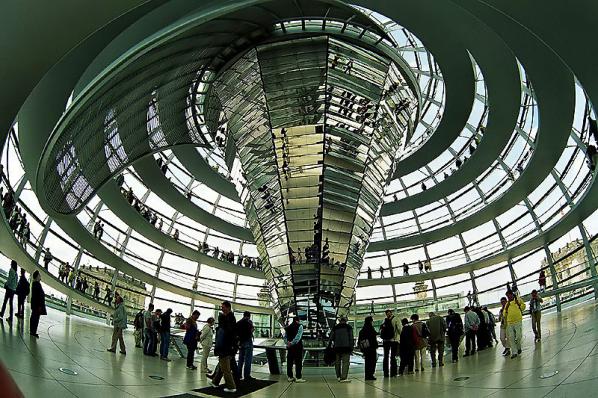
Lawrence Bird: A confession here: I’m an architect, so I always assume, perhaps naively, that a built infrasructure can play a role in these kinds of transformations. In your opinion, might a material intervention be a necessary part of those changes — distinct from, though perhaps in dialogue with, the mediated public realm? What kind of physical (urban) spaces might serve as a counterpoint or moderator to the transience of the Twitter world — and are those spaces any different from the urban spaces we have now?
Andreas Broeckmann: I doubt whether architecture in the narrower understanding of the term will play much more than a symbolical role in these struggles and transformations. Of course, the built environment, especially the way in which public space is configured, plays a significant role in how public life can unfold in cities. And there are political issues to be fought over: for instance, I find it curious how in many of the European cities the authorities allow the construction of one shopping mall after the other, pushing the social and commercial activity of shopping into privatised and highly regulated control spaces, and then those same authorities are surprised when the neighbourhoods in the vicinity of these malls deteriorate because the normal shops are abandoned or have to be closed, making room for trash and money laundering businesses. The resistance against such developments can at times most effectively be fought in local parliaments that, at least in Germany, have to give their consent to such major construction projects. This makes it necessary to join a political party, get elected into the local parliament, sit around in meetings, deal with all sorts of issues of public interest, etc., and be there when the application for the next shopping mall is up for decision…
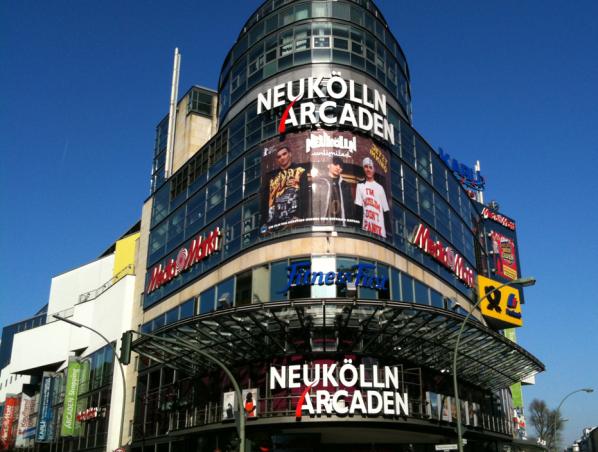
Of similar relevance is the designing of the digital sphere through software ‘architectures’ – both in terms of individual applications and services, and in terms of the overall technical infrastructure, both hard- and software, and its governance. The critical discussions around the status of ICANN and, more recently, the public protests against law-making initiatives like SOPA and ACTA, have shown that protests can in fact have an impact on such structures. Yet, that impact will remain cosmetic if the public outcry is not followed up by sustained political work through which the drafting of and the decision-making on such laws is factually influenced. This is what lobby groups do, and this is what social movements also have to do, finding whatever possible and suitable political instrument or institution through which to act.
The major arena of constructing and designing the new political sphere will be in law-making, and I believe that the movement needs critical lawyers, historians of economy and charismatic intellectuals more urgently than architects – although, of course, everybody has an important role to play and no-one who wants to contribute should be sent away.
Lawrence Bird: And how about artists — do they have a role in this? To provoke, perhaps? To articulate social and political conditions? Would you say that whatever that role is, it can be part of the sustained transformation you’re talking about — or do they need to step down into a governance role to take part in that (Vaclav Havel being one example).
Andreas Broeckmann: In my understanding of art, there is no particular role that it can, or even “should” play. I would argue that the most important aspect of art for society is its autonomy and the fact that it has no particular responsibility. Art can beautify, it can decorate, it can irritate, it can disturb, it can question, it can affirm, it can simplify or complicate. Such an “open program” of course implies that individual artists or groups, or specific projects, will take a particular political stand, will try to influence a social or political situation — will seek real impact. This is a form of activism that art can borrow from political groups and movements, but it is not the activism that is crucial for the artistic practice, it is the transgressive articulation that artists may achieve in their own dealing with social realities. I want to emphasize that this is my understanding of art, and I fully respect people who think that art can and must be more engaged in social processes in order to be relevant. But again, I think that what art can give us most importantly is what happens in a zone of freedom that is morally, aesthetically and sometimes also politically more risky than anybody who acts in the political arena — save for the mavericks — would want to be.
So the question, “what should artists do,” can in my understanding only ever be answered: “they should do whatever they do.” It must be the best thing that they can do, they have to be precise in their formulations and realisations, they have to be committed, diligent, and daring. It is wonderful if they can, in that way, help proliferate good ideas and push the political situation in a good direction. But by the same token I believe that it is equally wonderful if artists ask questions that are impossible to answer, or pointing out unsolvable ethical dilemmas, or remove the mask of an opponent only to don it themselves.
There is, in my eyes, certainly no obligation to go into politics like Havel did. Artists are not always people with a high moral reputation, and stepping into the political arena like Havel did requires stamina and a certain habitus. And there are many ways in which people can intervene in social and political processes. Take the example of Aliaa Magda Elmahdy who posted a photograph of herself naked on her website and sparked a huge debate about the situation of women in the Islamic world. This was not an art project, but it shows what work in the realm of symbols can achieve.
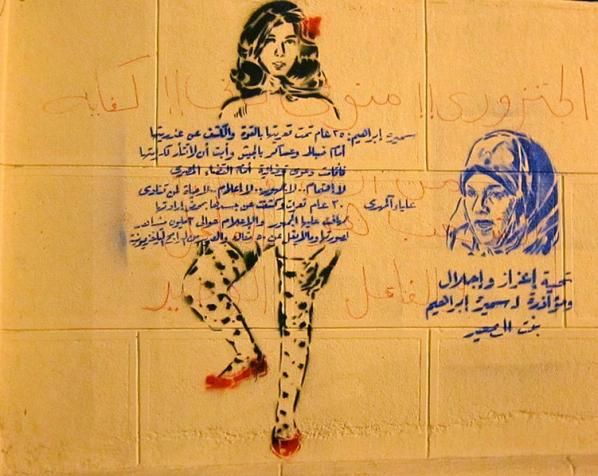
Lawrence Bird: If I could I’d like to steer the conversation in the direction of your thinking on “the wild” — perhaps it relates through the transgressive nature of art you’ve just been discussing, and the tricky relationship of that to civic functions, governance, and related realms of responsibility. Cities have been conceived as set apart from the wilderness — within the city lay the realm of humanity, civility, politics; outside its walls, the wild, monsters, raw life. Girorgio Agamben makes the case that the violence of our times equates to the obliteration of that line: between political life (zoe) and bare life (bios).
In light of what you’ve already said about art and transgression, and the value of that; and the precarious status of privacy today, and the danger of that; your understanding of media and the political movements underway today which involve some significant transgression of the boundaries of authority, I’m willing to bet you have a more nuanced take on this issue. What’s our condition now with regards to the edge of the wild? Is it a constantly shifting boundary, what Agamben refers to as the caesura? Does it imply a human condition interdigitated with an inhuman condition, like a werewolf, or cyborg? Does our humanity in fact find its source in the wild?
Andreas Broeckmann: The questions that you raise are of course extremely complex and very difficult to do justice in the current context. So allow me to shirk the anthropological discussion, which I guess I don’t have a particularly original opinion on anyway. When I spoke about the “wild” as an aspect of digital art a few years ago, it was in a half ironic, and half romantic way: ironic in the sense that art that makes use of digital media is technically conditioned and requires a “tamed” environment to function at all; even what is referred to as ‘glitch aesthetics’ is predicated on general functionality, the glitch being only a minor aberration, not a substantial fault. Yet, as you would gather from what I said before, I am also ‘romantically’ attached to the idea of an artistic practice that transgresses these technical functionalities and explores failure, dysfunctionality, misuse, or uncontrollability as categories of aesthetic experience. I’m thinking of artists like Gustav Metzger, Jean Tinguely, Herwig Weiser, or JODI, who in their works perform, we might claim, the potential wildness of technology. This is mostly a controlled, at times even metaphorical wildness, whereas the true wilderness of technology, if we want to go there, is probably the realm of the accident that Paul Virilio has so poignantly written about. An “art of the accident”, as we entitled a festival in Rotterdam in the late 1990s, is, I believe, only possible in the realm of metaphors.
What I’m currently wondering about is whether in our 21st-century cybernated world a notion of “nature” as something different from culture maybe disappears completely, as we have full Google-ised view and total measurability of what happens on Earth, from millimetre shifts of tectonic plates to carbon dioxide output of cattle. In such a world, there would be no room any more for the “wild”, only for different degrees of pollution on the one hand, and endangerment of species on the other…
In the long run I have trust in the finality of all existence, and the futility of all human efforts. But in the short term, that is, in our lives, I believe that we have to work to make the world a little better, or at least do our best to not make things worse than they are.

Featured image: “Born in 1987: The Animated GIF” from the site’s page.
Marc Garrett interviews Katrina Sluis, the new curator of the Digital Programme at The Photographers’ Gallery, London. We discuss about the gallery’s recent show Born in 1987: The Animated GIF and what kind of digital exhibitions and projects we can expect from the gallery in the Future.
An edited selection shown on the London Photographers’ Gallery’s new digital wall, during the final weeks of the show. http://thephotographersgallery.org.uk/the-wall-2
The exhibition microsite. An open conversation where anyone can join in and contribute their own GIFs. http://joyofgif.tumblr.com/
Marc garrett: You have joined The Photographers’ Gallery and as part of the new digital programme launched the exhibition “Born in 1987: The Animated GIF”. Could you tell us about this project?
Katrina Sluis: The digital programme presents projects both online and offline, which respond to recent dramatic shifts in the digital image as it becomes increasingly screen-based and networked. As part of this new programme we have launched ‘The Wall’ – a permanent exhibition space on the ground floor of the Gallery, visible both to visitors and passersby on Ramillies street. The Wall itself is a 2.7 x 3m Sharp video wall which we installed after considering a number of different technologies. We were conscious not to use digital projection as it would locate the project within traditions of cinema and video art, and we wanted the screens to respond to the reception and distribution of images within wider visual culture.
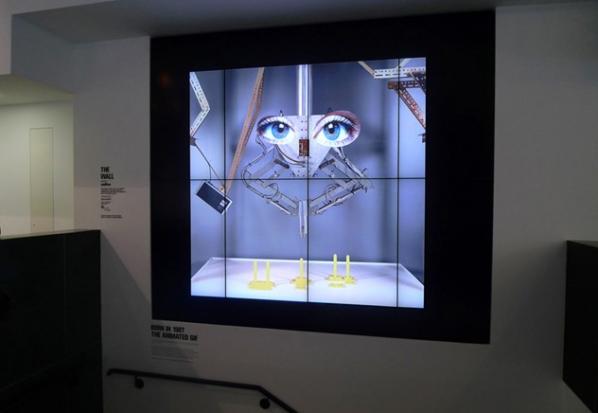
For the opening show, we decided to focus on the animated gif for a number of reasons. Firstly, the gif is a uniquely screen-based image format, in which the specific characteristics and limitations of the image file are inherent to the form, in contrast to the other kinds of images the gallery might show which might adopt digital techniques but result in traditional print-based photographic work destined for the gallery space.
I also wanted to disrupt certain expectations about the screens – the fetishisation of resolution and image quality, and what kinds of photographs The Wall’s programme might seek to address. The animated gif in this sense is very interesting – it is one of the first image file formats native to the web, and although it is 25 years old this year it has been undergoing a resurgence on platforms such as Tumblr. In a commissioned essay for the show, Daniel Rubinstein speculates that current resurgence of the gif “is not only part of the nostalgic turn towards the blurred, the unsharp and the faded but it is also a marker of a moment when the history of the network becomes the material from which the digital image draws its living energy.”[1] Frequently authorless and contextless, the gif image works on a different economy in which its value is based not on its uniqueness and scarcity (as in certain forms of art) but its circulation and proliferation. Although there have been significant practitioners of the gif form, it is a format which ultimately resists canonization. And, in the context of a photography gallery, it opens up other debates concerning medium specificity and the ‘post-photographic’.
In approaching the exhibition, I was keen to ask a diverse range of photographers, writers, organizations and other practitioners to contribute a gif for the show. In keeping with the unmonumental nature of the form, I asked contributors to respond within a short timeframe of 7 days. For many contributors, this was the first time they had made a gif; but other contributors already had large followings on Tumblr and some were established net artists. This opening show and associated Tumblr site (http://joyofgif.tumblr.com) became a starting proposition for the project in order to then open up The Wall to gif contributions from the wider public. We will continue to update The Wall with public responses on a daily basis until the final day of the show on 10th July.
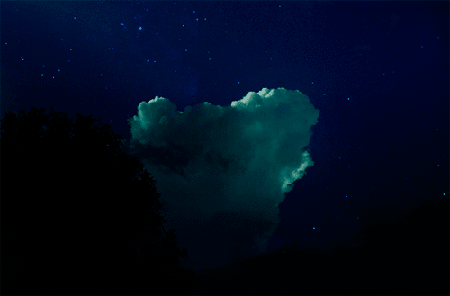
MG: At first, some may assume that the first part of the exhibition title ‘Born in 1987’, refers to the fact that today so many young people using computers these days were born in 1987. Yet, the GIF format, short for ‘Graphics Interchange Format’, was introduced to the world of computers by CompuServe in 1987. Was the title of the show deliberately playing with both notions?
KS: I like this idea! The title does self consciously play with the way in which the digital is valorised for its endless ‘newness’ and novelty but yet has this long and frequently overlooked history of creative experimentation. You can also see this reflected in the recent hype around the work of Kevin Burg and Jamie Beck who have (problematically and entrepreneurially) re-branded the gif as the ‘cinemagraph’.
MG: Do you consider this project to be net art, if so, how does it relate to other forms of net art?
KS: The project (and The Wall’s programming) does pose certain problems as it seeks to relocate certain forms of online practice(s) into the space of the art museum. At the same time, the project exists in an online context with its own very different life on Tumbr, where the work circulates in a very different context with a very different audience. I think there are many interesting opportunities which emerge from this intersection of the institutional frame of the museum (with its associated issues of cultural and curatorial authority and the legacy of aesthetic modernism) and the values and politics which inform certain kinds of networked arts practices.
But I also think the project also needs to be understood in the specific context of The Photographers’ Gallery, its history and audience. Whilst the project shares the concerns of net art by raising questions concerning authenticity, authorship and ‘the social’, it is also motivated by the need to rethink familiar notions of photography and temporality, indexicality and the economy of the image – concerns which presently haunt the field of photography theory.
![Kennard Phillipps. GIF image by Peter Kennard and Cat Phillipps. Born in 1987: The Animated GIF. The Photographers' Gallery 2012 [2]](http://www.furtherfield.org/wp-content/uploads/2012/07/fuck-the-markets-latest1.gif)
![Rad Racer glitch 3. GIF image by tracekaiser. Born in 1987: The Animated GIF. The Photographers' Gallery. 2012 [3]](http://www.furtherfield.org/wp-content/uploads/2012/07/tumblr_m5tqfl62wl1qew2moo1_400.gif)
MG: In what way do you see this form of creativity relating to others who may not be so well versed with net art culture, or digital networked practices?
KS: The Wall presents an opportunity for the Gallery to collaborate with diverse communities who can bring their distinct expertise and experiences to the programme, and the net art community has much to offer in this respect. For this reason, we aim to develop The Wall’s future programme through the framework of ‘collaborative research’, in which our audience, along with the organizations we partner with, are potential co-researchers. The co-researcher model developed as an approach to research democracy in the Social Sciences, particularly in the approach of Action Research in the NHS but in a more relevant cultural example was used extensively in the Tate Encounters: Britishness and Visual Culture research project. Co-research recognises both the collaborative and collective nature of meaning construction, through a process which attempts to trace and reveal the complex manufacture of meaning.
At the same time, there is still another related project to be done in highlighting and responding to digital projects whose life is online – this is of course something I admire Furtherfield for doing so brilliantly. On a smaller scale and with a more narrow focus, we hope to launch a blog which will draw attention to online work which relate to photography as it becomes polluted, valorized, hybridized and networked.
![GIF image by Paul Flannery. Born in 1987: The Animated GIF. The Photographers' Gallery. 2012 [4]](http://www.furtherfield.org/wp-content/uploads/2012/07/tumblr_m442xish4q1rvlji4o1_500b_0.gif)
MG: Some, may view this this exhibition as relating to Internet Folk Art. There is an interesting article by Kenneth Goldsmith[1] where he discusses the digital theorist Rick Prelinger’s claim “that archiving is the new folk art, something that is widely practiced and has unconsciously become integrated into a great many people’s lives, potentially transforming a necessity into a work of art.”
Now, this is not directly relating to the show itself, but it resonates something regarding the inclusiveness of the show. So, in respect of it ‘possibly’ possessing aspects of Folk Art, what connections do you see as relevant or not, and what does it mean to you?
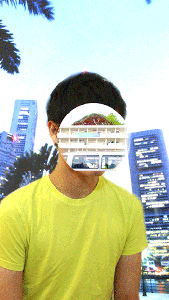
KS: By focusing on the gif the show does problematise the distinction between artist and audience, in which participation, openness and the ‘crafting’ of the image becomes key. However I have reservations about the use of the term Internet folk art, which could be construed as imposing a certain modernist logic on the discussion, burdening it with an analogue modeling of high and low culture. The research approach has been adopted precisely to avoid the trap of binary nominalism, and to problematise the tendency to shoe horn internet practices into the language of cultural studies and aesthetics.
MG: The Photographers’ Gallery was the first independent gallery in Britain devoted to photography and has been going since the 70s. It is the UK’s primary venue for photography and has been dedicated in establishing photography as an essential medium, representing its practice in culture and society. It seems that The Photographers’ Gallery is going through another transition. You have already mentioned how hybridized and networked the nature of future projects will be. So what kind of exhibitions and projects can we expect in the future?
KS: Because digital technology is not in itself a new photographic medium, but essentially a hybrid and converged set of technological practices, it raises many interesting problems, both theoretical and practical for a Gallery focused on photography. To the computer, the photograph is indistinguishable from the other binary blobs of data we used to call books, films and songs. The crisis of digitization and medium specificity now extends to the domain of the camera – Digital SLRs are coveted for their ability to shoot high quality digital video, and we turn to our mobile phones when we want to take snapshots. This is a very rich context for the programme to explore, and ideally the future projects will respond to the technical, creative and cultural languages of photography as produced by computer engineers, web developers, photographers, artists, networked communities, social scientists and other practitioners.
Our next show on The Wall (opening 13th July) features the practice based research of Susan Sloan into portraiture using motion capture and 3D animation techniques widely used in entertainment, medicine and the military. Her motion studies refer to the traditions and conventions of portraiture and the changing role of the camera as a recording device. At the same time, her work raises questions concerning the convergence of painting, animation, film and photography in the digital realm.
The future digital programme which will occupy different spaces and address various photographic practices including augmented reality, social media, electronic publishing, interactive media, mobile computing and synthetic imaging.
The Joy of GIF – the London Photographers’ Gallery’s new digital wall. Article by Wendy McMurdo.
http://www.foam.org/foam-blog/2012/may/photographers-gallery
Featured image: corporations are not people – the Overpass Light Brigade
Overpass Light Brigade in Tosa from Overpass Light Brigade on Vimeo.
Wisconsin has arguably been ground zero for union busting, DIY social movements, corporate takeover of government, and divisive – and often misinformed – political debate in the US for more than a year. And the Overpass Light Brigade (OLB), initiated by Milwaukee artists Lane Hall and Lisa Moline, have been a guiding light – literally – in how ground-up messaging and change can happen. Now a collaboration between many people, the OLB relies on an ever-widening community of activists, artists, thinkers, and do-ers for their “Signs of Resistance.” After a few rounds of local rye whiskey at Milwaukee’s Riverwest Public House Cooperative – one of the only co-op bars in the country – I did an email back and forth with OLB co-founder Lane Hall to find out more about what makes them tick, how they see themselves, and where the movement they are a part of is headed.
Nathaniel Stern: What is OLB? It feels more “struggle-” rather than “goal-” orientated, despite that its first mainstream recognition is in relation to a specific campaign. Can you talk a bit about its history: how it started, where it headed, and what it might become?
Lane Hall / Overpass Light Brigade (OLB): On November 15 of last year a rally was organized by grassroots groups in Wisconsin in order to kick off the Recall Walker campaign. It was to begin right after work, at 5:00 pm. Both Lisa Moline (co-founder of OLB) and I had been very active in what we now think of as the Wisconsin Uprising, and we asked ourselves the simple question, “How do we achieve visibility for graphic messages when it is dark at 4:30?” We began to tinker with off-the-shelf Christmas lights, and found some battery-powered strings of LEDs. We built our first sign, a 3′ x4′ panel that spelled out RECALL WALKER. When we arrived at the rally, we were immediately asked to be behind the speakers. That sign got on the Rachel Maddow and Ed Schultz show that evening, so we knew we had hit on something that afforded powerful visibility. That first sign is now, incidentally, in the archive of the Wisconsin State Historical Society.

We then proposed a second design challenge to ourselves: how do we get messages out to masses of people, since we can’t command the airwaves like Walker’s Koch-fueled campaign? Once we decided to go out on highway overpasses, we “scaled-up” the letters so that we could spell out words, refrigerator magnet style, one letter per 2′ x 3′ placard.
Our first night out was on an overpass in South Milwaukee. It was very cold, fairly miserable really, with freezing winds kicking up from the passing semi-trucks. We had a few fellow activists to help, and our idea was to bungee-cord the signs to the fence while we stood by. We were accosted by a right-wing nut, a Young Republican, who was vehement in his insistence that we were breaking the law by affixing the signs to the fencing. He ended up in a physical altercation with Lisa in his insistence to rip our signs off the fence as well as forcefully take Lisa’s video camera, since she was capturing his vigilante actions on video. When the police came, they did reiterate that nothing could be affixed to the bridges, though also supported our right to be there. From that night on, we realized that for OLB to work, we needed Holders of the Lights – one person per letter, as well as “spotters” for safety and a couple of people to take video and photos. This was a profound tweak of the original idea, in that it shifted our actions from mere signage to a form of witness or testimonial. It is very powerful to see one person per placard, positioned high above the highway, committed to the politics of physical presence.
We began to go out around the area, scoping out different overpasses, hooking up with different grassroots groups in Madison and Racine and Kenosha and Milwaukee. For about two months we took out RECALL to various locations, often getting hassled by people, questioned by cops, pushed to defend our rights to be out in these odd public spaces. We began to add letters and attract more volunteers who were attracted to our strange mix of Fluxus happening and focused message. RECALL WALKER, then 1% WALKER, then JOHN DOE (referring to an ongoing investigation into alleged campaign corruption when Walker was Milwaukee County Executive), then WALKER=JOBS FAIL and WALKER LIES and WALKER IS A CROOK, etc. We have always tried to index the message to what is breaking in the broader mediascape, so that there is resonance between multiple layers of information and our activist response.
Once Walker was officially recalled (he was “recalled to election”) things really picked up. We were getting invited to hold actions around the state – Madison, Fond du Lac, Portage, Appleton, Kenosha, Racine – and more and more people began to join us. The 2 hour overpass occupations began to take on a real festive quality, with people bringing food, making music, chatting, singing, chanting and enjoying the angry and happy honks from the freeway. Our messages expanded, and our Bridge Parties have become somewhat legendary, with anywhere between 40 and 120 people commonly showing up. We even have a bagpiper who often leads us on and off the overpass.
A big part of the success of OLB is its mediagenic quality. Photographs and videos have been distributed freely and widely, at times even virally. We’ve been highlighted in the NY Times, CNN, Time Magazine, the Milwaukee Journal Sentinel, countless blogs and Facebook sites too numerous to even itemize. Our Facebook “reach” was hitting 182,000, and I was getting constant queries about the project. Our community of activists is extremely diverse, which is one of the things I am most appreciative of. It is odd how powerful holding a sign over a highway is, how many conversations happen in the two hours of bearing witness, and how compelling the action remains for our volunteers.
We immediately went out the night after the disappointing results of the recall. I felt that what I call “essential visibility” was even more important for the progressive community. WE SHALL OVERCOME and SOLIDARITY FOREVER graced the bridges, and we subsequently began to help some striking workers in Milwaukee pizza factory with BOYCOTT PALERMO’S. Since the recall, I feel we have gotten stronger and deeper, no longer relying on the easy binary of our disaffection towards our tea-bagger governor. Our issues are bigger and broader, more national. We just went out in Madison with CORPORATIONS ≠ PEOPLE and 56 volunteers showed up, along with some projector-shine activists, live-streamers, and a phalanx of videographers. We have also taken out QUESTION AUSTERITY and are integrating it with a social media #questionausterity campaign. I see the synthesis of physical and virtual space as the future of OLB actions, as well as our growing ties with the Occupy movement.
NS: This is more than inventive campaigning or even creative activism, but protest art with heavy political, aesthetic, ethical, and technological implications. The Graffiti Research Lab was first to use high technology to ask, “Can any public space be a blackboard?” You take that as given, provide the chalk, and ask for important messages to be broadcast on said blackboards. I’d like for the both of you to write a bit about your practice as artists, as activists, where they are one and the same, and where sometimes they differ.

OLB: The Graffiti Research Lab is a continued inspiration for us in terms of their open-source ethos, and their bold pushing at the “public” aspect of “public space.” I have great admiration for what they accomplished, yet have always felt frustrated that their messages generally stayed within existential parameters. That is, their presence in urban space was implicitly political, but their projections were generally, “I exist” with variations on the theme such as “Fuck you!” However, the way their events brought people together in the streets is also noteworthy. OLB has achieved some of these same dynamics, though with very directed and explicit political messaging. We are a fluid mix of relational aesthetic, Fluxus happening, street party and progressive messaging, all part of an inherently ethical practice. We think of ourselves as “the people’s bandwidth,” having found an open venue that takes a lot of dedication but only a small outlay of capitol, which is intrinsically public to thousands of passersby.
Our own work has been collaborative for a long time. Before the Wisconsin Uprising, our art – often about environmental issues and animal subjects – was implicitly political, but rarely pushed the boundaries of sanctified institutional spaces. Once the Uprising began, we got very involved with activist work, and took our creative efforts to the streets. We were inspired, set up a PAC called The Playground Legends with some other activists, and began working within some of Milwaukee’s African American communities on voter education and Get Out The Vote campaigns. We set up “parties in the parks” for neighborhood groups, and used these relational activities to help create cohesion around a political purpose. This was exhausting and finally not sustainable for us, but some larger groups such as Wisconsin Jobs Now emulated our inventiveness and have really made a difference in spite of the Right’s coordinated campaigns of disenfranchisement.
After working with this PAC, and struggling with the official requirements of a 501C3 and meetings with minutes and budgets and fundraising and reports, we chose to make OLB as flexible and open as possible. We are a loose affiliation of activists who show up on bridges and hold signs. It is very simple. Anyone can join. All ideas are welcome for consideration. Our community of activists is really the heart and key to sustainability with OLB. Most of them don’t care whether this is art, or what the cultural precedents might be. All of them value this odd form of engagement, where they can see a beautiful and directed message reflected back through social media, and be a part of a much larger – and historical – emergence of a progressive political movement.
NS: Who do you want to follow your lead? Who do you want to help OLB progress to more innovative interventions? How can we help you help us?
OLB: We freely share the instructions for making the signs. They are very easy in concept, very DIY, and need only basic wood shop fabrication skills, akin to stretching canvasses or making a woodcut print. However, each sign does take a lot of concentrated construction, which can discourage some who have wanted to create their own. So far, we have 3 different chapters that have taken to the bridges: OLB-Fox Valley, OLB-Dane County (both in WI) and OLB-Harrisburg. We’ve also seen other iterations, such as a Madison based “Sign Brigade” doing daytime roadside actions. I see that OLB has a function as a model of empowerment, as well as the joy (or anger) one gets from seeing a message “done up in lights.” One thing that hasn’t happened yet is an ongoing series of “hacks” that extend and expand the idea. The off-the-shelf lights get expensive. Could someone figure out how to make battery powered (not big battery + inverter, but lightweight AA batteries) LED light strings so that we could build our own? How about other variations? This would be great to see, especially now that the Graffiti Research Lab’s open inquiry with LEDs seems a thing of the past.
NS: What have been some favorite moments from the bridges?
It always amazes me when some random stranger pulls off the highway and comes to find us. Sometimes, especially at first, this would mean trouble, in that aggressors would want to direct anger at us. But one night in the bitter cold weather of January, an African American man came up to the bridge, told us he saw us and wanted to give us a gift, and offered each Holder a beautiful knit hat. He was a salesman of sports clothes, and had a lot of hats. We each left that night with a new Milwaukee Bucks hat!
Another time, just a few weeks ago, two women – an older woman and her adult daughter – came up to the overpass. Both were public school teachers. The teachers have been so demonized in Wisconsin – it is both ridiculous and shameful, but it obviously works to divide us, and as obviously takes its emotional toll on these new “enemies of the state.” The older woman exclaimed that they were “so grateful to see us out there doing this” and she burst into tears. There were lots of hugs and they hung around for awhile, held a couple of letters, and left. It was very moving, as a lot of our Holders are themselves teachers.
We also hosted the famous “Nuns on the Bus” tour – the politically progressive group of Sisters who are going around the midwest to decry the austerity budgets of Paul Ryan and the Republicans. It was amazing when their bus pulled up by the overpass, and these elderly activists (along with the powerful Sister Simone) approached the bridge and saw the QUESTION AUSTERITY message we had created just for their tour. There were 96 people on the bridge that night, and they all sang happy birthday to one of the Sisters since it was her 72nd celebration that day. That was a wonderful event, and a great example of diverse activist communities coming together based on these joyful actions.

I could go on and on. Each action, each Bridge Party, is a whole narrative – interactions with police, with passersby, with neighbors both supportive and critical, and now and then with aggressors who have busted out our car windows or tried to shut us down. But it is all powerful, all a microcosm of the rifts in our country. The bridge is a forceful metaphor beyond its commanding physical presence over the geospatial distribution network function of our highways. It works both linguistically and architecturally, and affords a curious perch for our loose affiliation of committed brigadiers.
NS: How can we make our own stuff?
OLB: Check out our new site at http://overpasslightbrigade.org/
You can also find “noise of rain” posts on the Daily Kos site
http://www.dailykos.com/user/noise%20of%20rain